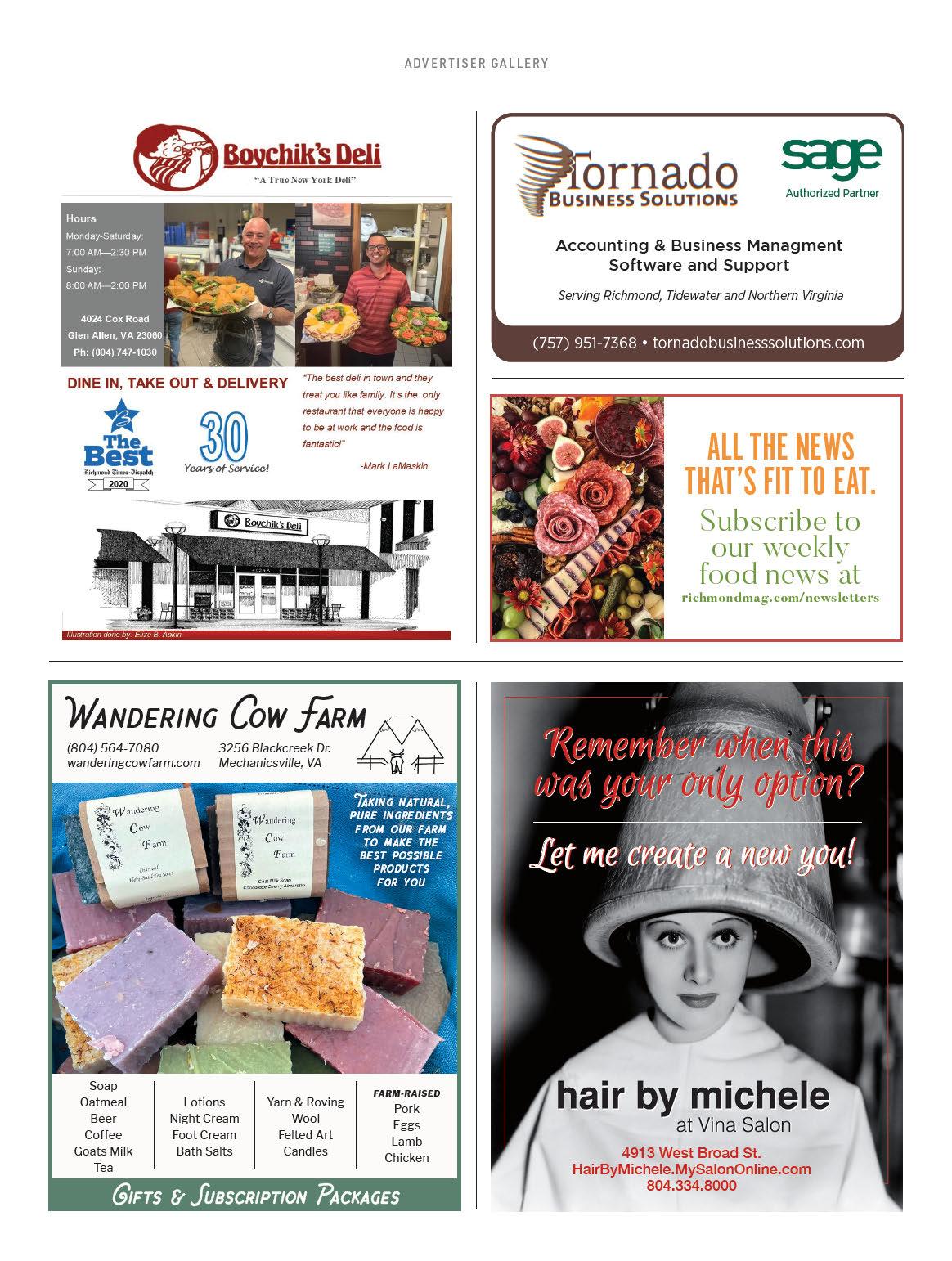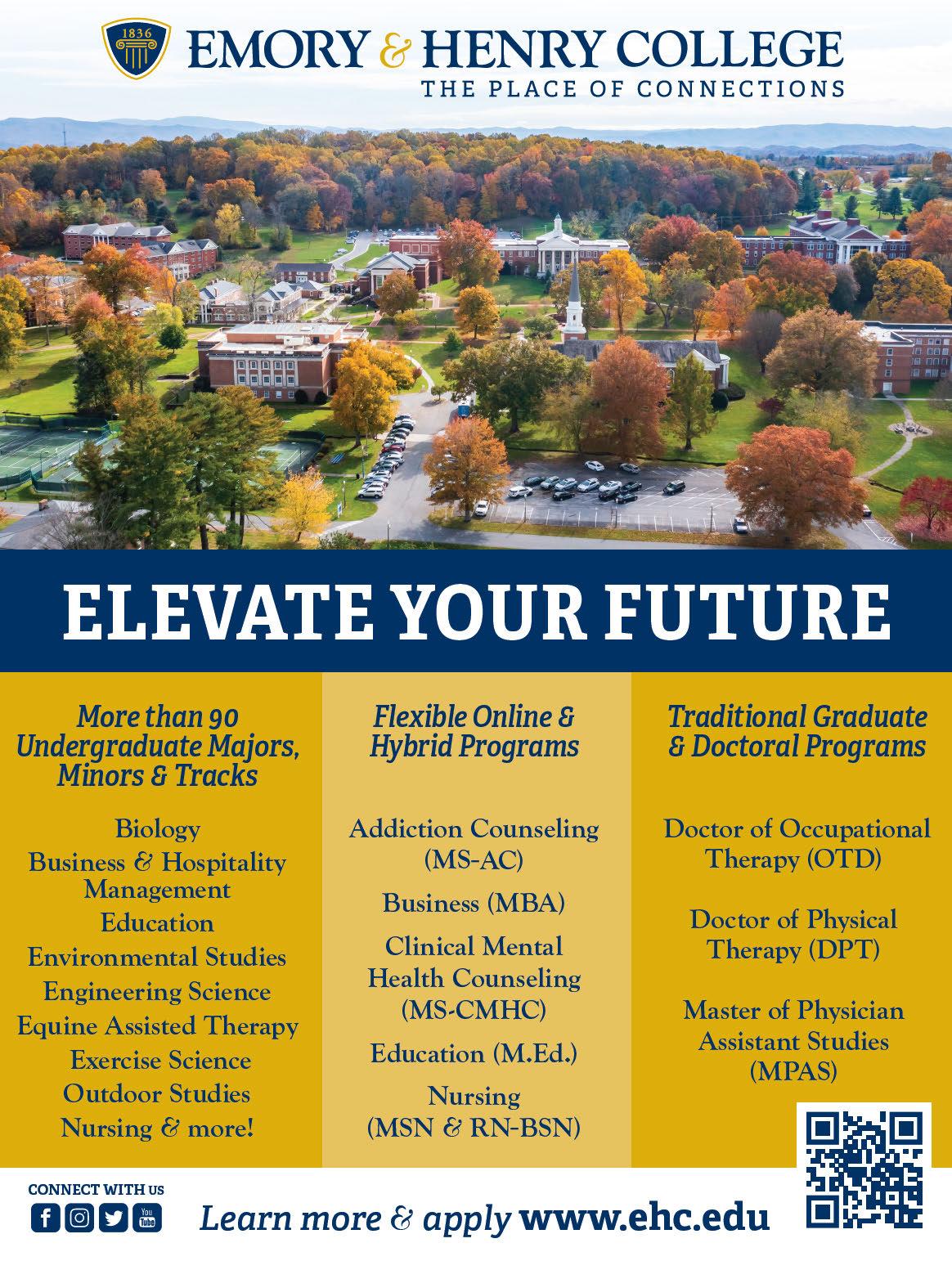




February 26, 1960 –
August 25, 2023
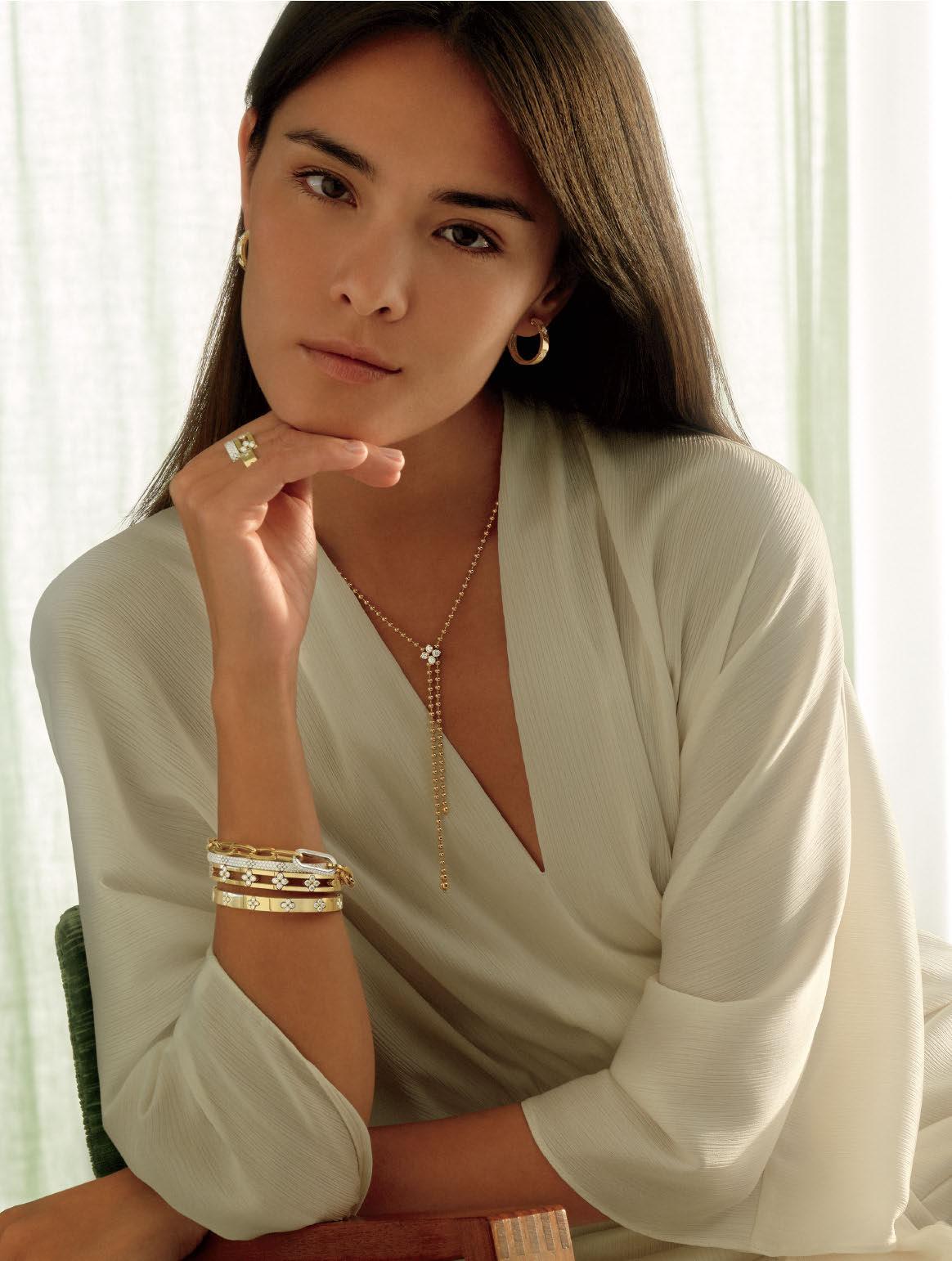
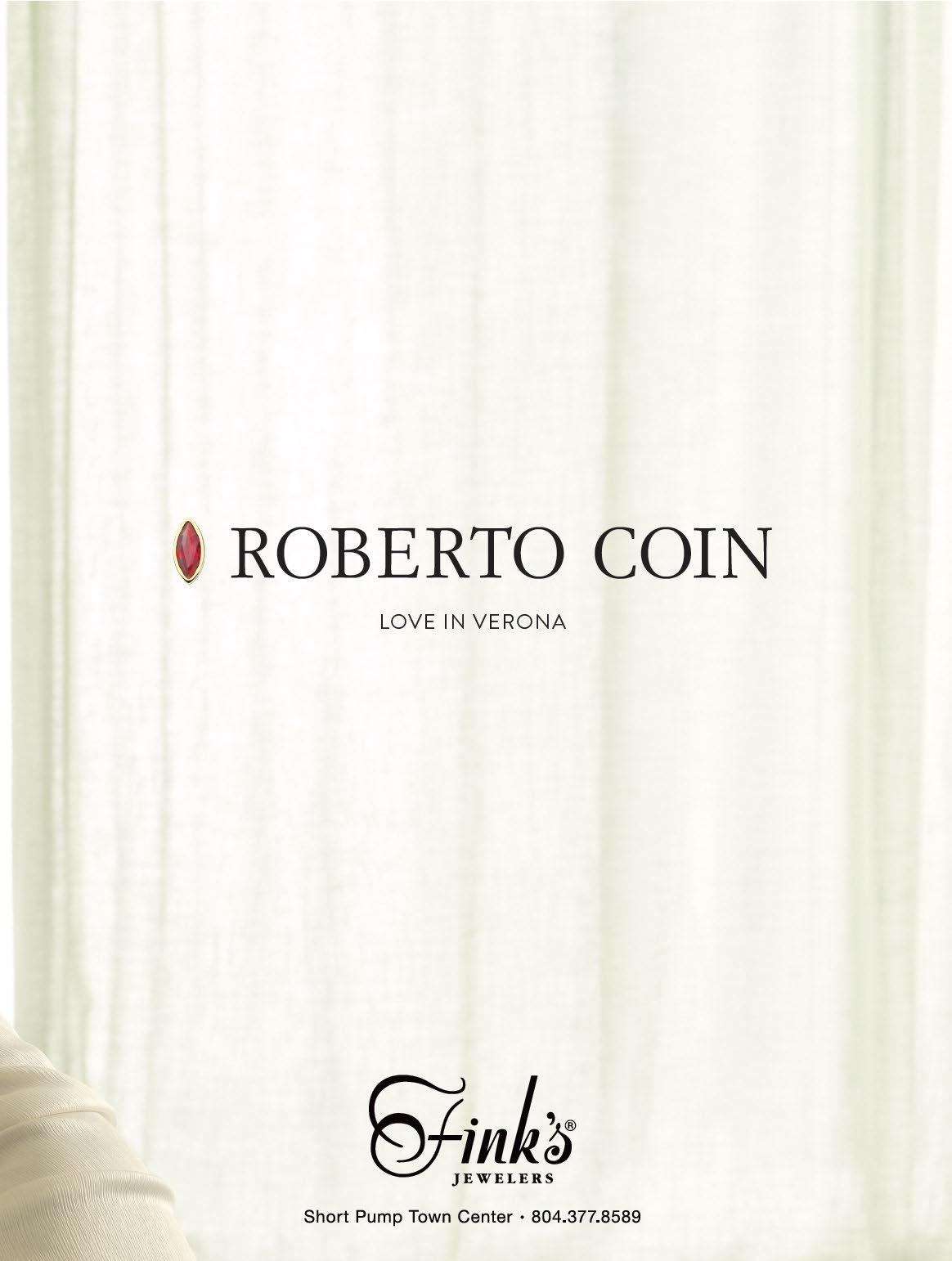

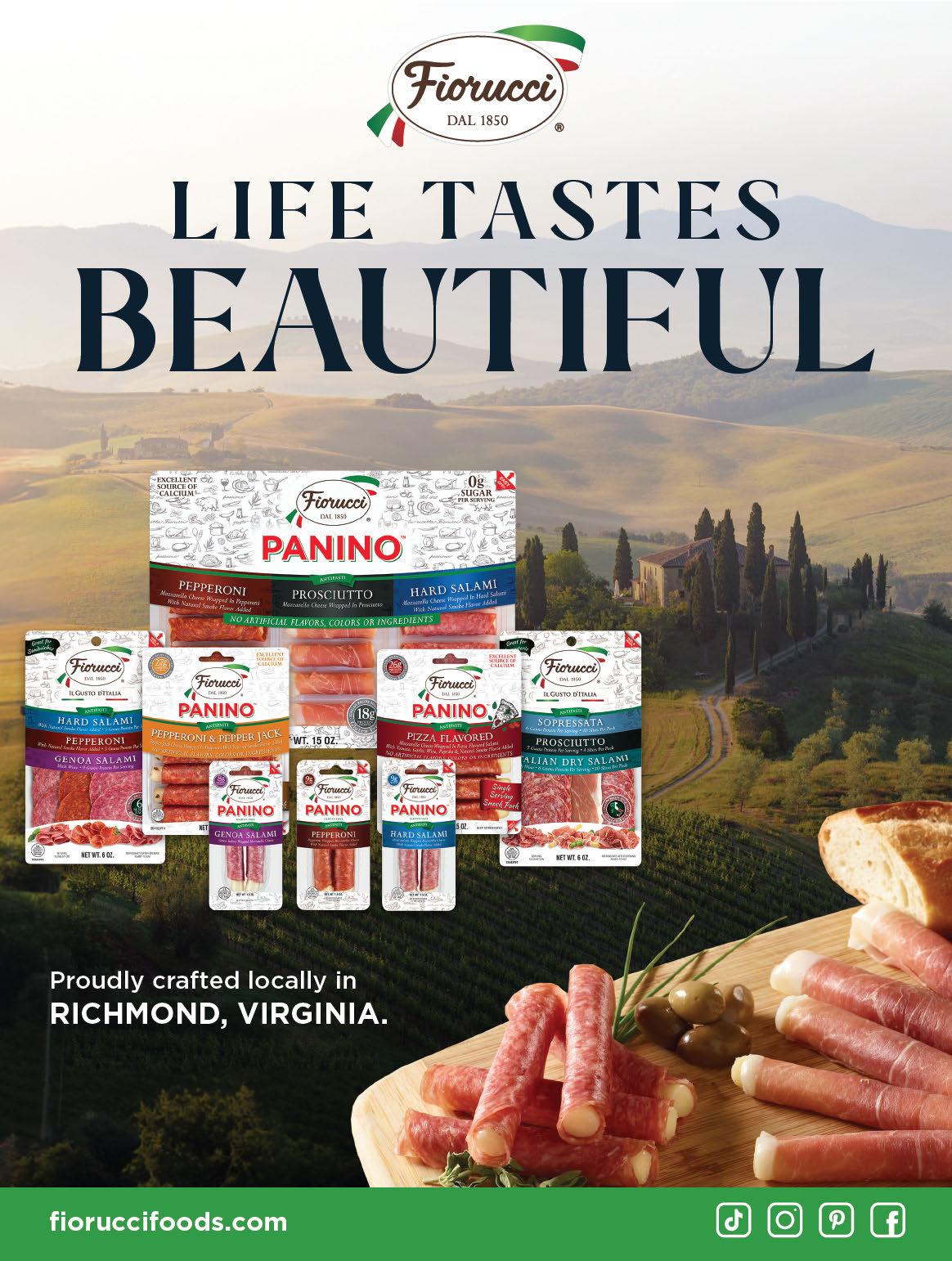




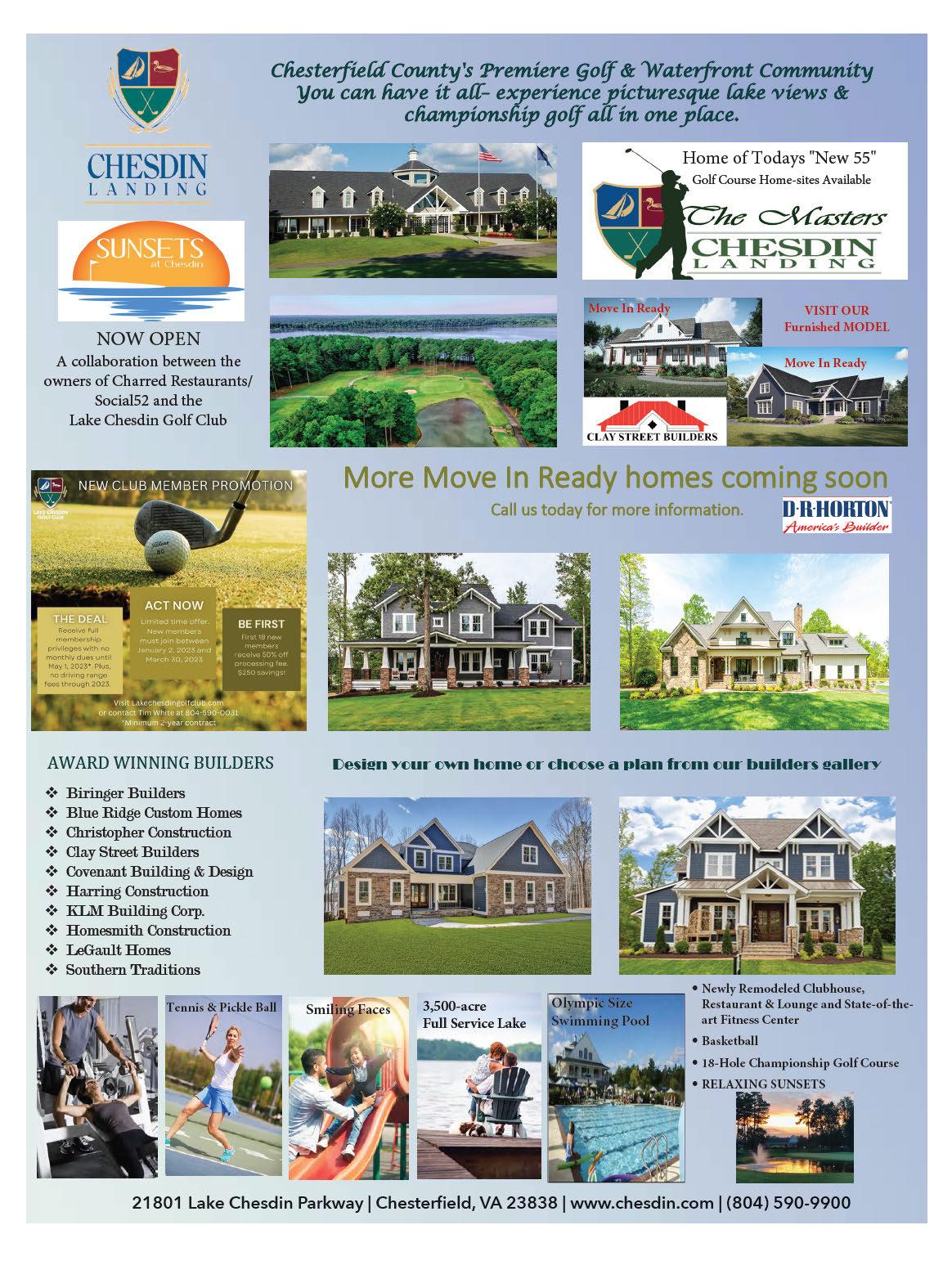

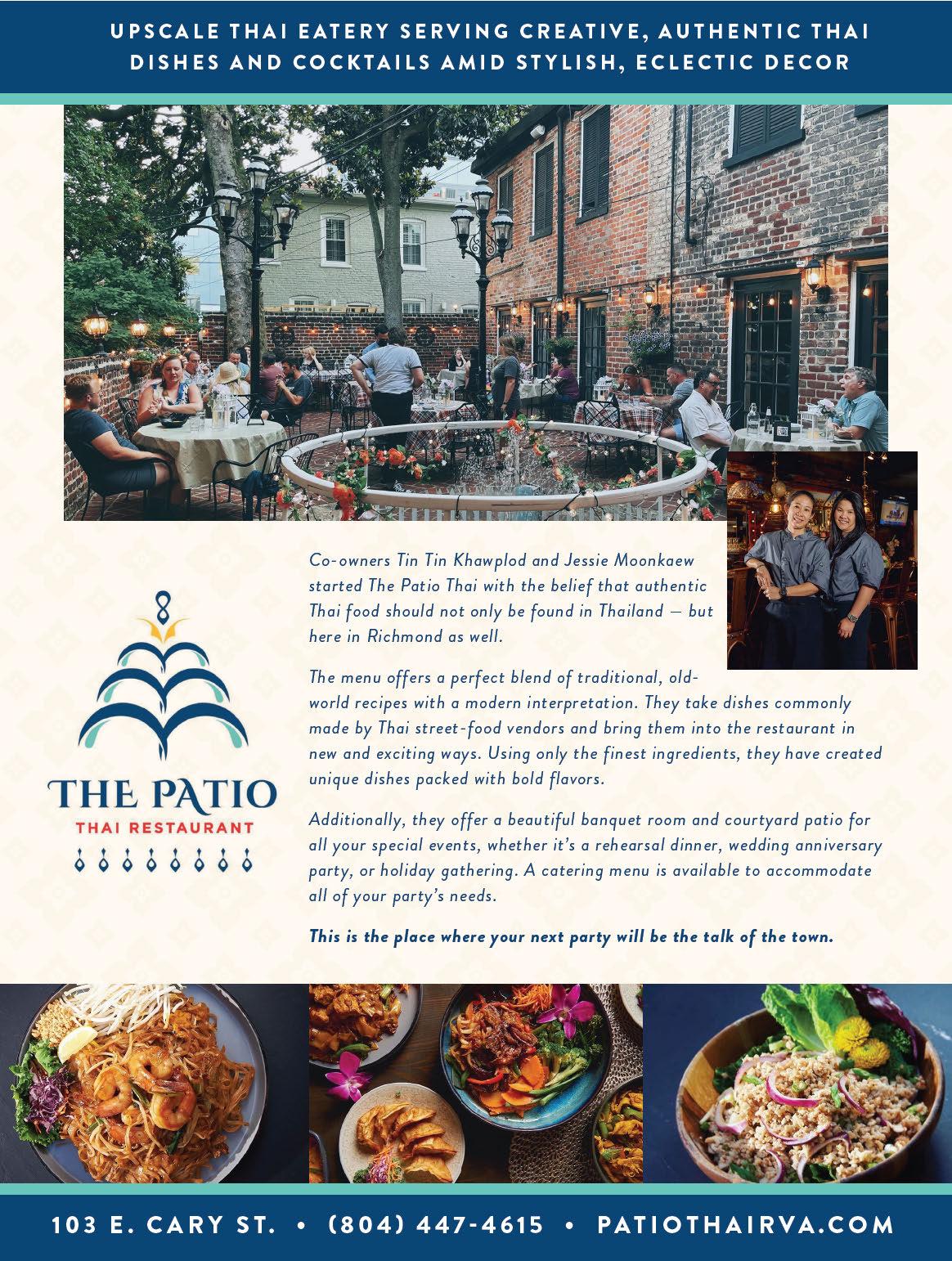
Read the first chapter of “Burn” by Alexis Stratton, winner of James River Writers’ and Richmond magazine’s 2023 Best Unpublished Novel contest
Poet Nikki Giovanni embraces her contradictions
By Claire Fortier
Teaching is more challenging than ever — but opportunities abound
By Laura Anders Lee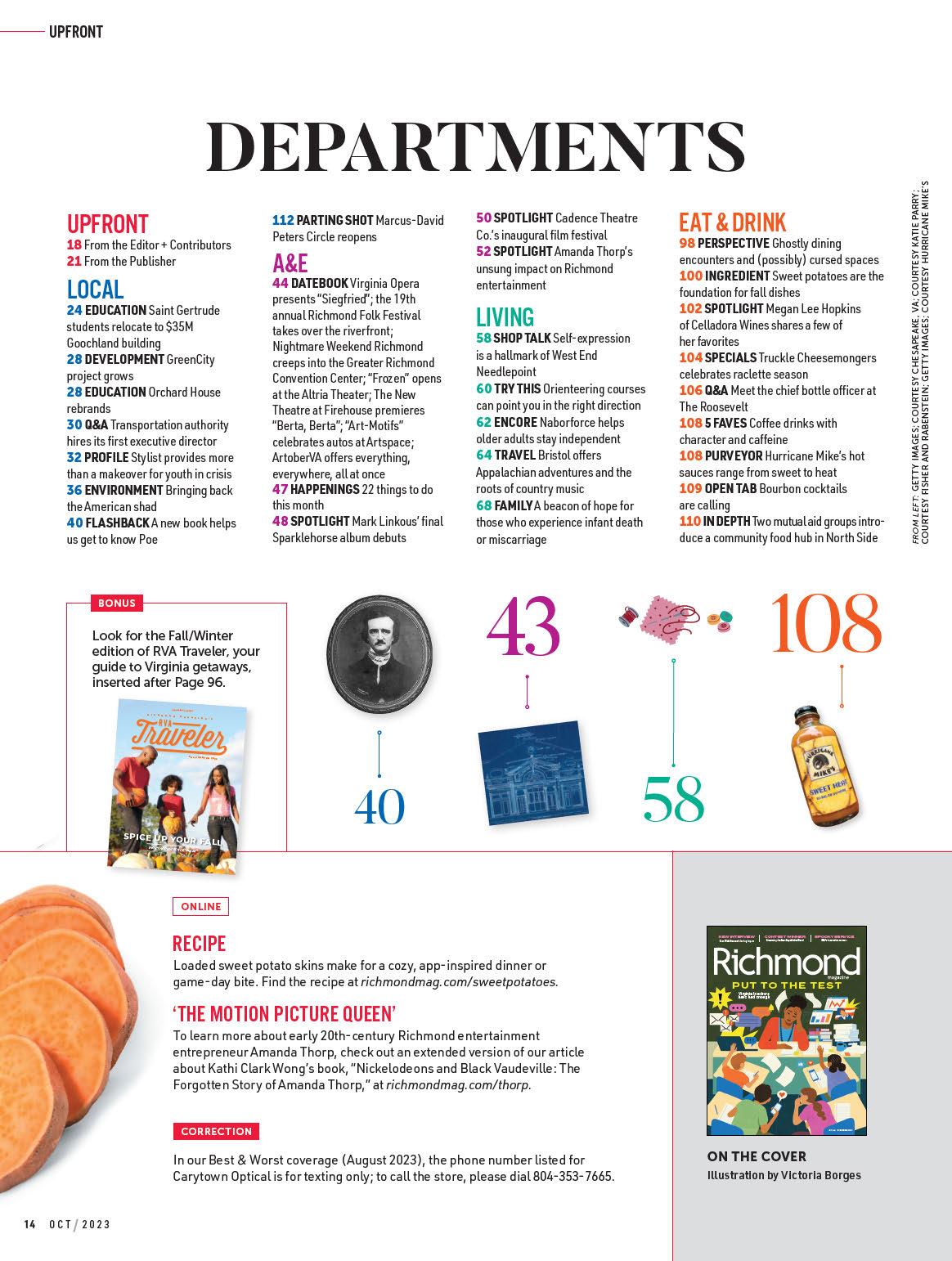

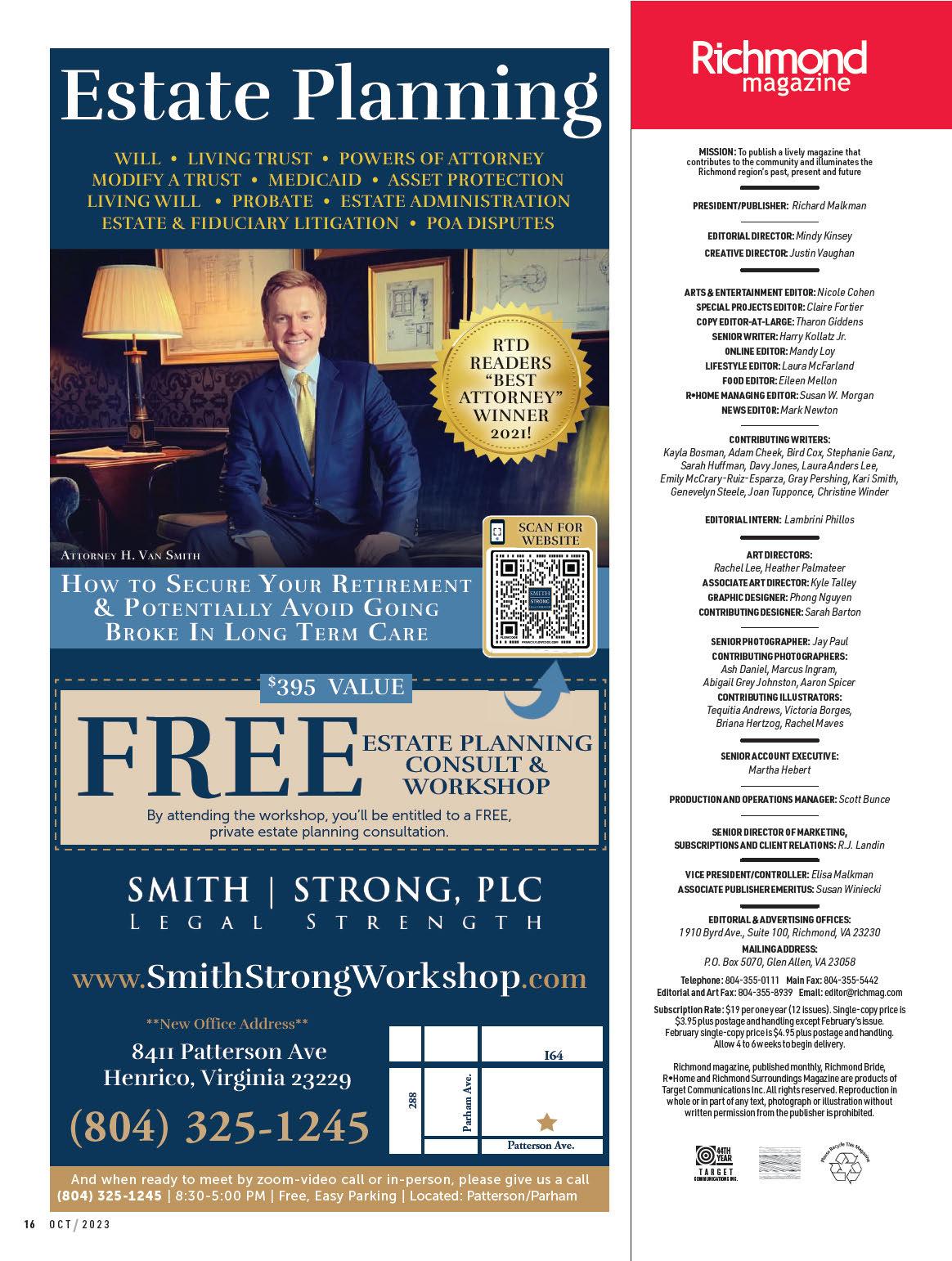

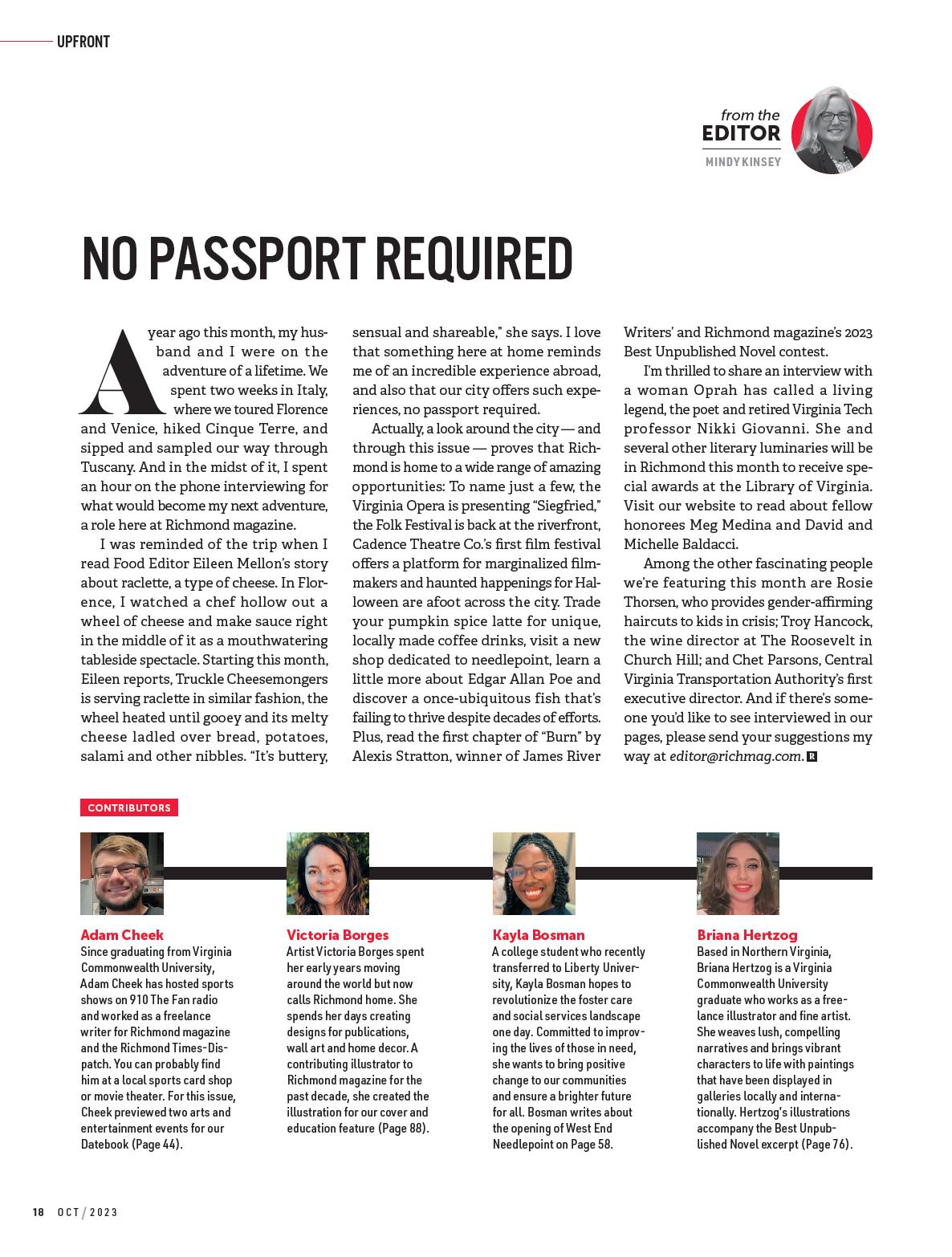

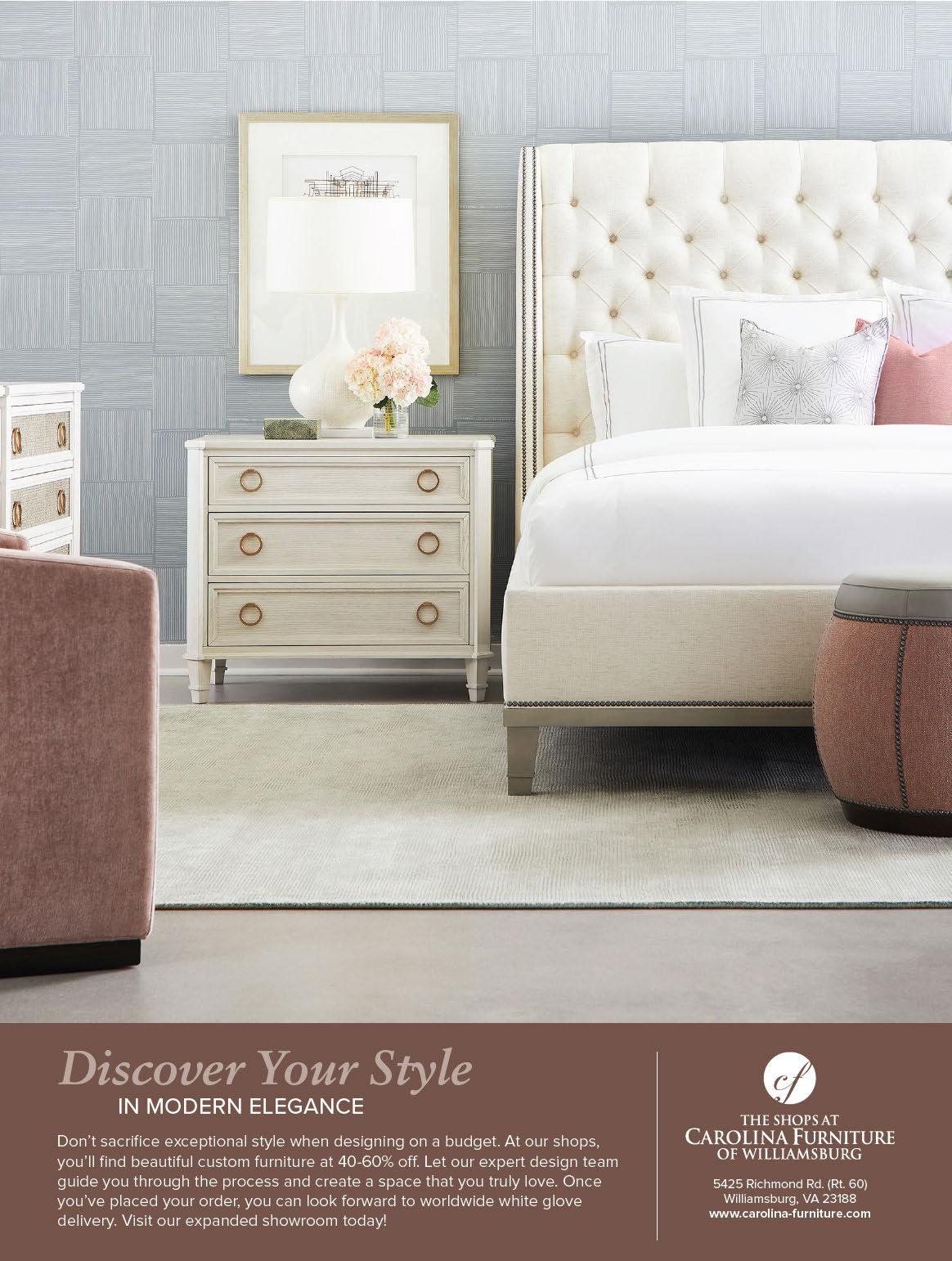
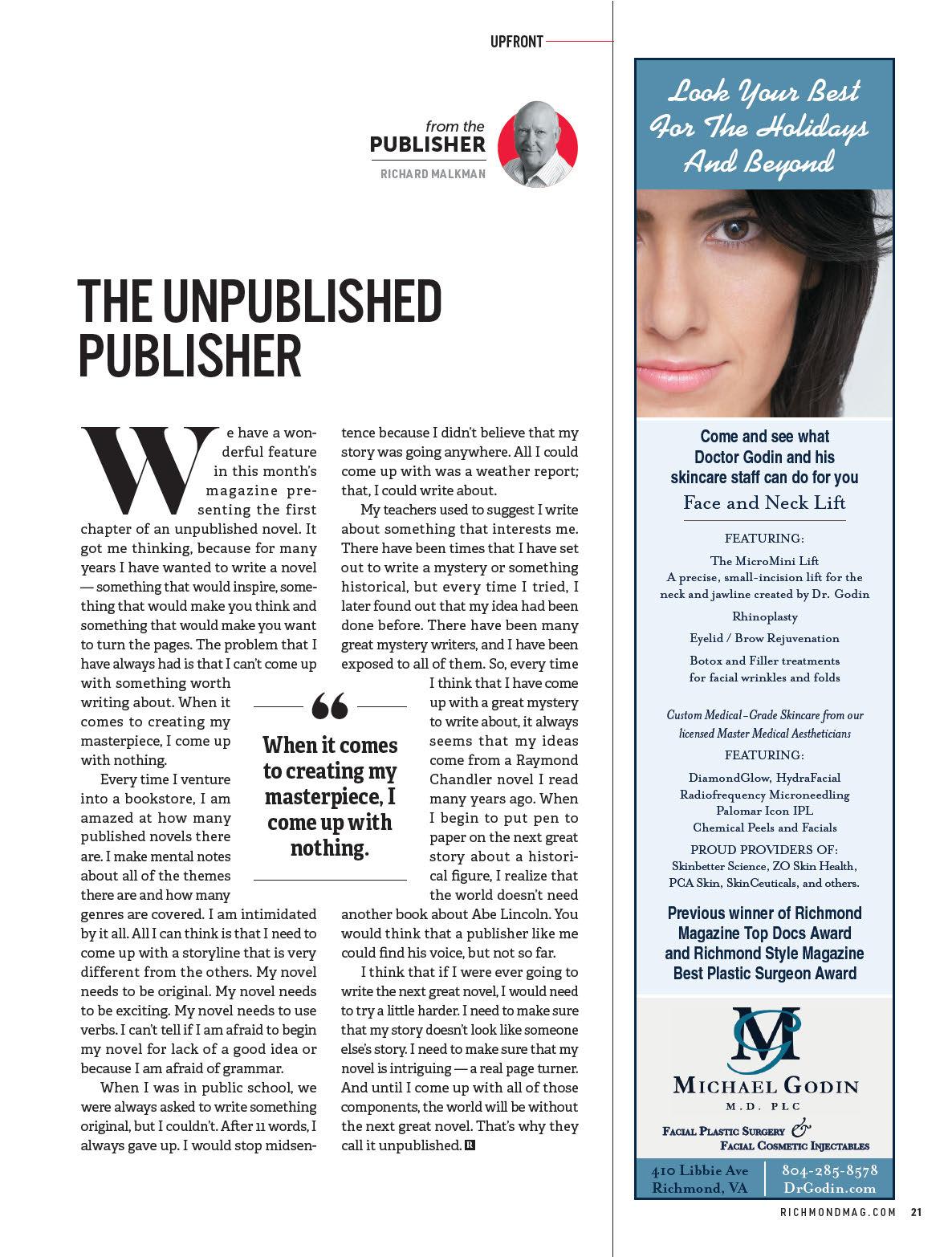
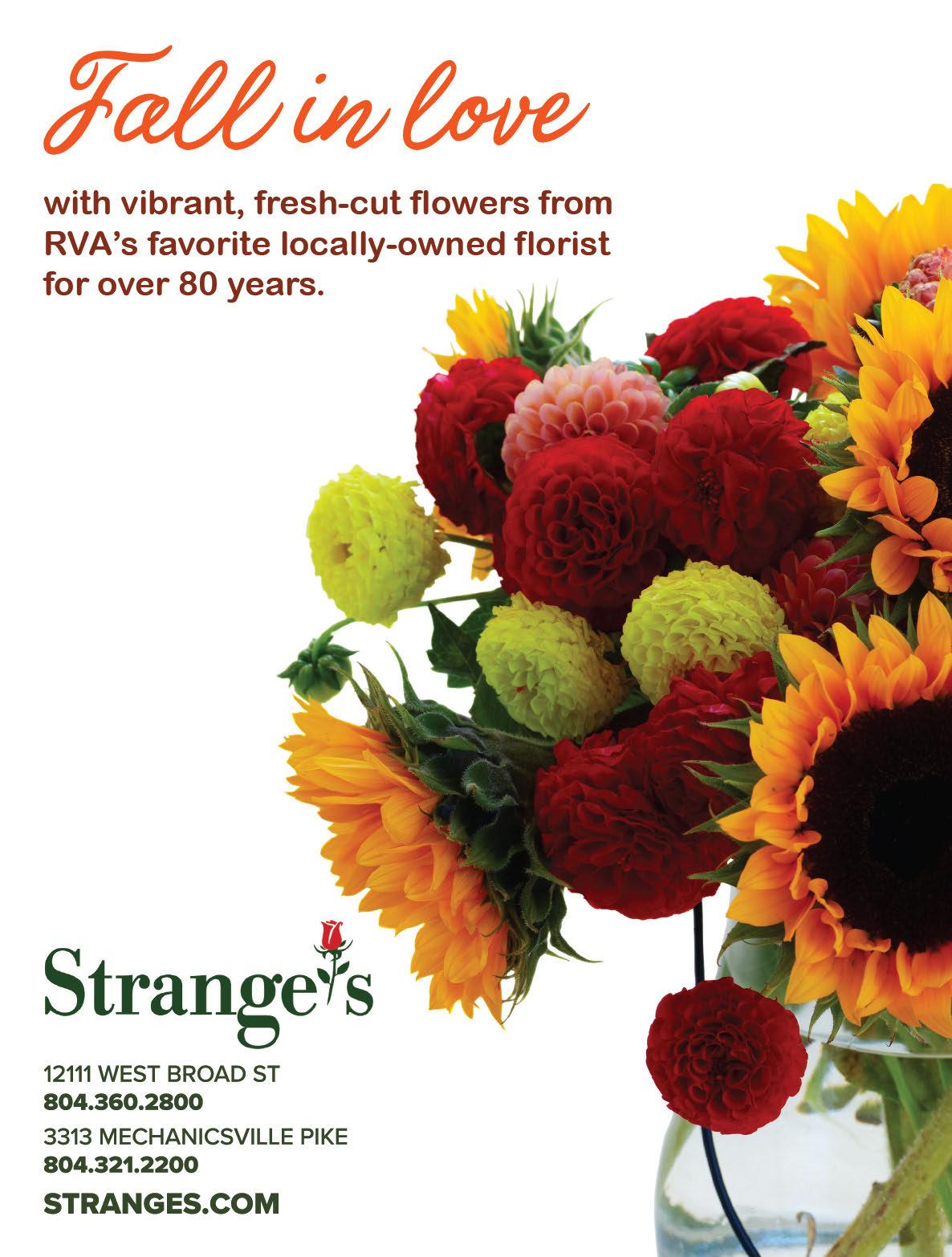
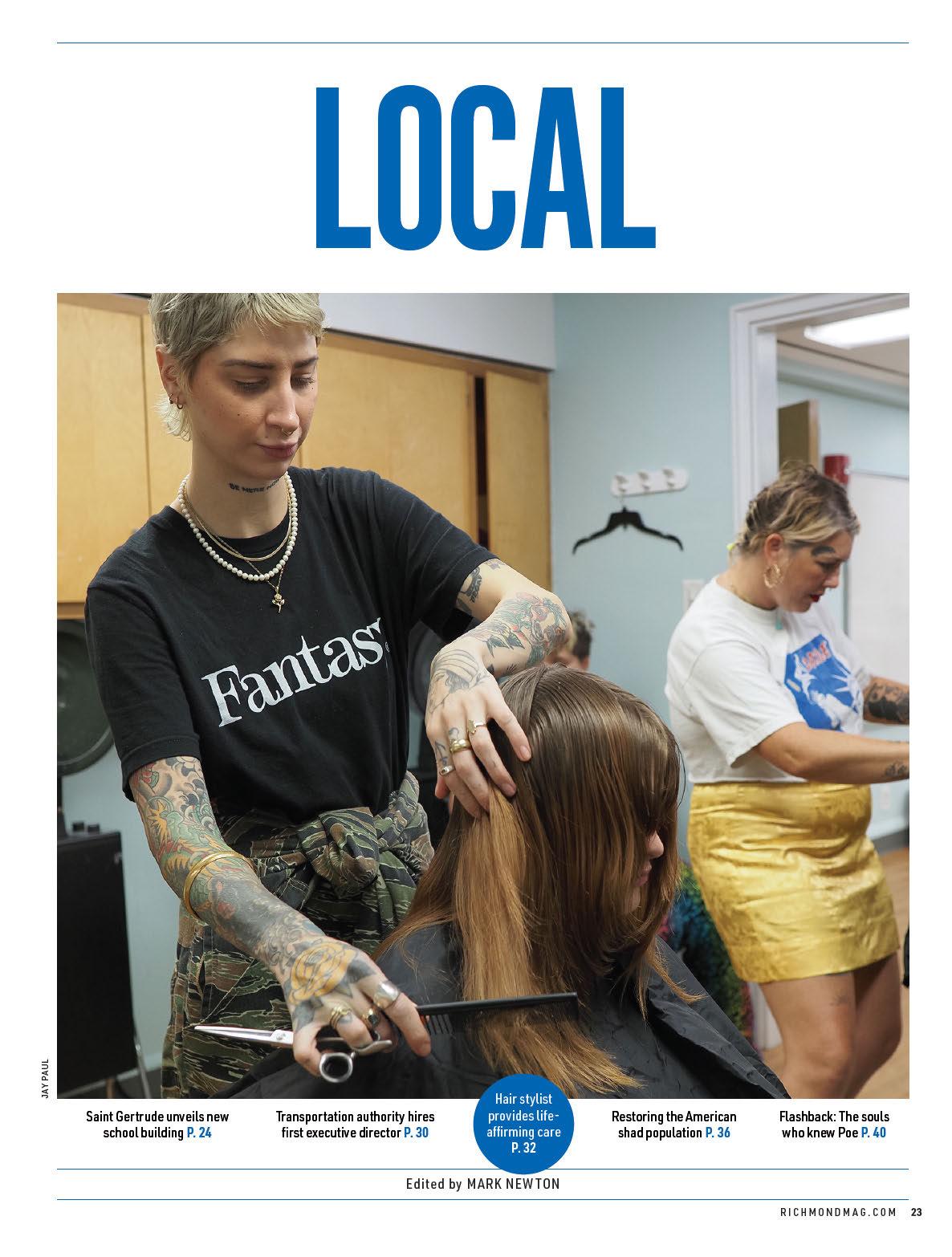






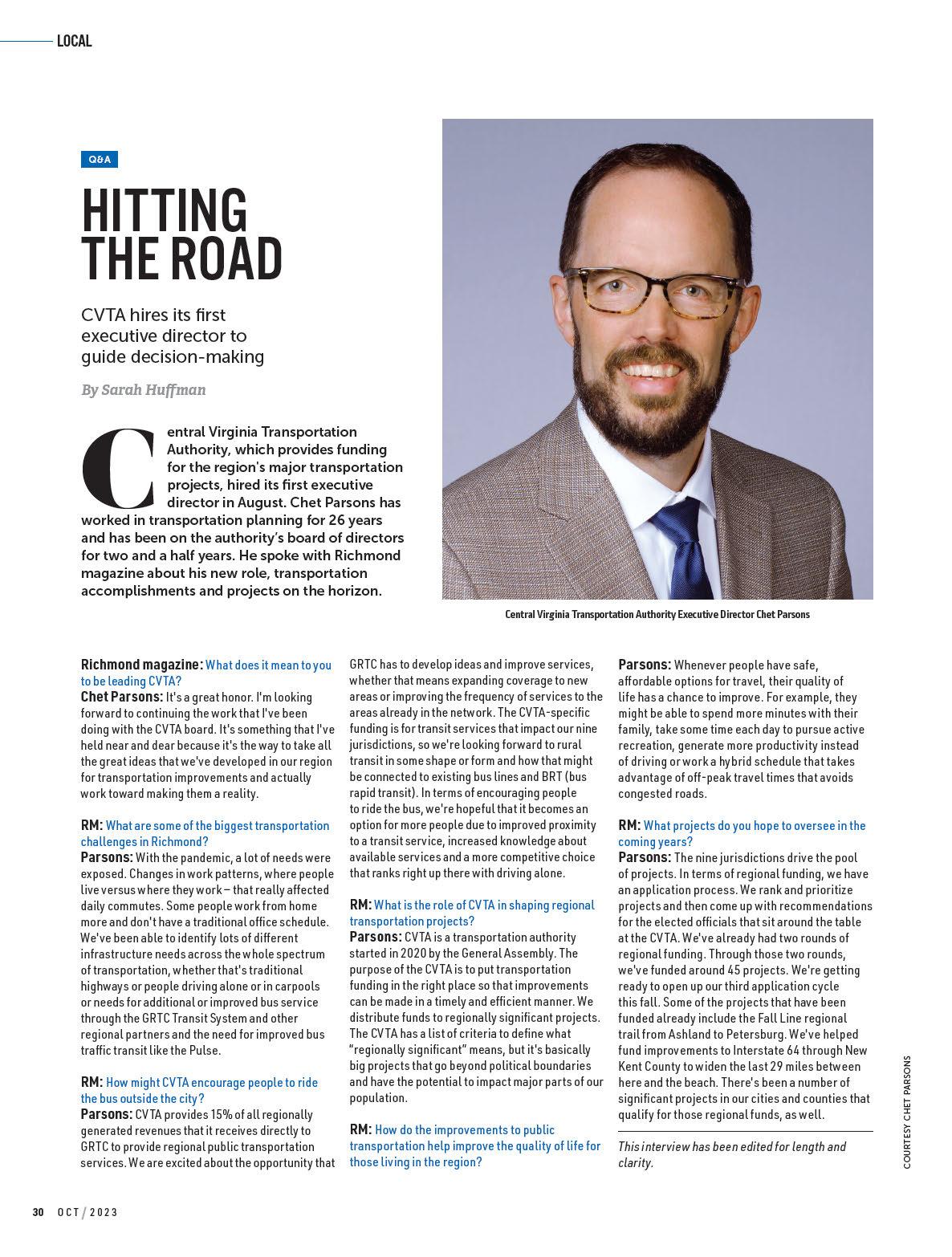

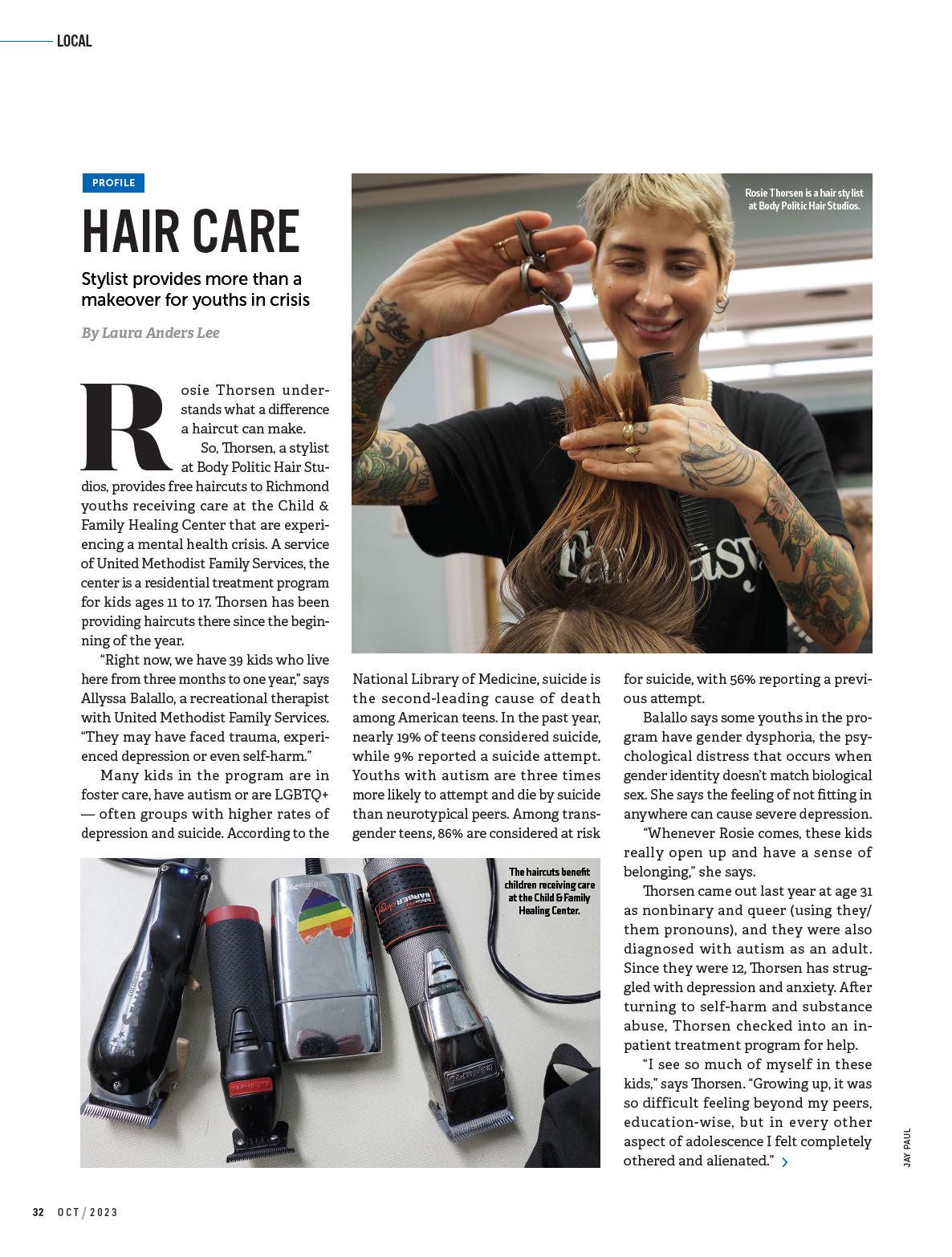








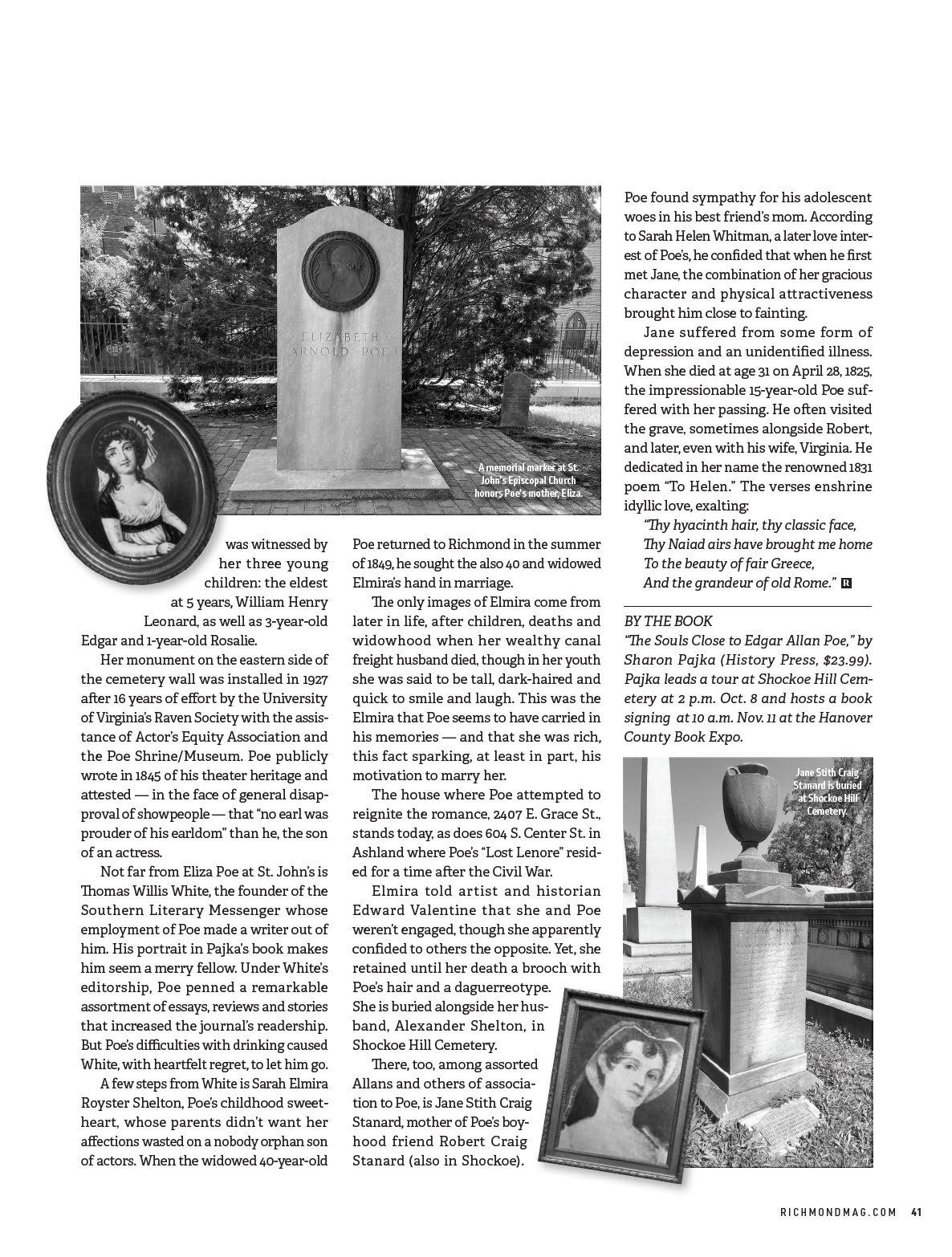

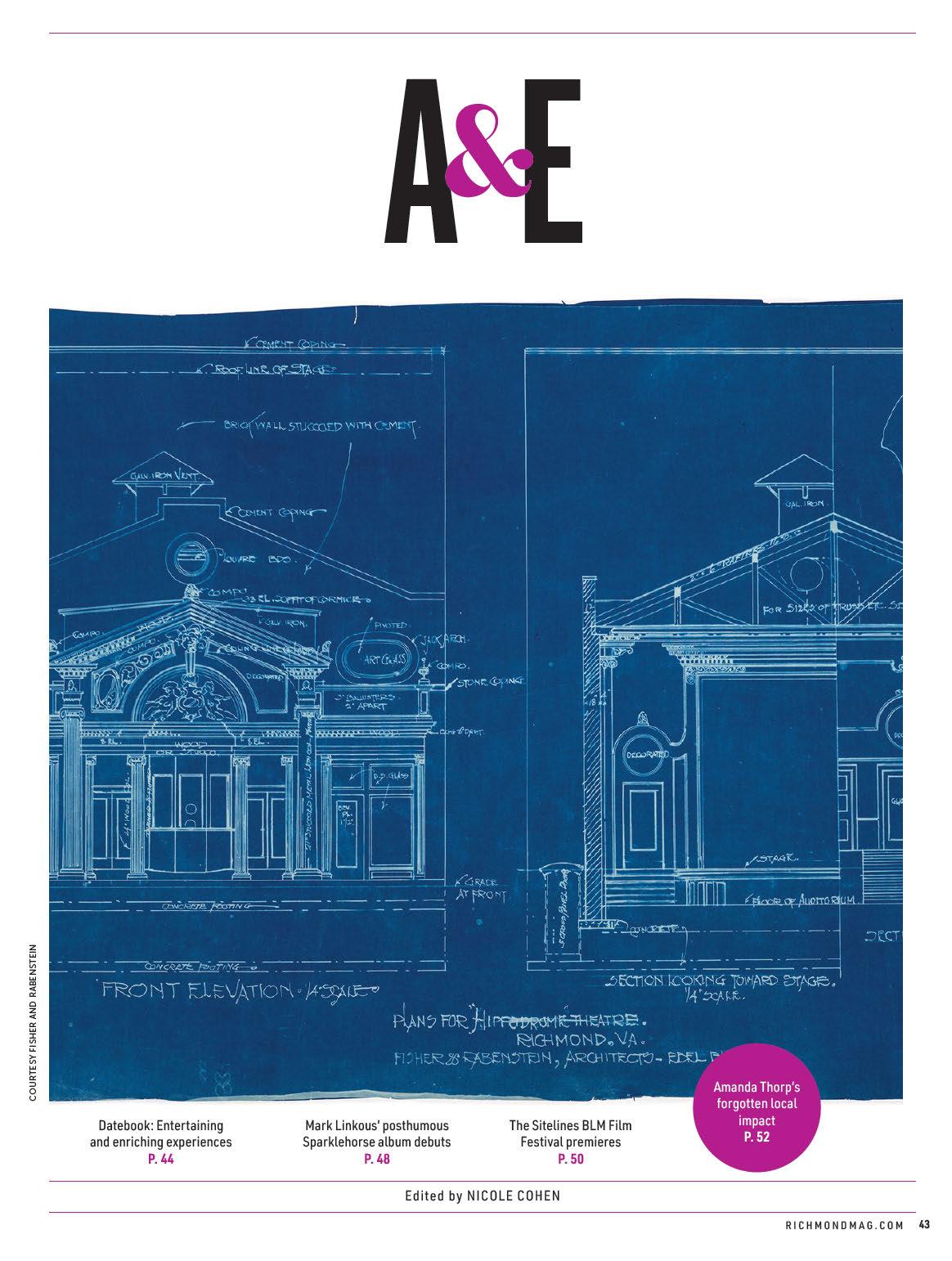
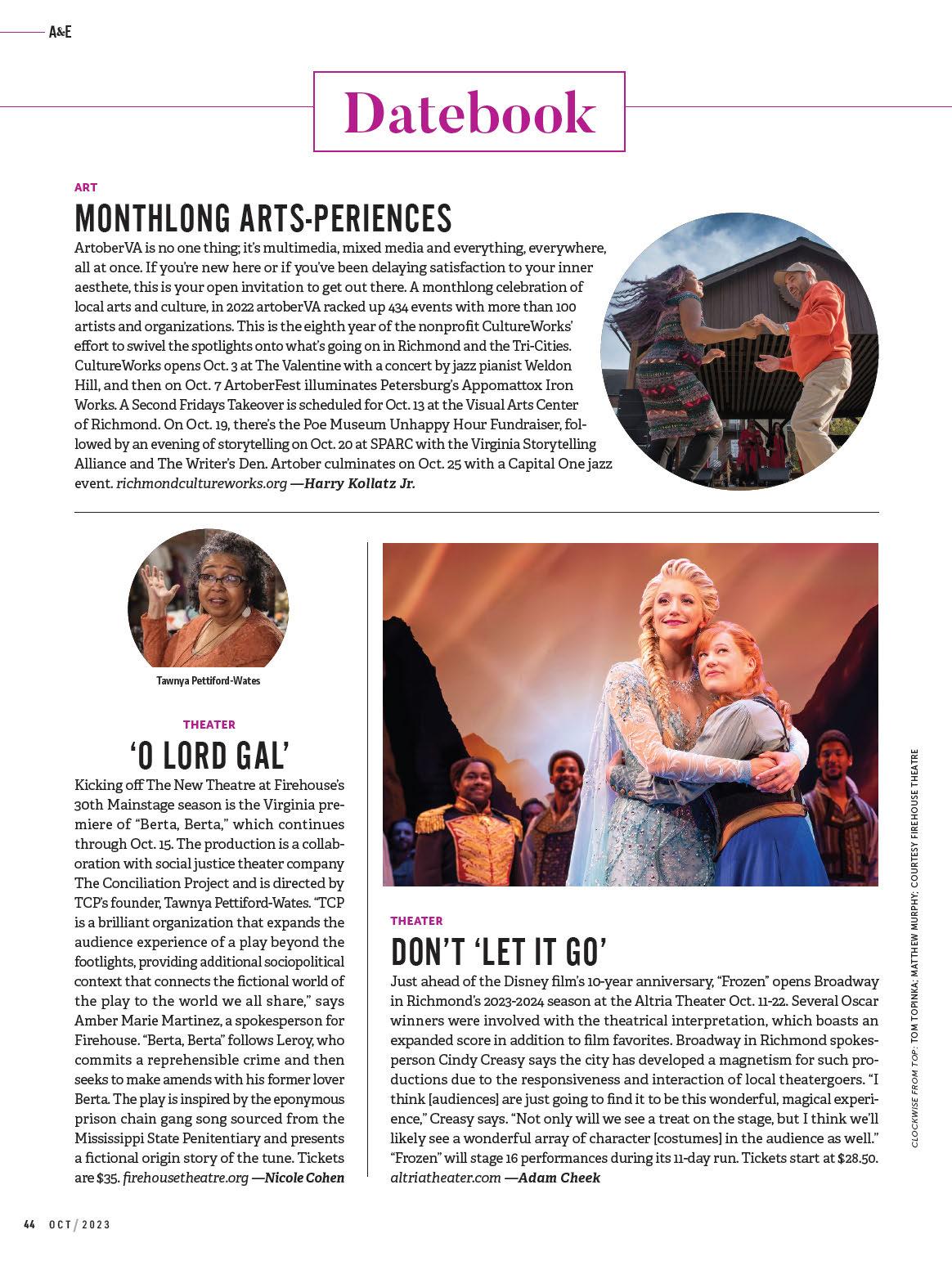
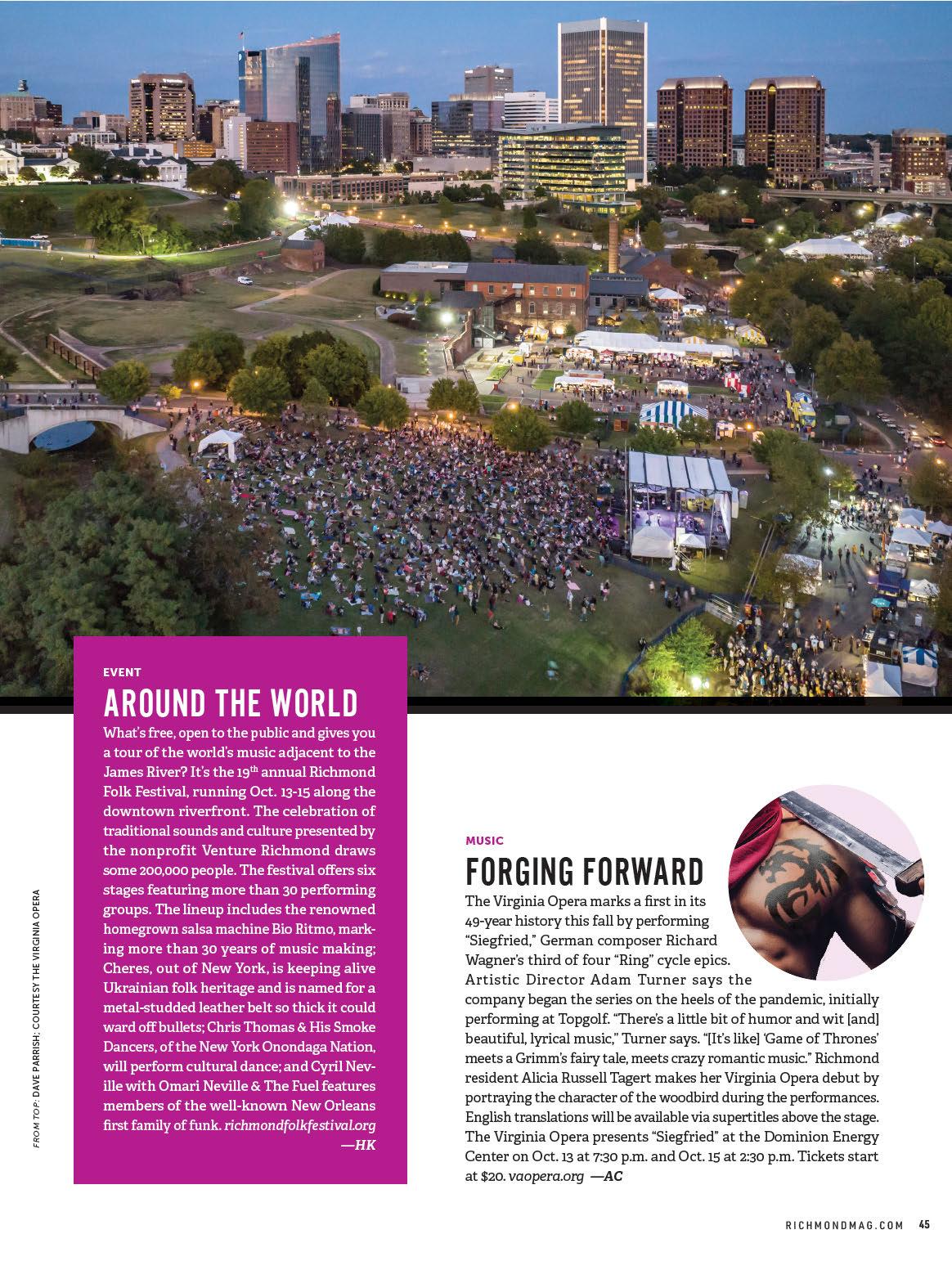




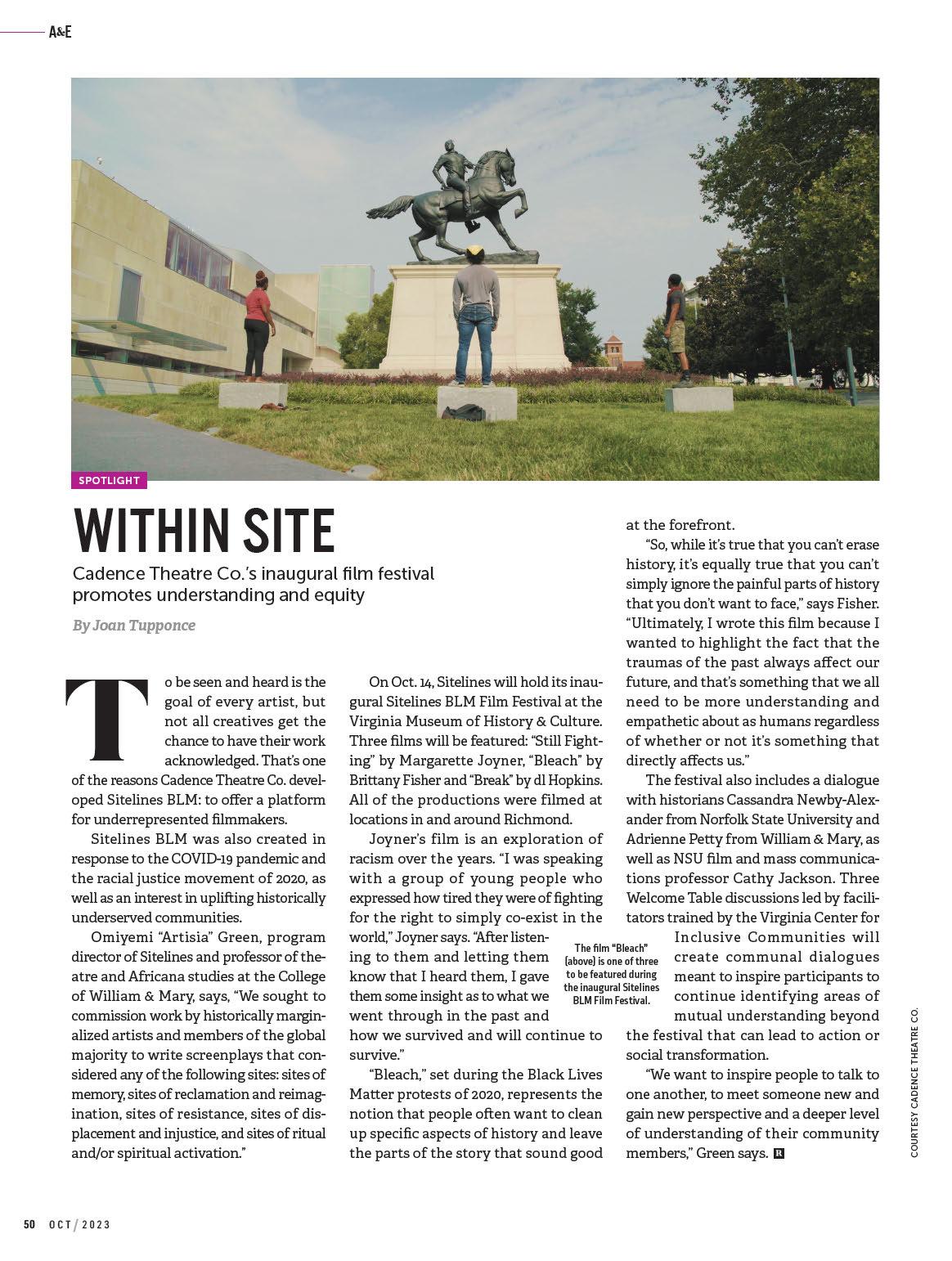
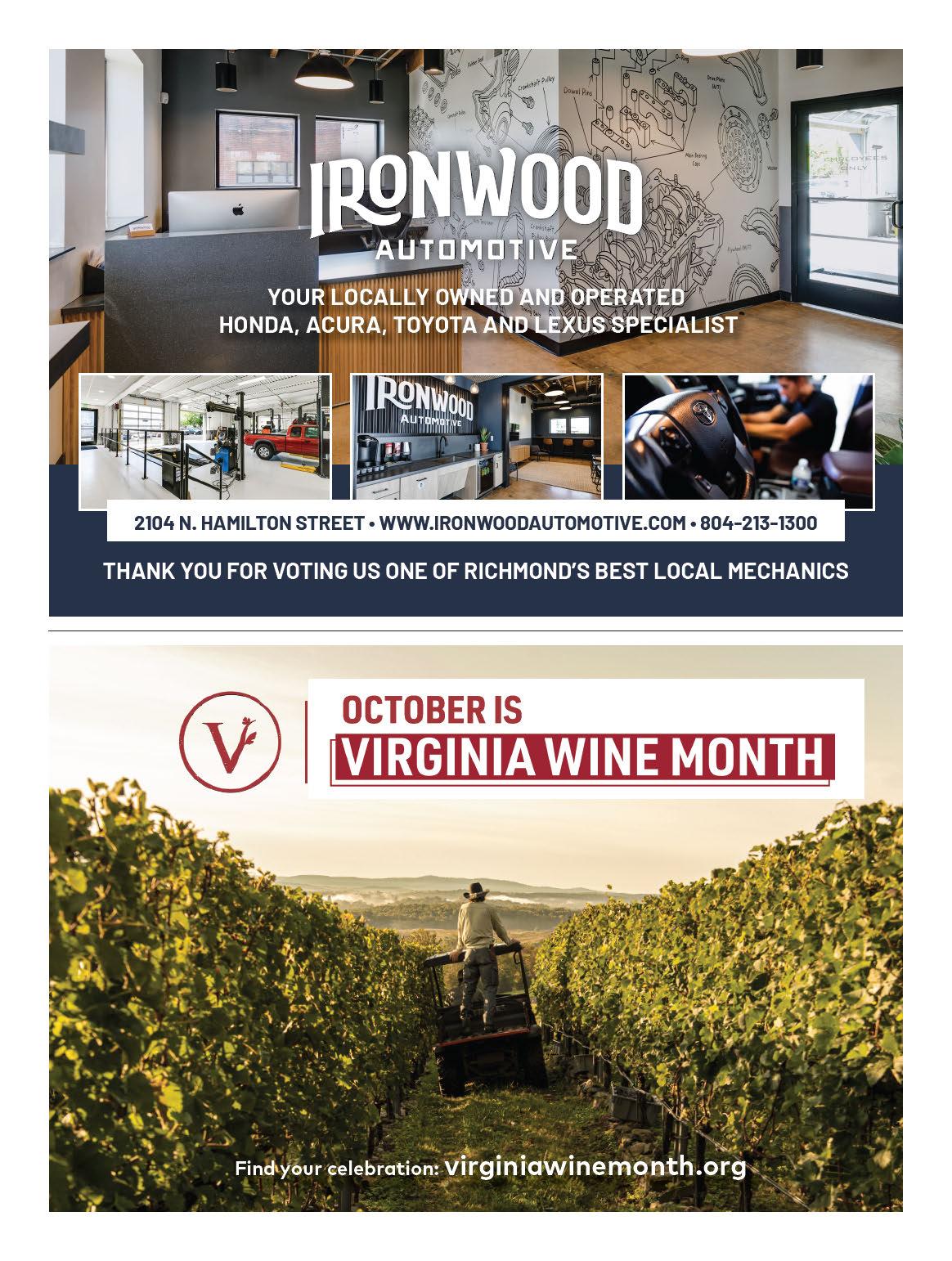
Kathi Clark Wong didn’t set out to write a biography of early 20th-century Richmond entertainment entrepreneur Amanda Thorp.
Wong didn’t know that she’d end up mining a previously unexplored vein of local history any more than Thorp knew she would enter the Richmond arts industry upon a 1907 visit to the city. Thorp realized nobody in the area was
showing motion pictures yet as she did in Bucyrus, Ohio, using a converted storefront she called Wonderland. That epiphany led Thorp to open the Dixie, Richmond’s first permanent indoor movie house, as well as the Rex a few doors down, and theaters called Bluebird in both Richmond and Petersburg; she also bankrolled the original Hippodrome in Jackson Ward.

Wong and her husband, George,
moved here five years ago from Knoxville, Tennessee. “We were looking for a retirement place and we went around like you’d look at colleges with your kid,” she recalls. She’d visited Richmond 40 years prior and was unimpressed, but she discovered a revitalization in the city that matched their expectations in terms of culture, the James River, the food and architecture.
Her background includes newspapering in Monticello, Arkansas, teaching and a driving curiosity. In 2019, a house history for a Monumental Avenue neighbor transformed into a long story about a short street. The detailed monograph, “Building A Neighborhood,” also records the construction career of George Mancos Jr.
Browsing the “Old Images of Richmond” Facebook group, she came across a query by the new owner of 18 W. Broad St. who, without knowledge of the space’s history as the Dixie, named her business The Sideshow Gallery and Residences. Wong messaged the owner, Jennifer Raines. “I told her I’d poke around and see what I could find,” she says with a brief laugh. “And so I say I accidentally wrote a book.”
Her “Nickelodeons and Black Vaudeville: The Forgotten Story of Amanda Thorp,” published by the University of Tennessee Press, follows a novel’s worth of real-life characters during the rambunctious infancy of movies and the b urgeoning of vaudeville amid Richmond’s particular divisions of race and class. Wong sought an academic press because she realized the new ground she’d come into. “I was busting some myths,” she says, while not wanting the narrative to sound pedantic. Her lively style and concern for detail make the book an intriguing glimpse into Richmond in a time not o en studied.
Thorp arrived here a middle-aged white woman from Ohio without much but pluck and a sense for opportunity. “She had no training in business,” Wong


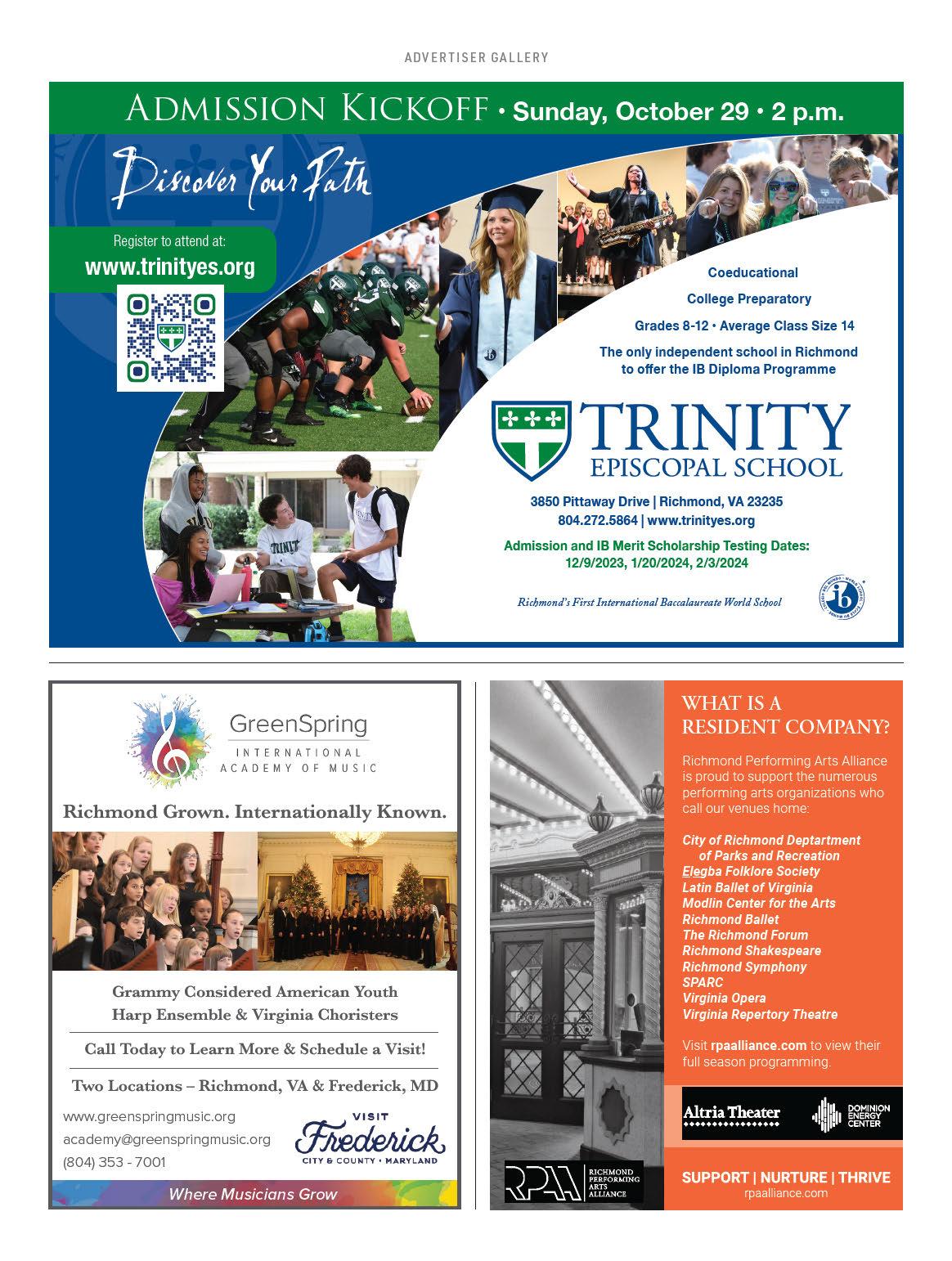

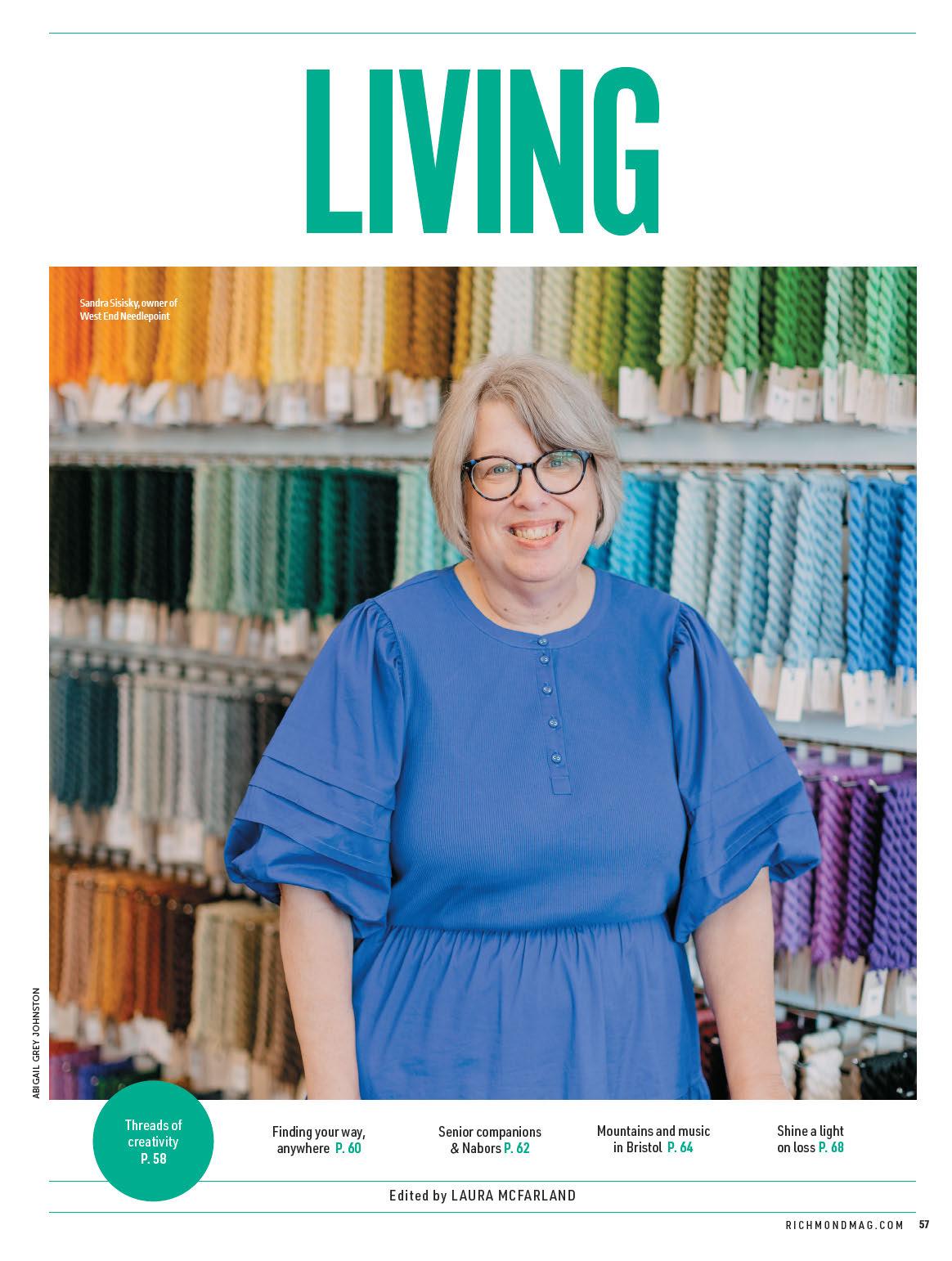


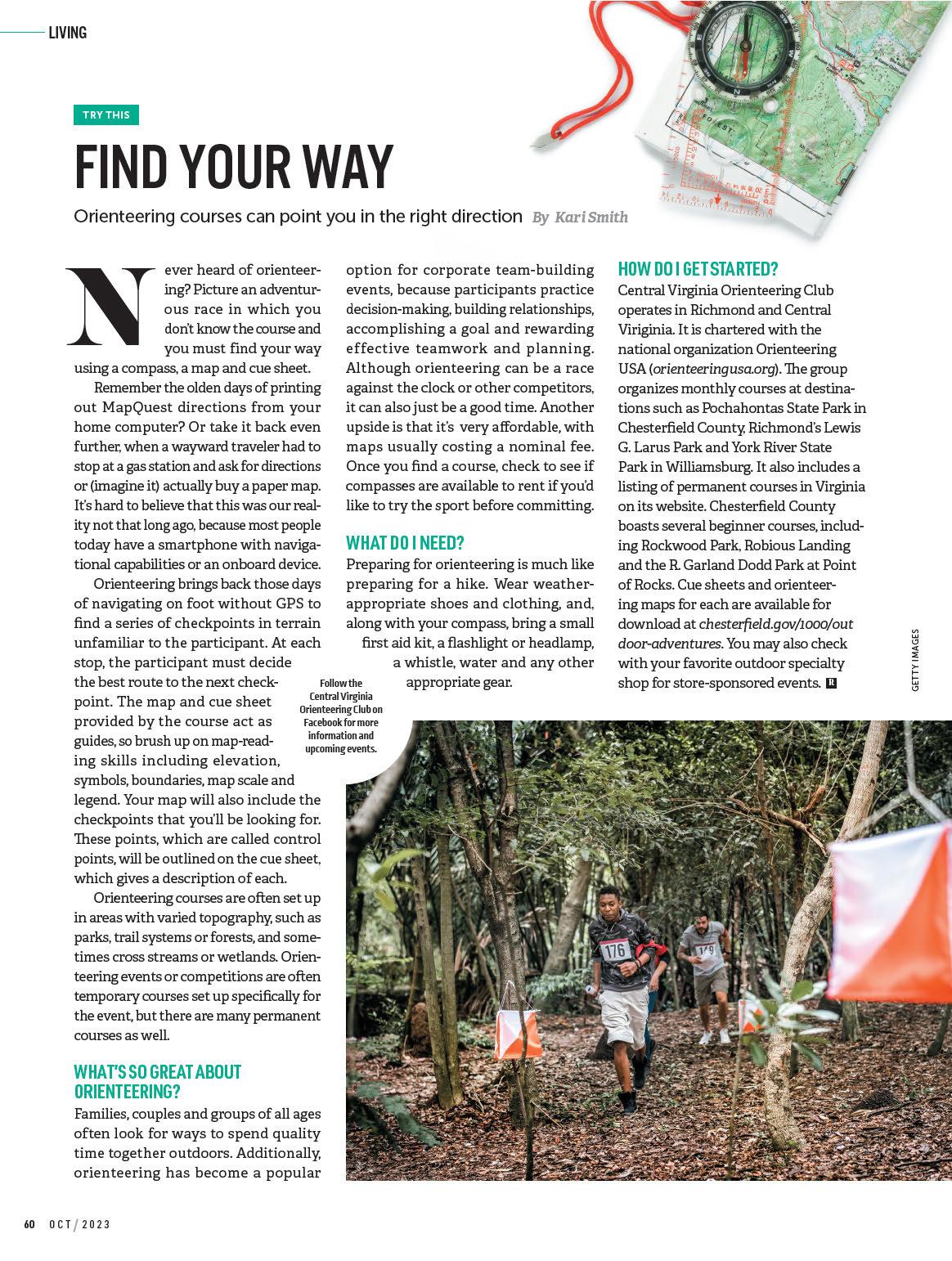
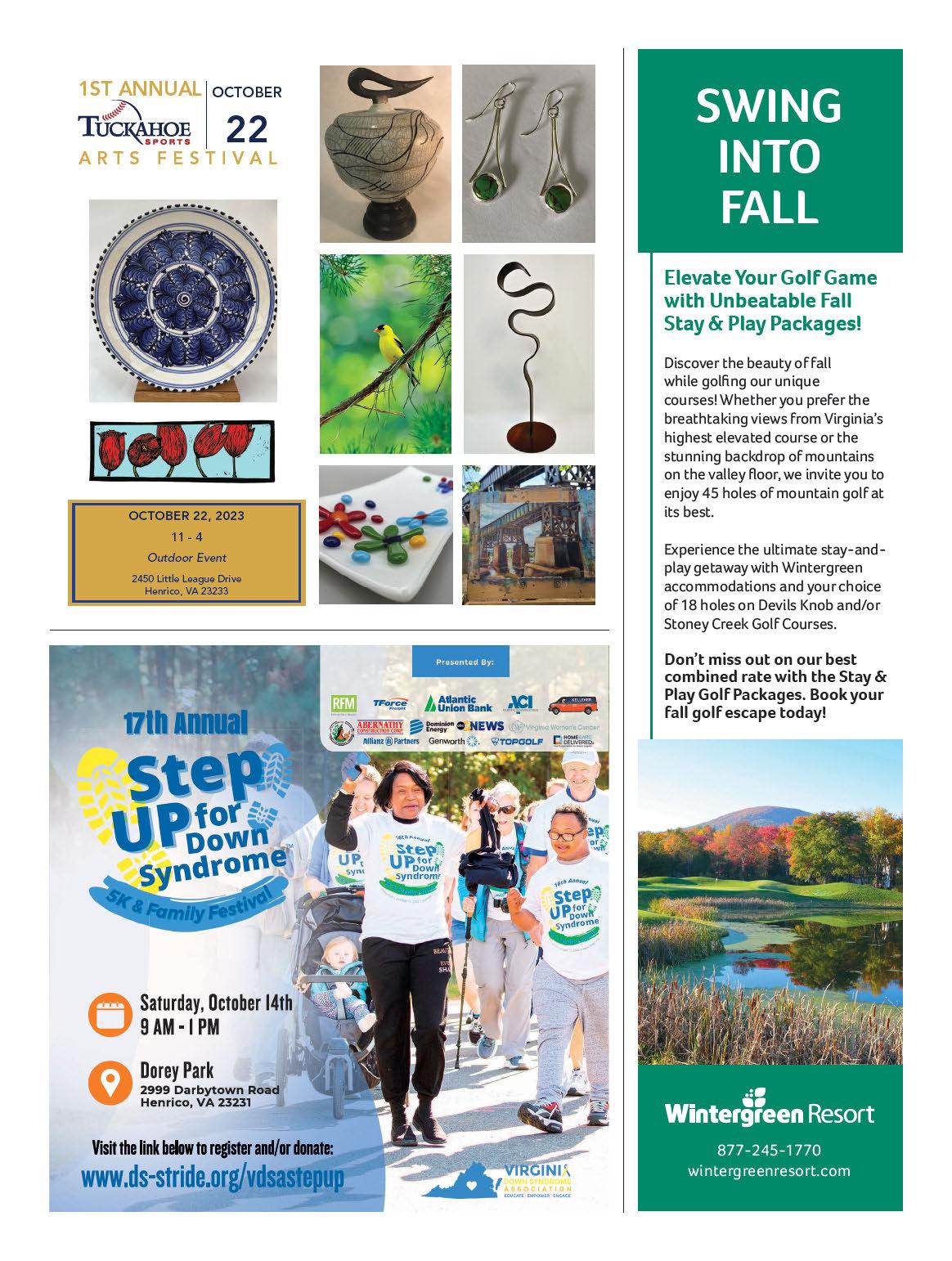
It’s the simple things Joan Collins misses — driving, looking over the labels at grocery stores, reading her mail.
A worsening eye condition has made it impossible for the 92-yearold Richmond woman to do those tasks, chipping away at her independence. “I couldn’t do anything. I would have to have somebody to take me to the store or doctor’s appointments or anything. I do not call on my family, because they are busy, also,” Collins says.
In 2021, a friend recommended Naborforce (naborforce.com), a service that matches clients with helpers known as Nabors, who can literally be the extra set of hands, or in this case eyes, that they need.
It was a perfect fit for Collins. Four hours a week, a Nabor comes to Collins’ home to assist with tasks such as grocery shopping, driving or working around the house.

Since spring 2022, Collins’ helper has o en been a fellow Richmonder, Barb Overstreet. The death of O verstreet’s husband in 2021 le a void in her life. Several months later, she became a Nabor, wanting to do something meaningful with her time but, at 76, not wanting a more structured job.
Naborforce doesn’t guarantee that a particular Nabor will be assigned to a client, but sometimes it works out that pairings become more regular. Overstreet helps Collins and a man who lives in an assisted living facility and says she gets just as much out of the weekly visits as they do. “It gives me some purpose.”
When founder and CEO Paige Wilson envisioned Naborforce, she had clients and Nabors like Collins and Overstreet in mind — older adults in generally good health who need a helping hand to age in their homes and motivated, helpful people who may want to make a li le money.
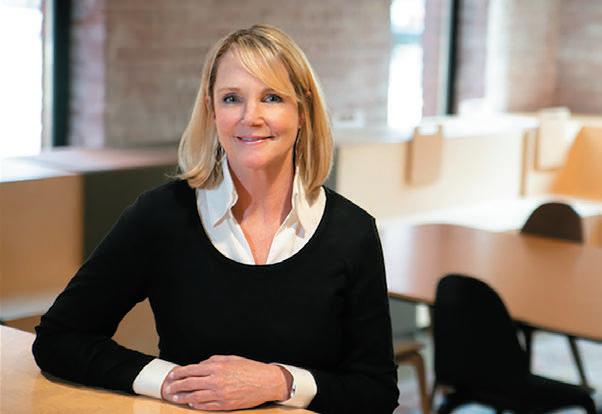
Helping someone can take the form of sorting through correspondence, changing a smoke detector, cleaning out a closet, taking items for donation, shopping for gi s or just si ing and talking. Health care assistance isn’t an option.
“The No. 1 activity or task we do is meal prep,” Wilson says. “It

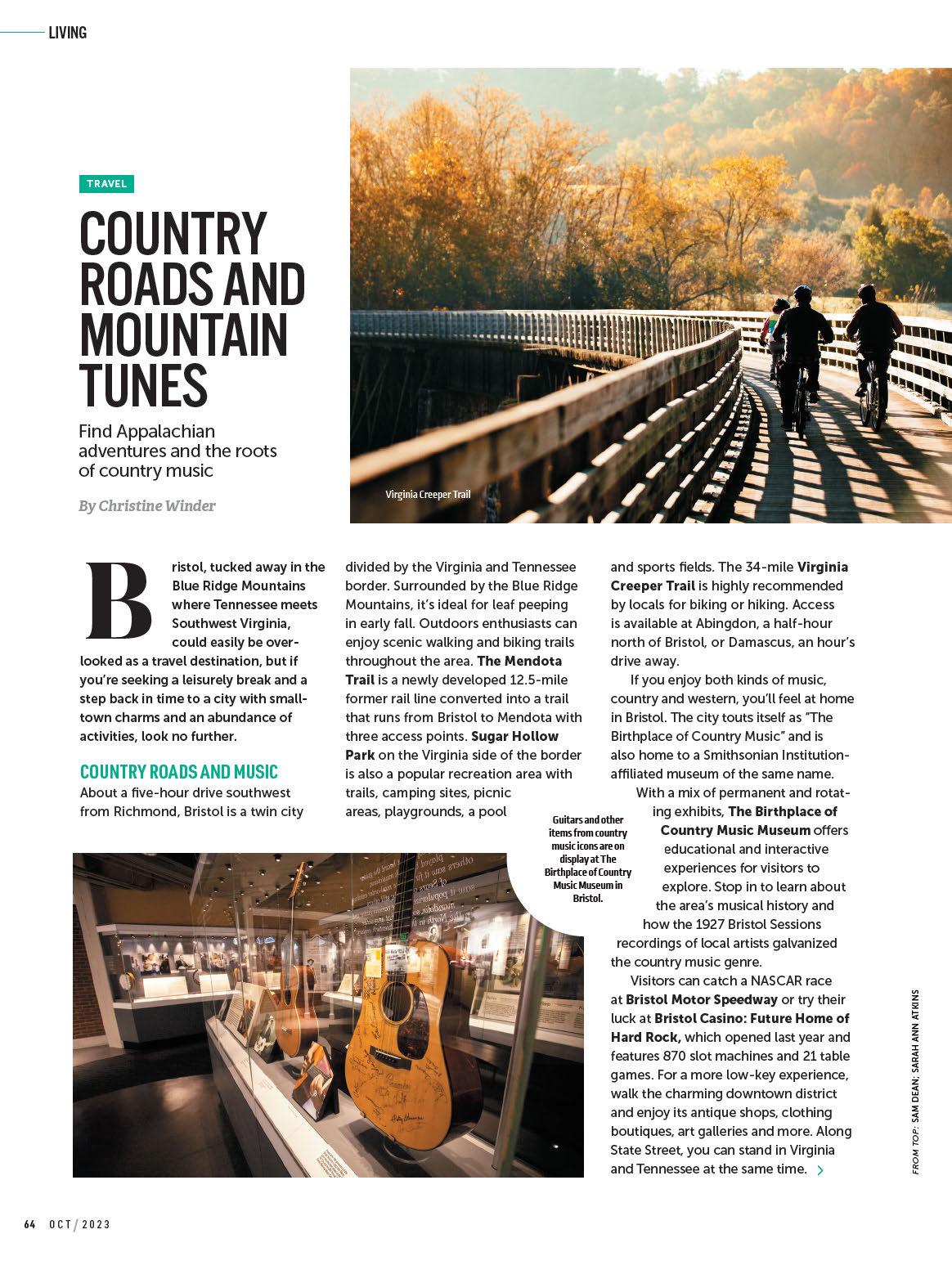
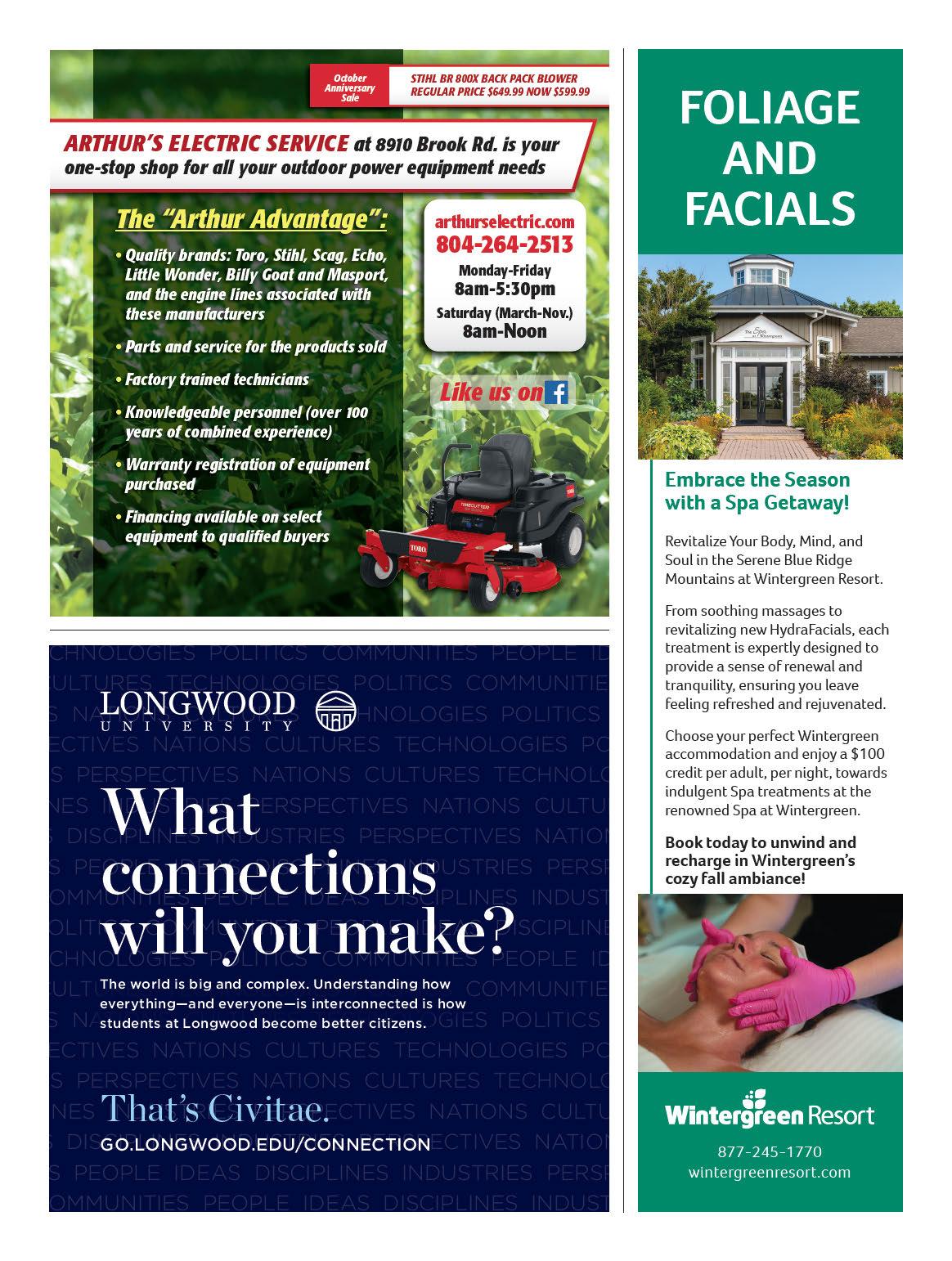


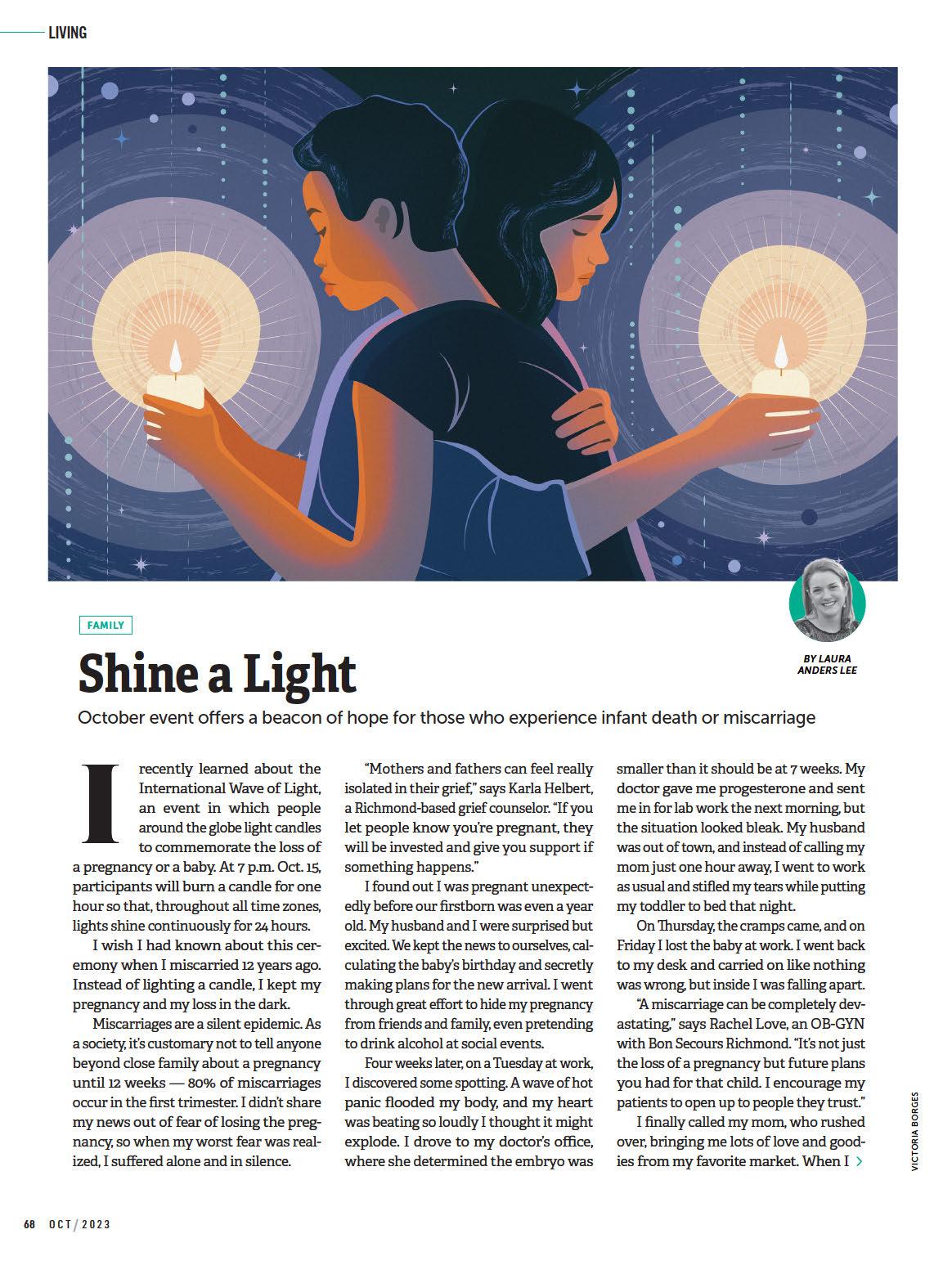

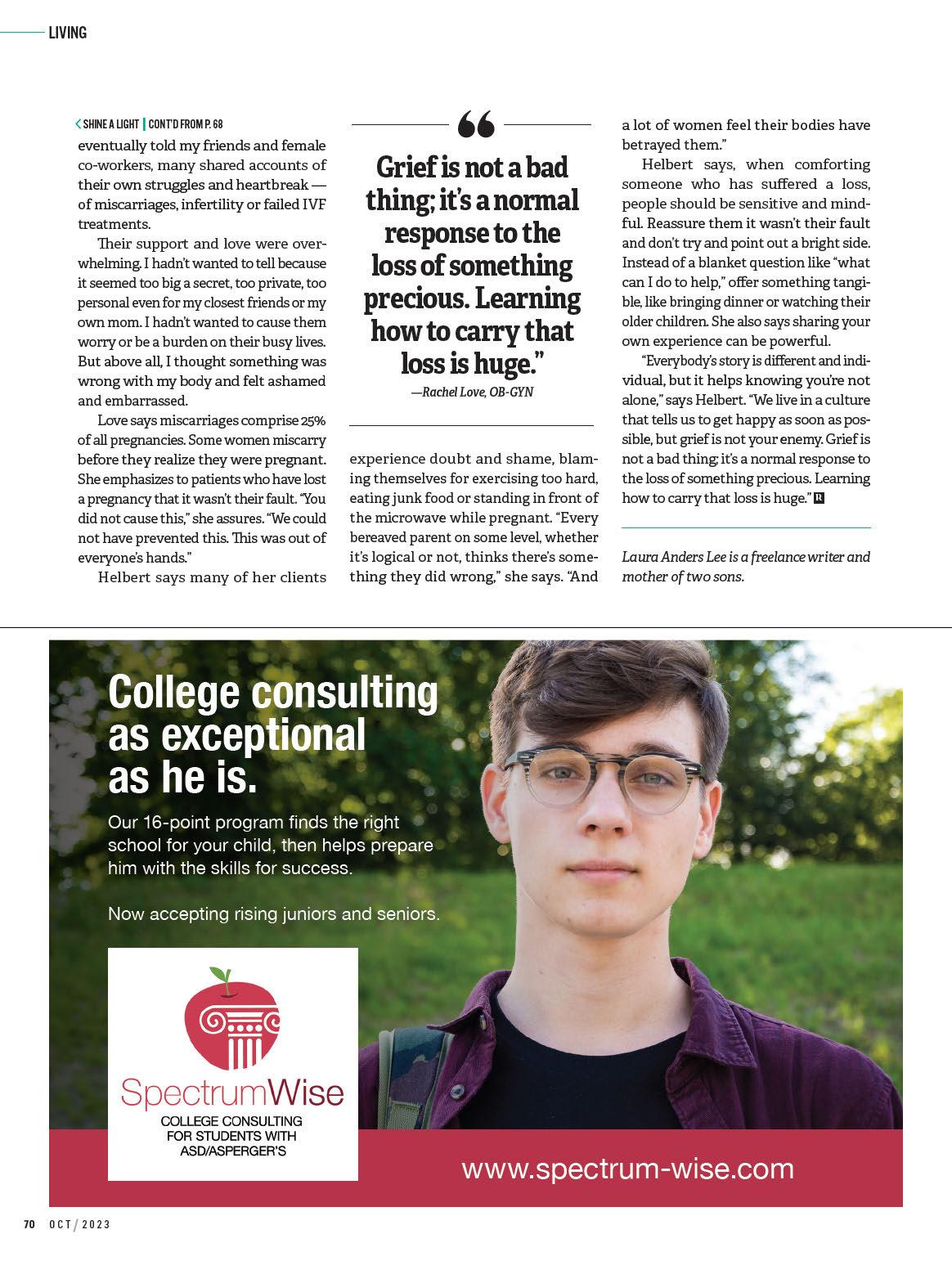


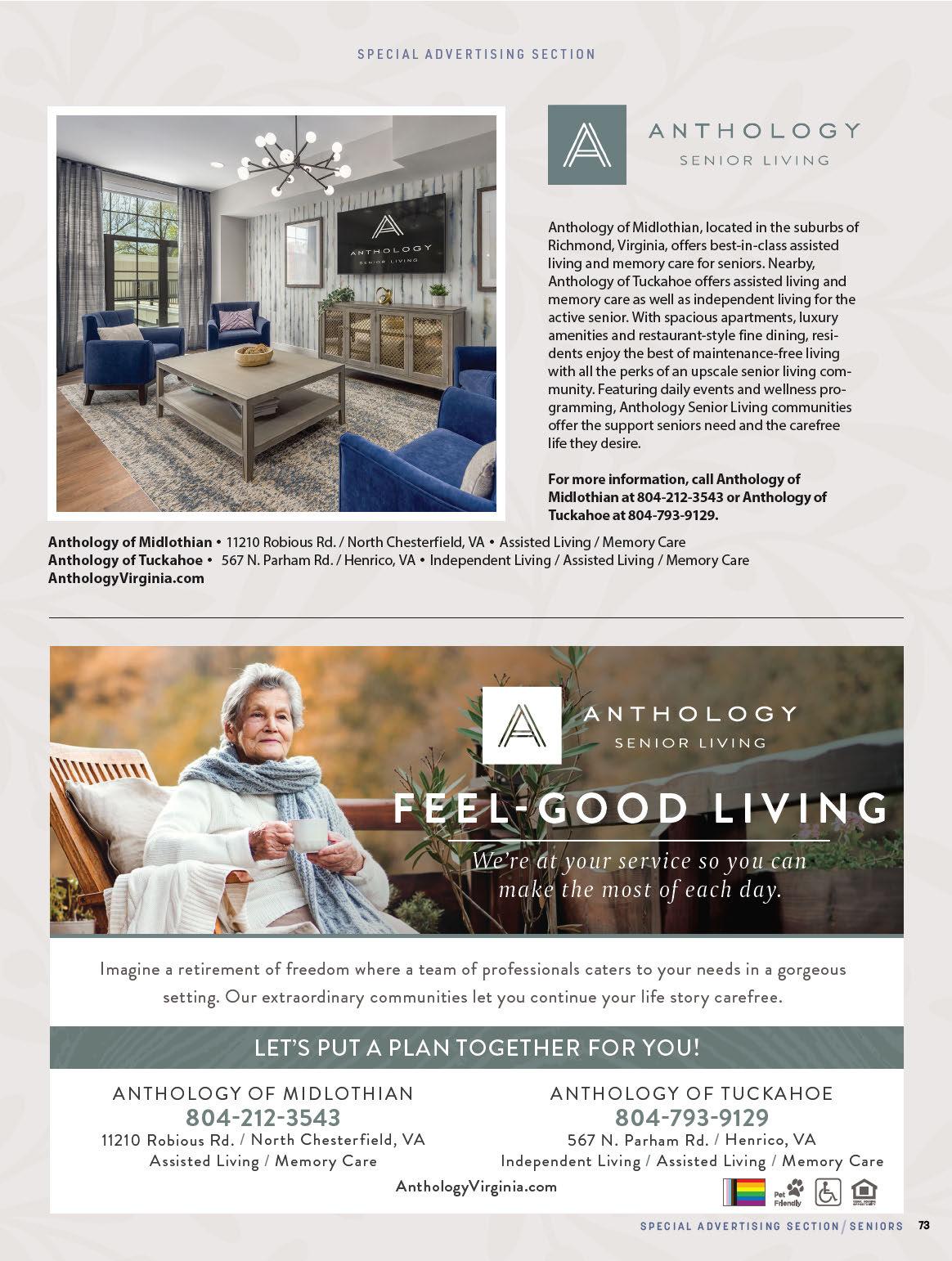
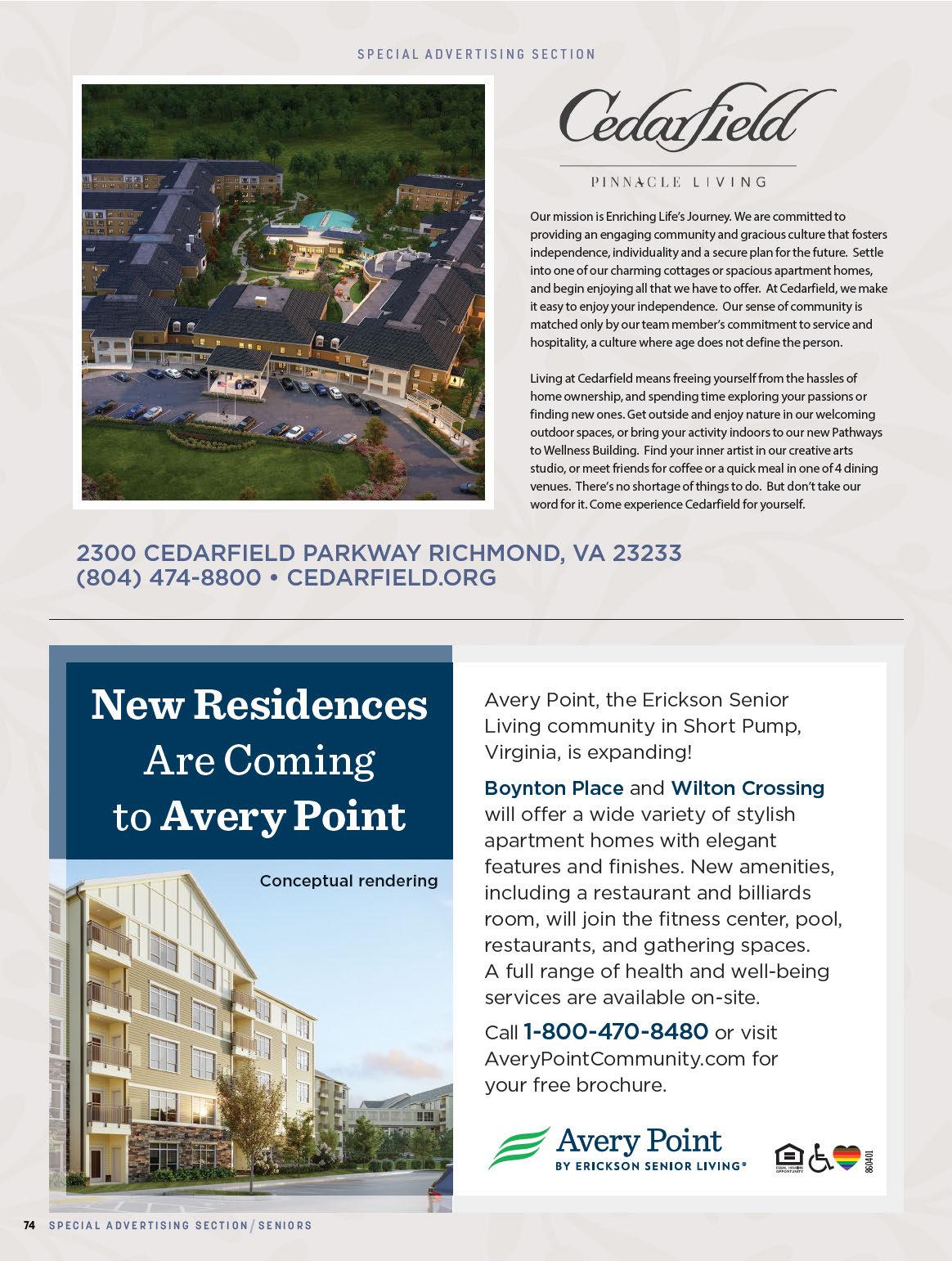
 2023 JAMES RIVER WRITERS’ / RICHMOND MAGAZINE BEST UNPUBLISHED NOVEL WINNER
2023 JAMES RIVER WRITERS’ / RICHMOND MAGAZINE BEST UNPUBLISHED NOVEL WINNER
I was fourteen, and the heat was slipping away from the bonfire that the camp counselors had built up earlier in the evening. Around the pit, deep seats were carved into the hillside like stairsteps, the dirt held in by wood thick as railroad ties. Smoke curled into the dark, and beyond it, the lake was a wide, inky mass edged by trees. We couldn’t really see much of anything else — for the first time all week, the moon was gone.
Margaret and I had been friends since grade school. Her family lived four houses down from mine when I started first grade, and we rode the bus together for years a er that. We’d sit in the back and giggle when we hit that big pothole on Maple Street, our heads bumping the ceiling on days the driver forgot to slow
down. When school was done, we’d go to the playground down the street or over to her house or to mine and we would play pretend or Legos or Barbies. When we’d grown up more, we went to youth group together and watched movies and talked about our futures — how she would be a famous scientist who would cure cancer and I would travel the world. This was our fourth year at the same camp — a church camp I’d gone to since the summer my mother started dating Darian. Mom called herself “spiritual, but not religious,” so it wasn’t like she wanted me to learn about Jesus or anything. But I figured she could stand to have me out of the house for a week — and besides, Mom said Margaret was a good influence.
The week before my house burned down, I dared Margaret to walk over hot coals.
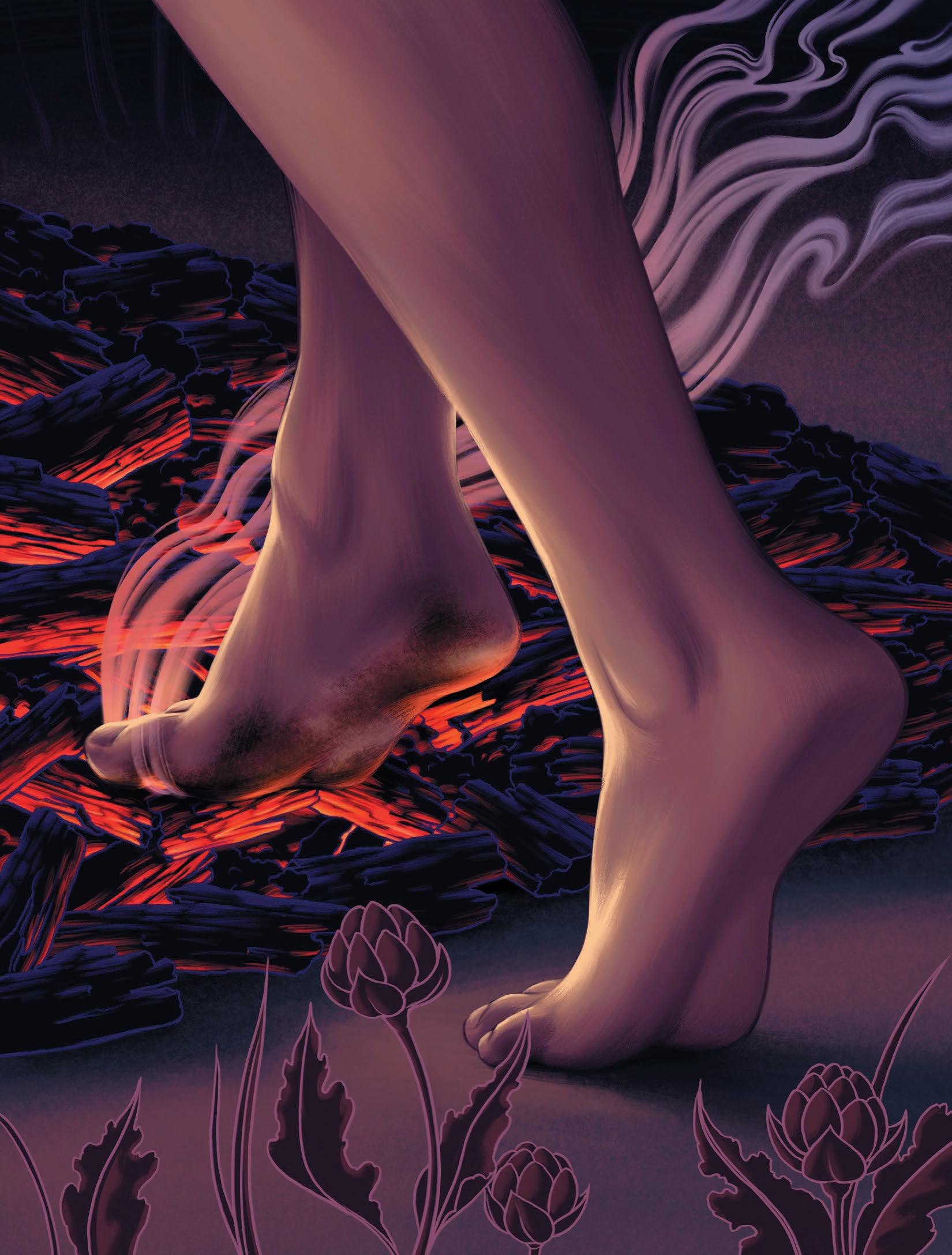
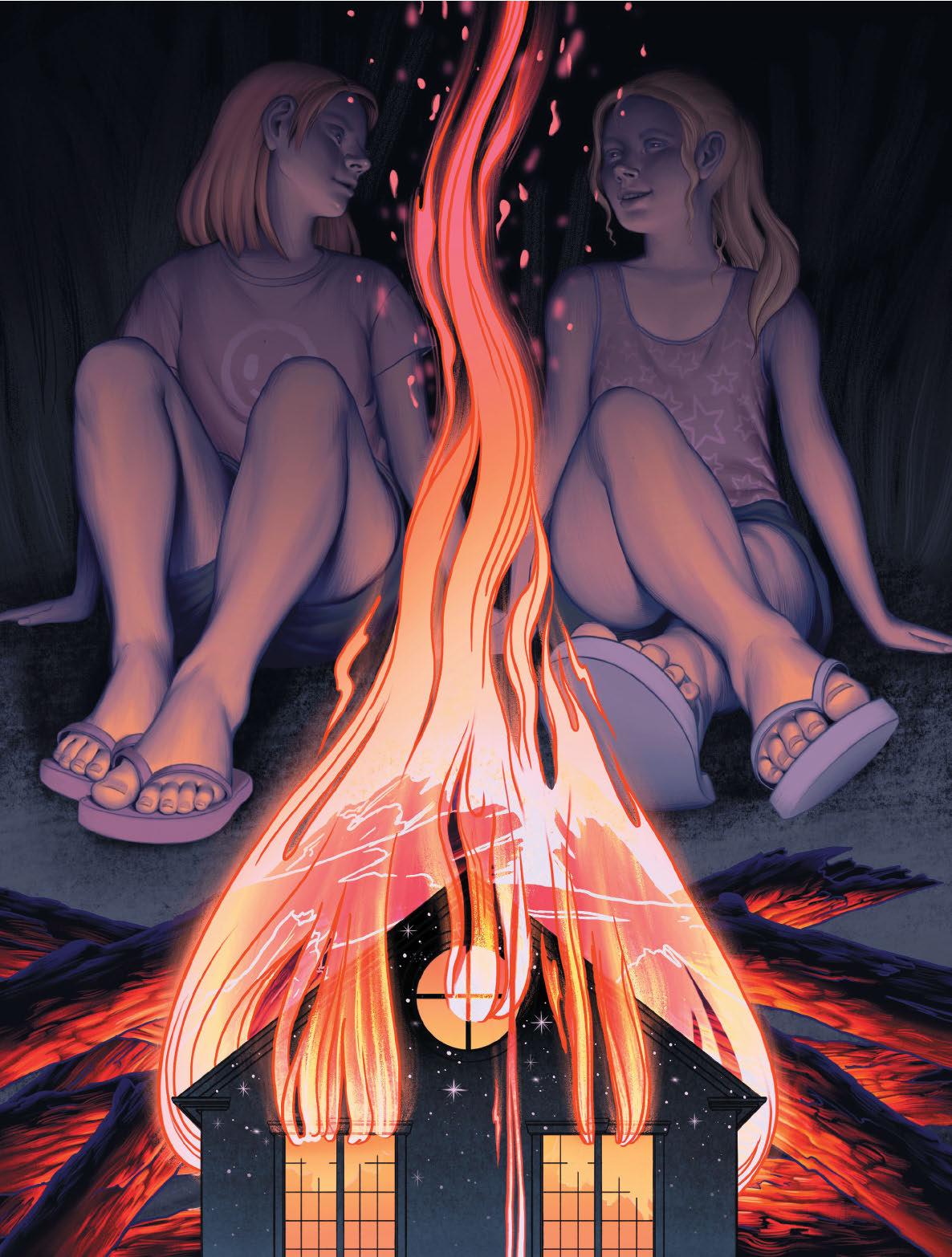
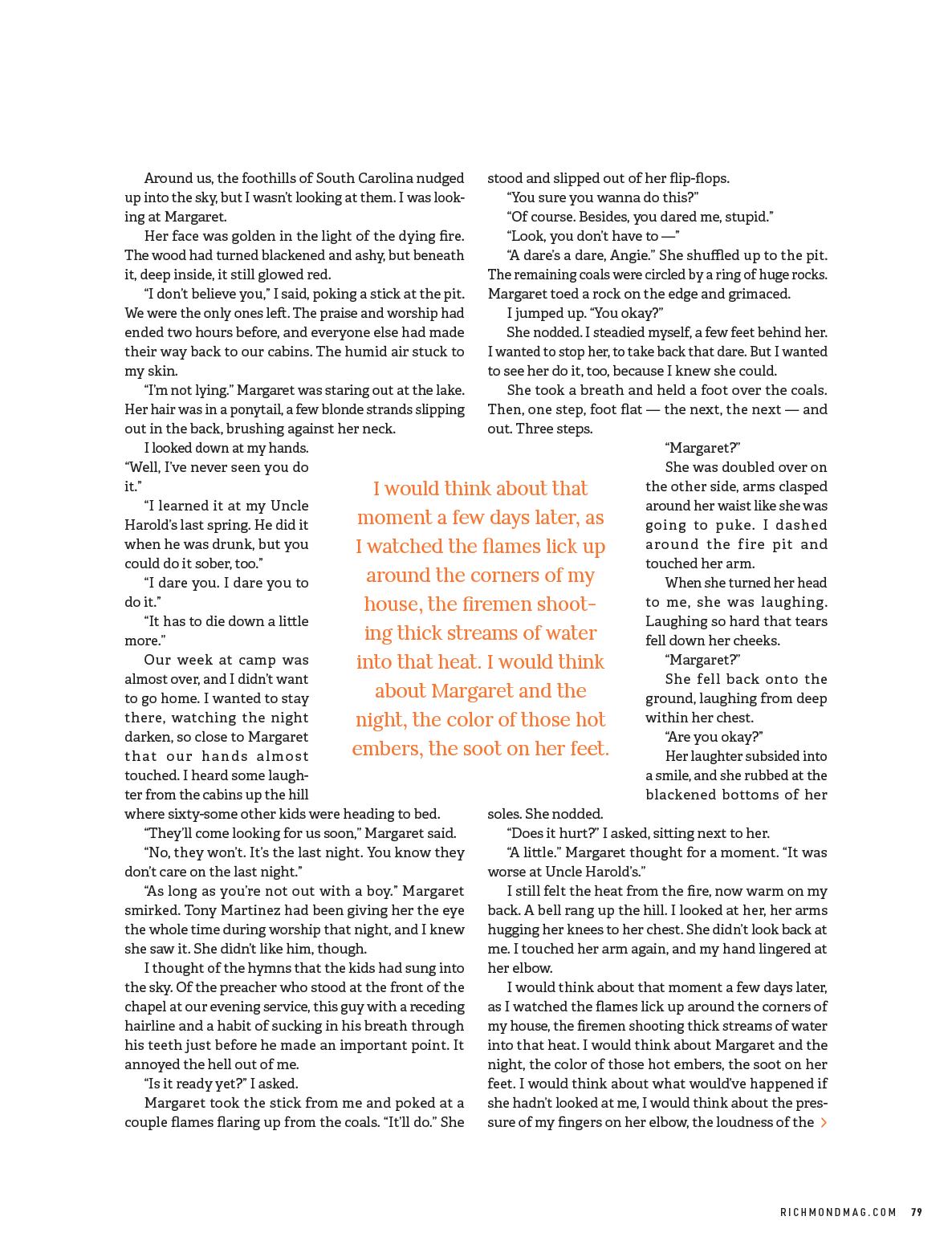
crickets and the frogs and the moon that wasn’t there. The smell of charred wood, my clothing laced with smoke.
When she looked at me, I let go. Her look forced me to look away, made me ashamed of watching her. I remembered a walk we had the a ernoon before, quiet and long around the lake. She made me laugh more than I had in a long time.
If it hadn’t been so dark, if I hadn’t had this feeling that things were going to change, if I hadn’t seen the way Tony had been looking at her, if I hadn’t thought about starting high school in just a few weeks, if I hadn’t felt my heart beating against my ribcage when I thought she was hurt by the fire, maybe things would’ve been different. Maybe I wouldn’t have been able to say what I’d said. It was stupid, I know, and I know be er now, but I was fourteen. And there we were, faces barely captured by the glow of dying coals, the lake still and beckoning, our voices masked by the chirping chorus of night noises, cocooned by the water’s edge.
“Angie.”
I stood. I watched it again in my head — those three steps.
I tried to find the moon. If I could just see the moon, I could see her face more clearly, could see if there was something there to hold onto. But there was nothing up there — no moon at all.
I felt her hand on my shoulder. “I’m okay,” she said. “See?”
I nodded. In the darkness, I wanted to open up my secrets, as if they were meant to be hers, ours. There was no Tony, no Darian, no Mom, no tomorrow, no later. It was just us.
I heard the words before I knew I had said them. At first, I wasn’t sure if I really had said them, or if maybe I had just imagined myself saying them like I had before, around the lake, or at home, or as we sat in church.
But I had said them. I had said, “I love you.” I saw by the look on her face that I had said it.
Her smile was thin. “Well, I love you, too.”
“No. You don’t understand. I —” I felt myself falling — into the water, sucked into the mud at the bo om.
“What?”
Heat was building in my cheeks, my throat, and I clenched my fists against it. I turned my back to her
and trudged through the knee-high grass that led down to the lakeside.
I heard her call my name.
I imagined the water, the clothes suctioning to my skin, tight on my shorts, my T-shirt, holding my breath as I went under.
A hand on my shoulder.
“Angie. Look at me.”
I shook my head.
“What’s wrong?”
The bell rang again. They would be looking for us soon, I thought. I turned to her, but I couldn’t see her face. “You don’t understand,” I said.
“I do.”
“No, you don’t.”
Her hand dropped, and I saw myself standing alone. But then I felt it — her hand in mine, her fingers in between mine. I felt the blood rush to my face, and I froze. I heard her voice say,
“It’s okay.”
I was silent. I felt everything at once, heard everything at once, saw the night as something beautiful, saw my future as something suddenly bright and beautiful. Her hand slipped out of mine. “We should go back. Angie?”
I still felt her fingers there, even in that emptiness. I clenched my hand into a fist and sucked in a deep breath. “Yeah,” I managed. But when I looked over my shoulder, she was already walking up the hill.
Later that night, I couldn’t sleep. The cabin was too quiet and my head was too noisy. Margaret slept in the bunk above me. I heard her breathe in and then let it out.
At some point, I got up and went back down to the fire pit. Kenny, one of the counselors, was there. He was a college kid, home for the summer, with golden-boy hair and a deep Southern accent. “What’s up, kid?” he said. “Shouldn’t you be in bed?”
I remembered his fervent prayer from that evening — all the lost souls coming to Jesus, our voices beacons to the world. “Can’t sleep.” I sat down beside him.
“Something bothering you?”
I shook my head. We sat in silence and stared at the starless sky. R
I was silent. I felt everything at once, heard everything at once, saw the night as something beautiful, saw my future as something suddenly bright and beautiful.
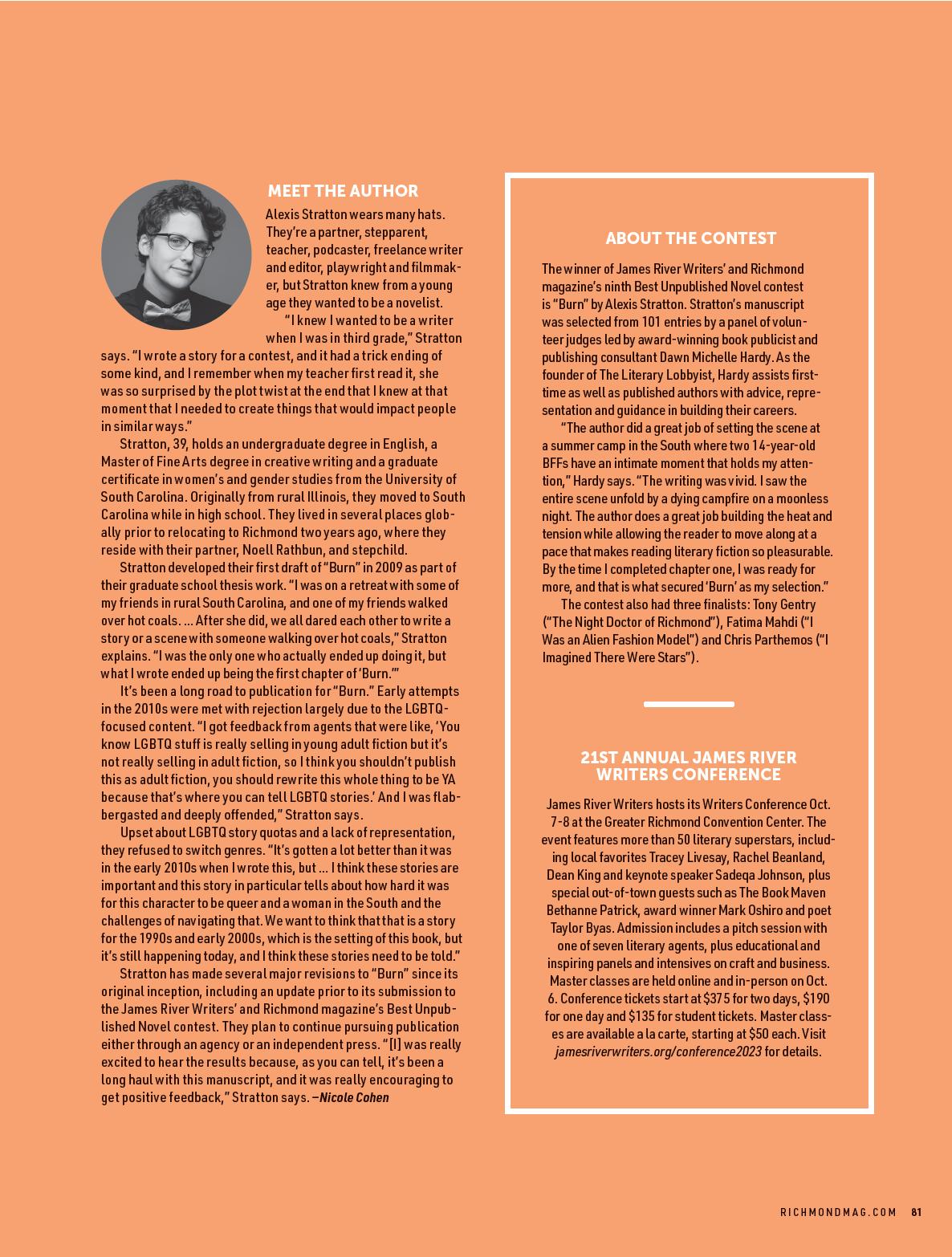



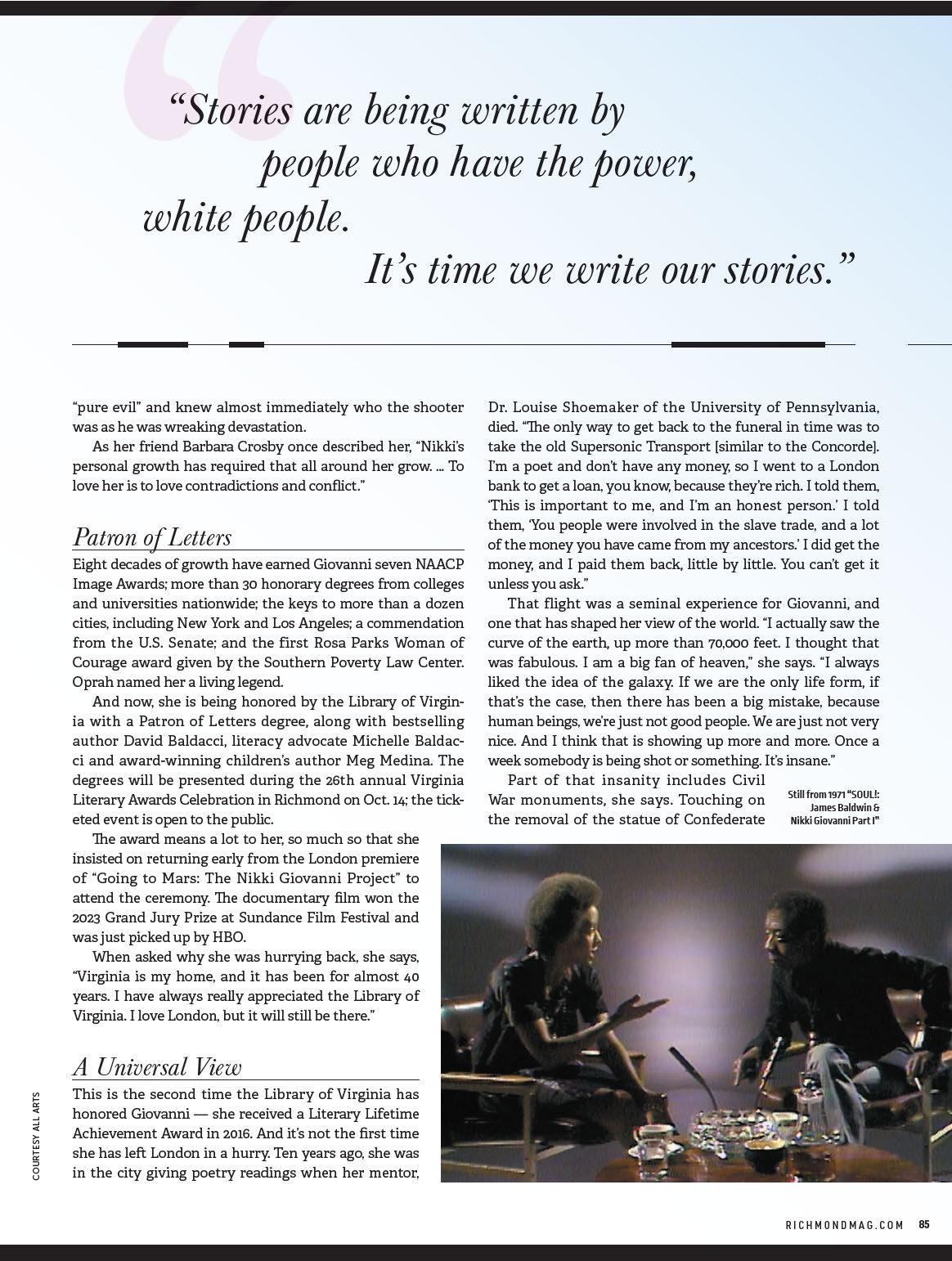

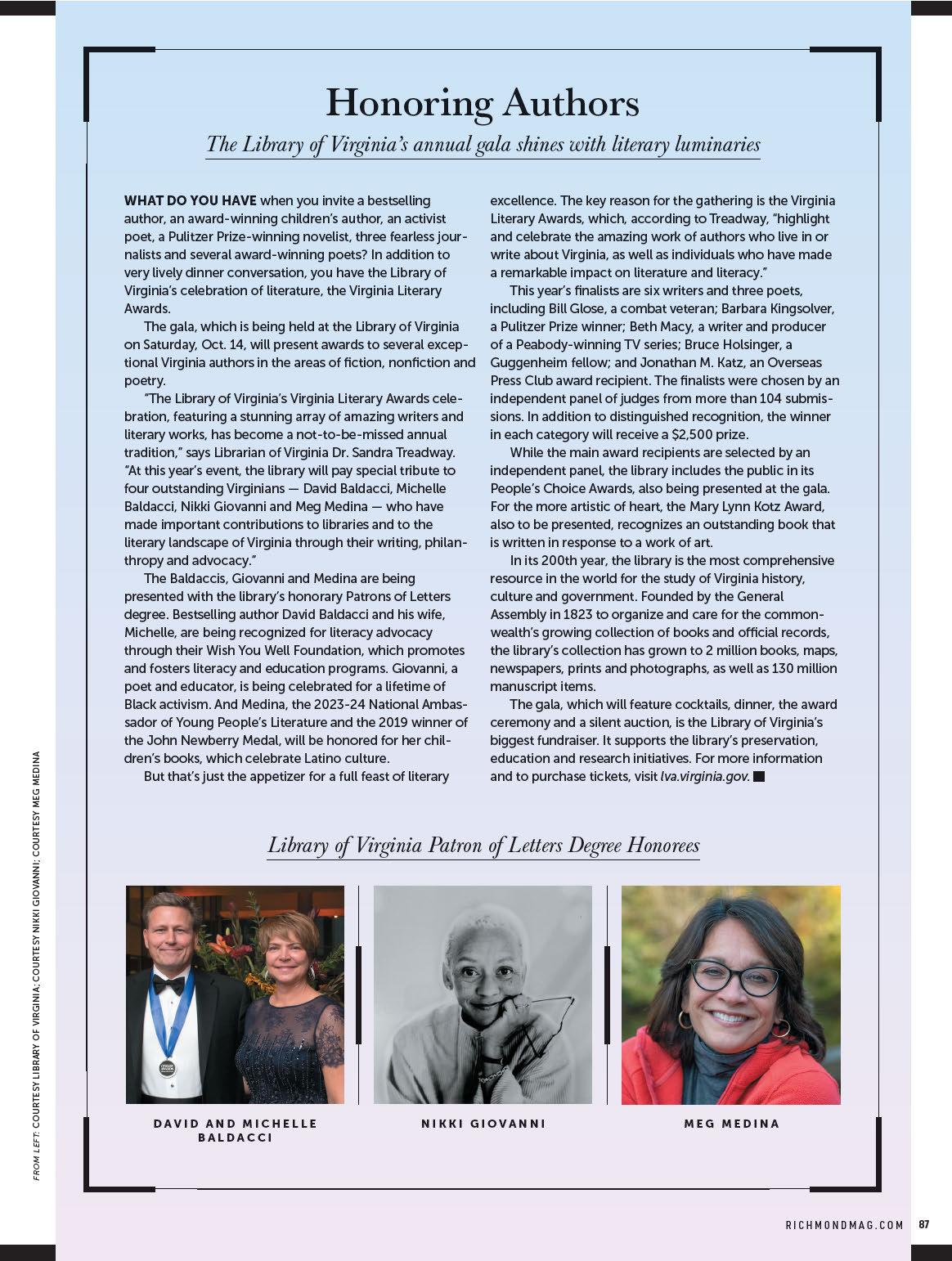

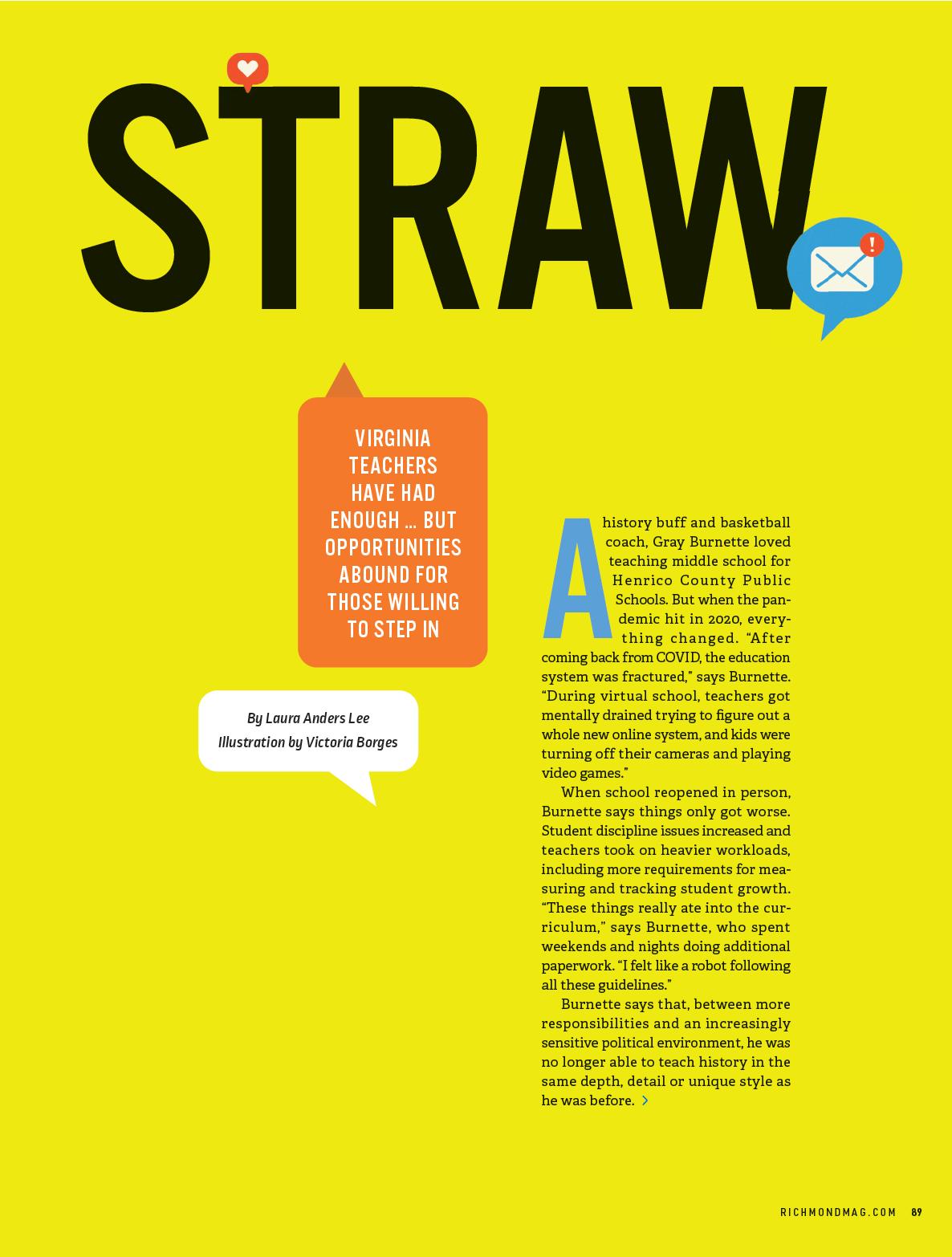
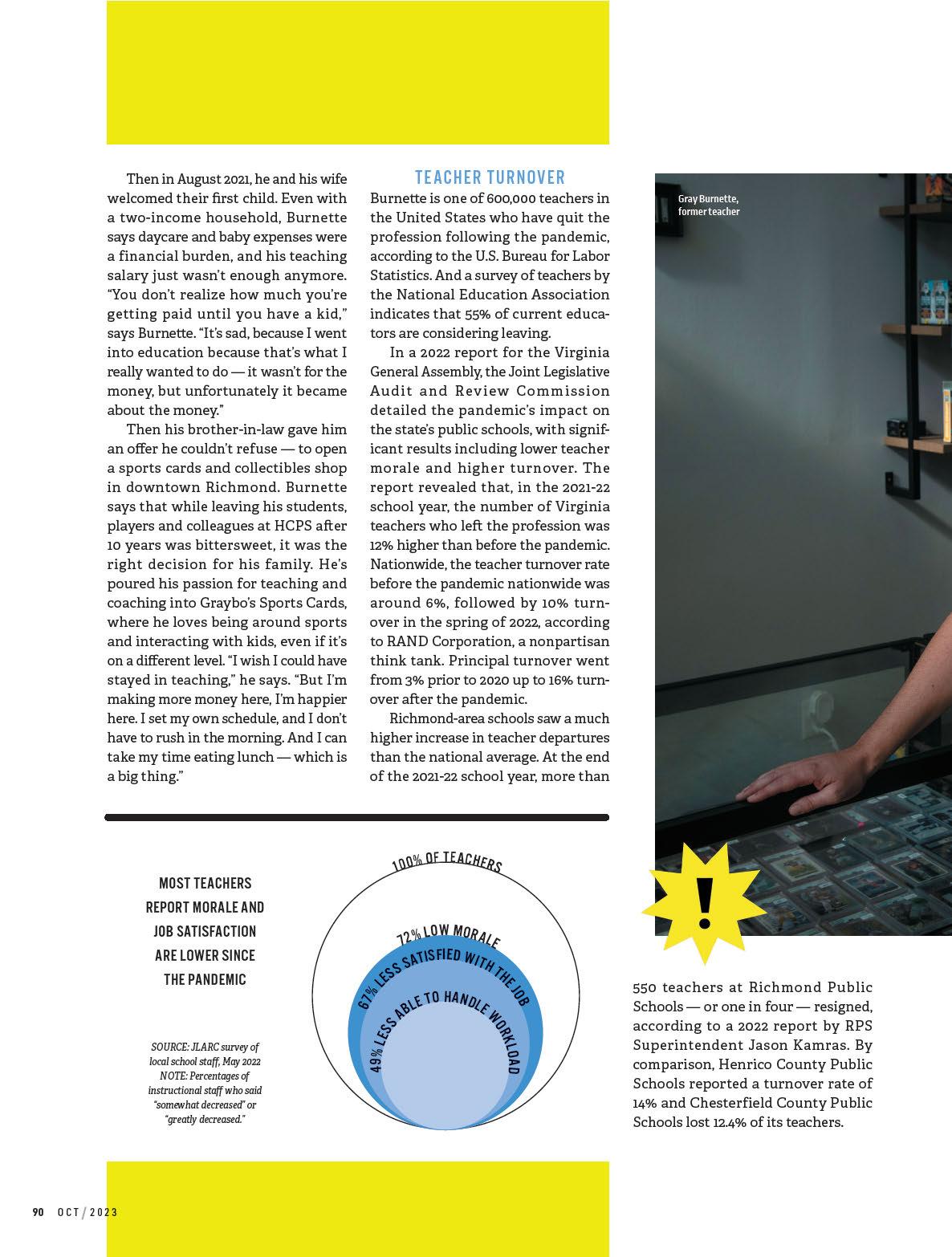
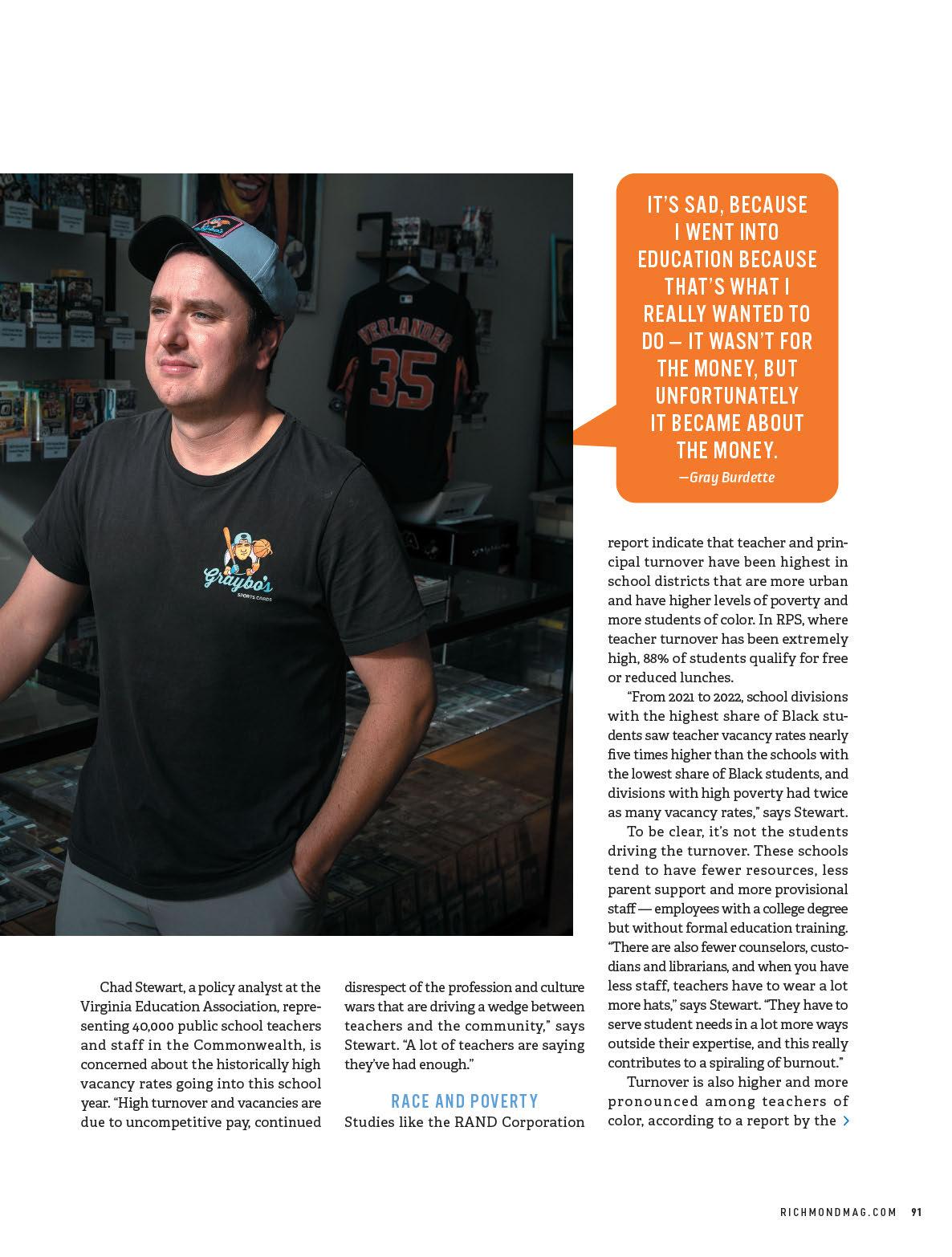



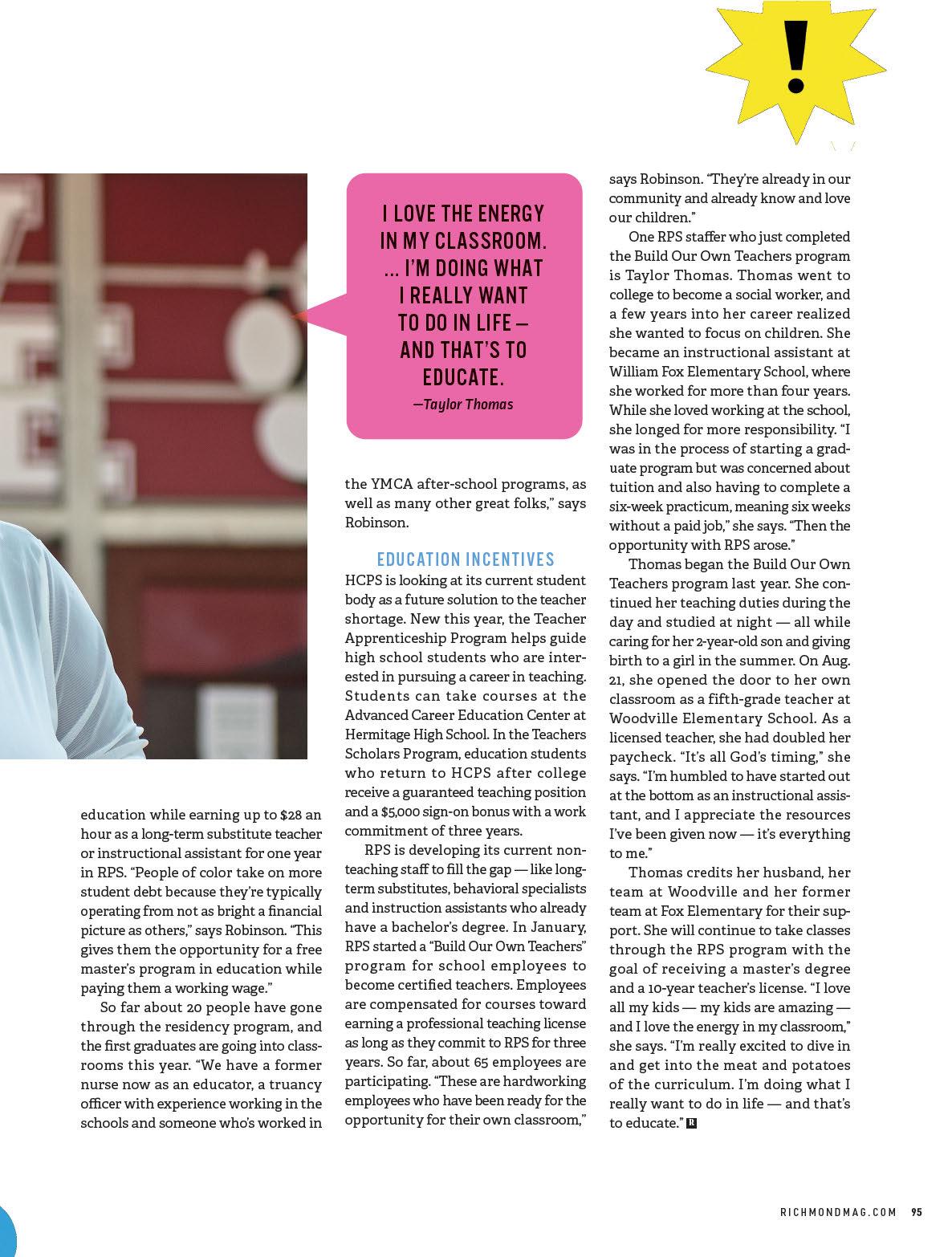
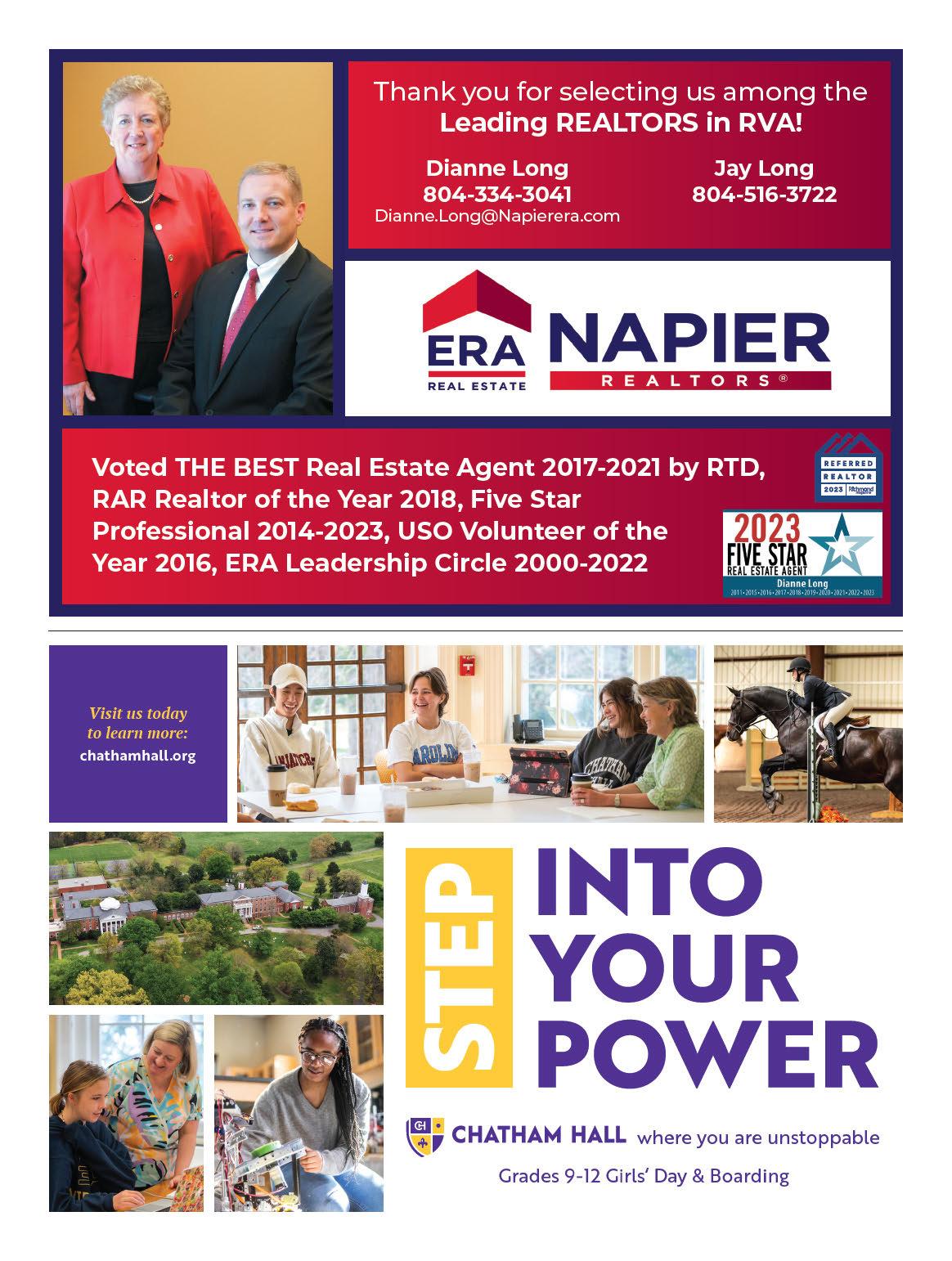
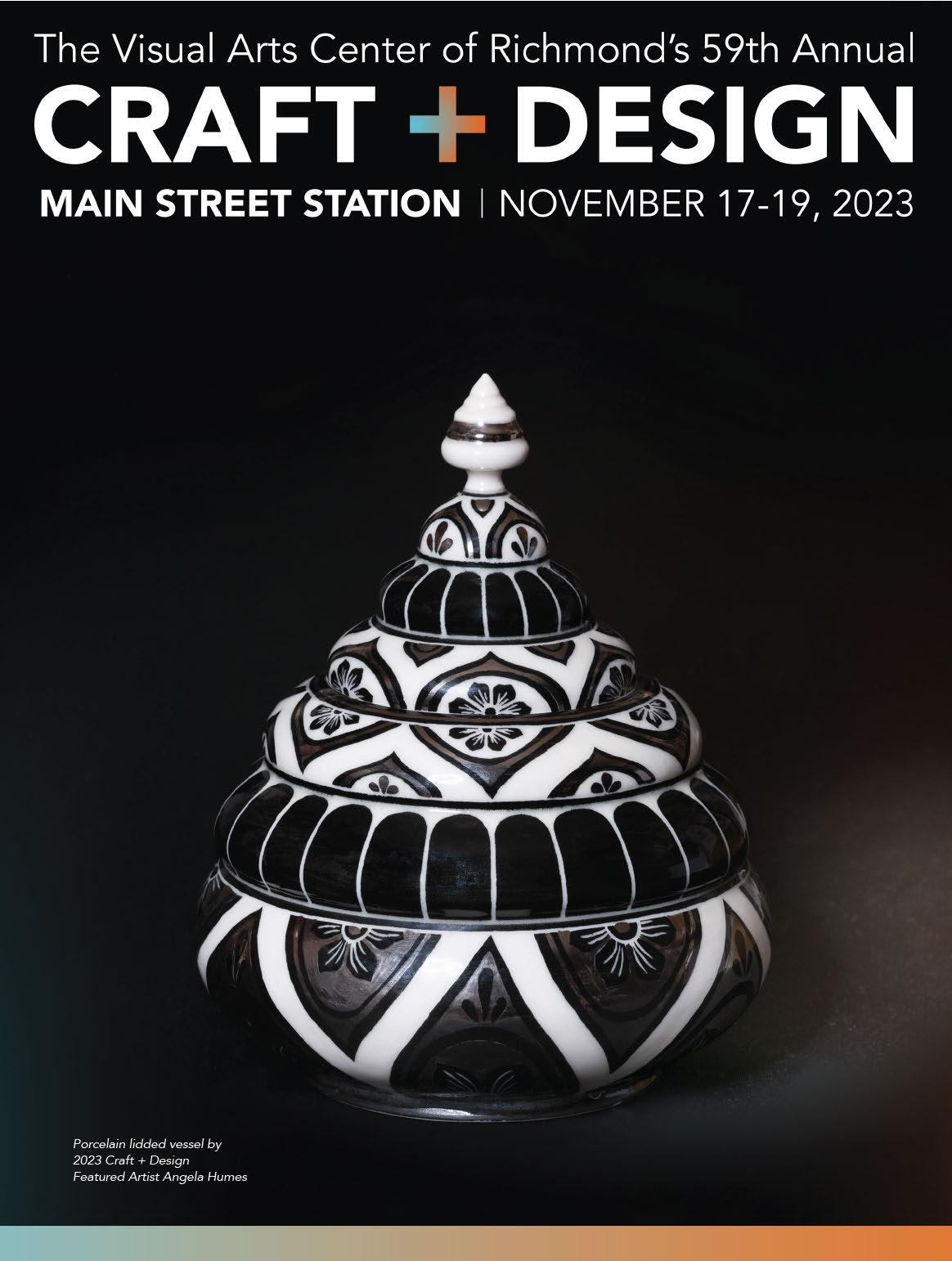
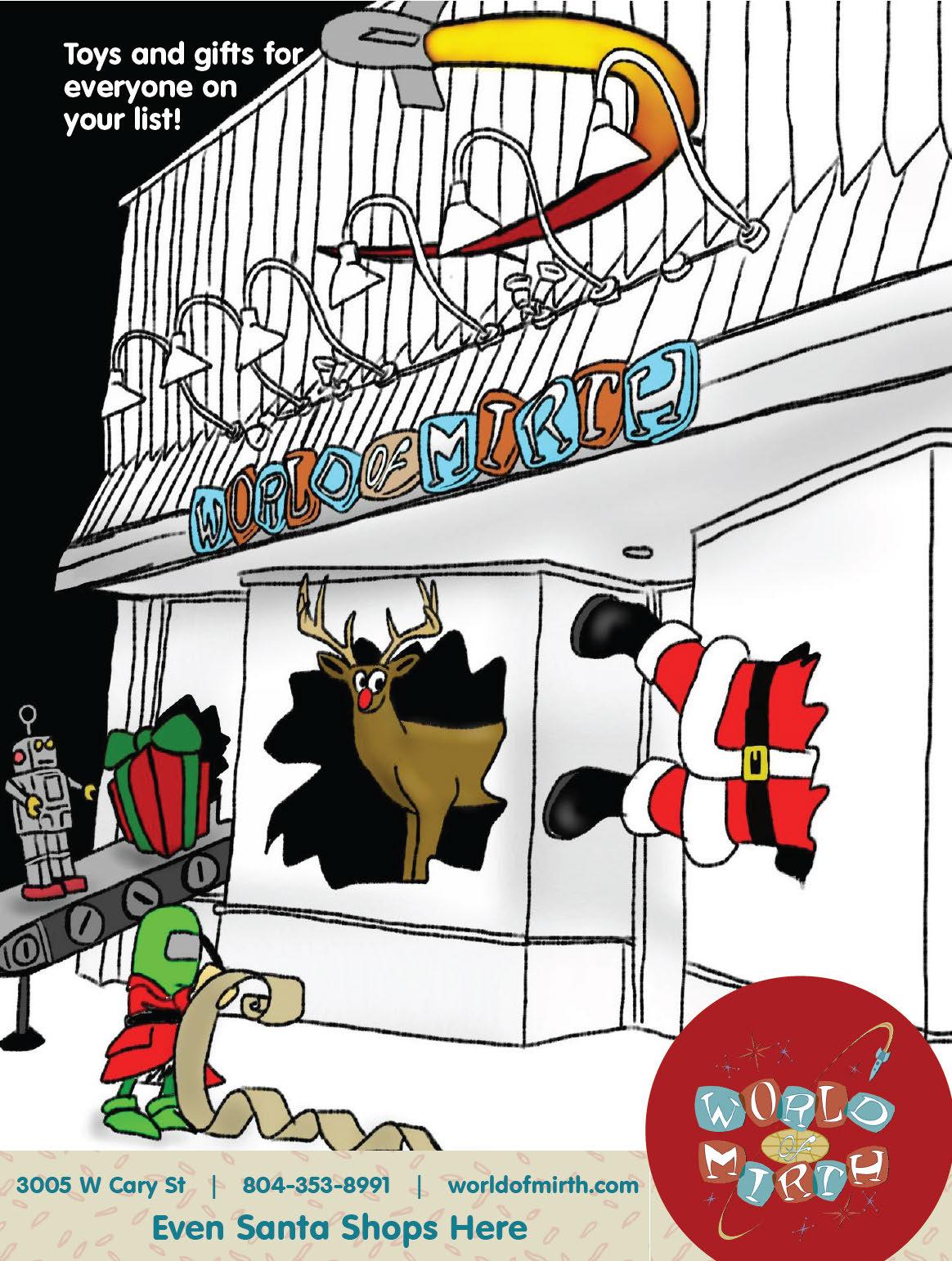


More than 200 teaching artists call the Visual Arts Center of Richmond home. They are sculptors and printmakers, weavers and metalsmiths, photographers and ceramicists, and together they make it possible for VisArts to offer more than 1,500 community art classes a year. The following VisArts teachers earned spots at Craft + Design through a special selection process:
Alexandra Barao
Booth 426A • Ceramics
David Camden
Booth 506 • Ceramics
Sarah Grace Cheek
Booth 509A • Wood
Jess Cullen Booth 509B • Ceramics
Alicia Dietz Booth 507 • Wood
Sarah Galanti
Booth 227 • Glass
Lauri Jenkins
Booth 505 •
Wearable Art
Paul Klassett
Booth 325 • Ceramics
Bernadette Larimer
Booth 511B • Ceramics
Claire McCarty
Booth 427 • Ceramics
Shawn Norian
Booth 503 • Jewelry
Christine Orr
Booth 510A • Ceramics
Al Pellenberg
Booth 508 • Ceramics
Kourtenay Plummer
Booth 510B • Ceramics
Rachel Rader
Booth 511A • Jewelry
Ashlyn Rudolph
Booth 512A • Wood
Cindy Shelton-Eide
Booth 512B • Ceramics
Natalie Sullivan
Booth 525 • Fiber
Sarah Tector
Booth 504 • Jewelry
In 2022, the Visual Arts Center of Richmond recognized the following artists for the work they exhibited at our Craft + Design Show:
Elisabeth Scott Bocock Best in Show Award, Presented by Pam and Bill Royall Nicario Jimenez
Innovative Use of Traditional Craft Materials by Alex McGrath Mark + Sharon Diebolt
Classic Party Rentals of Virginia Fiber Award Tegan + Eric Frisino
VPM Precious Metals Award Jim Cohen
High Dawn Studios Wood or Recycled Materials Award Shanti Yard
VisArts teacher Alyssa Salomon was accepted into Craft + Design through our juried application process. Look for her booth information beginning on page 6.
Be sure to check out the VisArts Artist Shop featuring a variety of works for sale by VisArts teaching artists including Angela Bacskocky, Merenda Cecelia, Jennifer Dodge, Lora Hart, Karen Hull, Lil Lamberta, Claudia Meyer, Alex Neckopulos, Nga Nguyen-Weaver, Sophie Smith, Ash Tamber and Jerry Veneziano. The VisArts Artist Shop is in Booths 322-324
Additional Support
Provided By

Chair: Stephanie McGrath
Co-Chair: Clare Tilton
Sally Ashburn
Jenny Bassett
Priscilla Burbank
Marcia Collier
Susan Craven Johnson
Jean DeShazo Jumet
Jessica Haddad
Chris Hairston-White
Marissa Hermanson
Priscilla Burbank and Mike Schewel Glass Award
Trefny Dix and Bengt Hokanson
Craft + Design Selection Jury

Marcia Collier
Karen Kelly
Stephanie McGrath
Cynthia Myron
Jeff Wilson
Craft + Design Committee

Moomaw
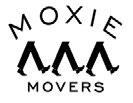
Karen Kelly
Virginia Lewis
Celia Rafalko
Jaqueline Rogers
Stephanie Ruffin
Shockoe Bottom Clay Ceramics Award
Christine Goh
Artist Sponsors
Kate + John Ackerly
Anne Grier
Karleigh + Zach Hunt
Tammy + Brian Jackson
Karen + Pat Kelly
Connie + Chip Lacy
Katherine + Jack Nelson
Kim Ruscio
Wendy Shannon
Frankie Slaughter
Lora Spiller
Lynn Spitzer
Dian Suder
Vicki Thompson
Clare Tilton
Karin Walker
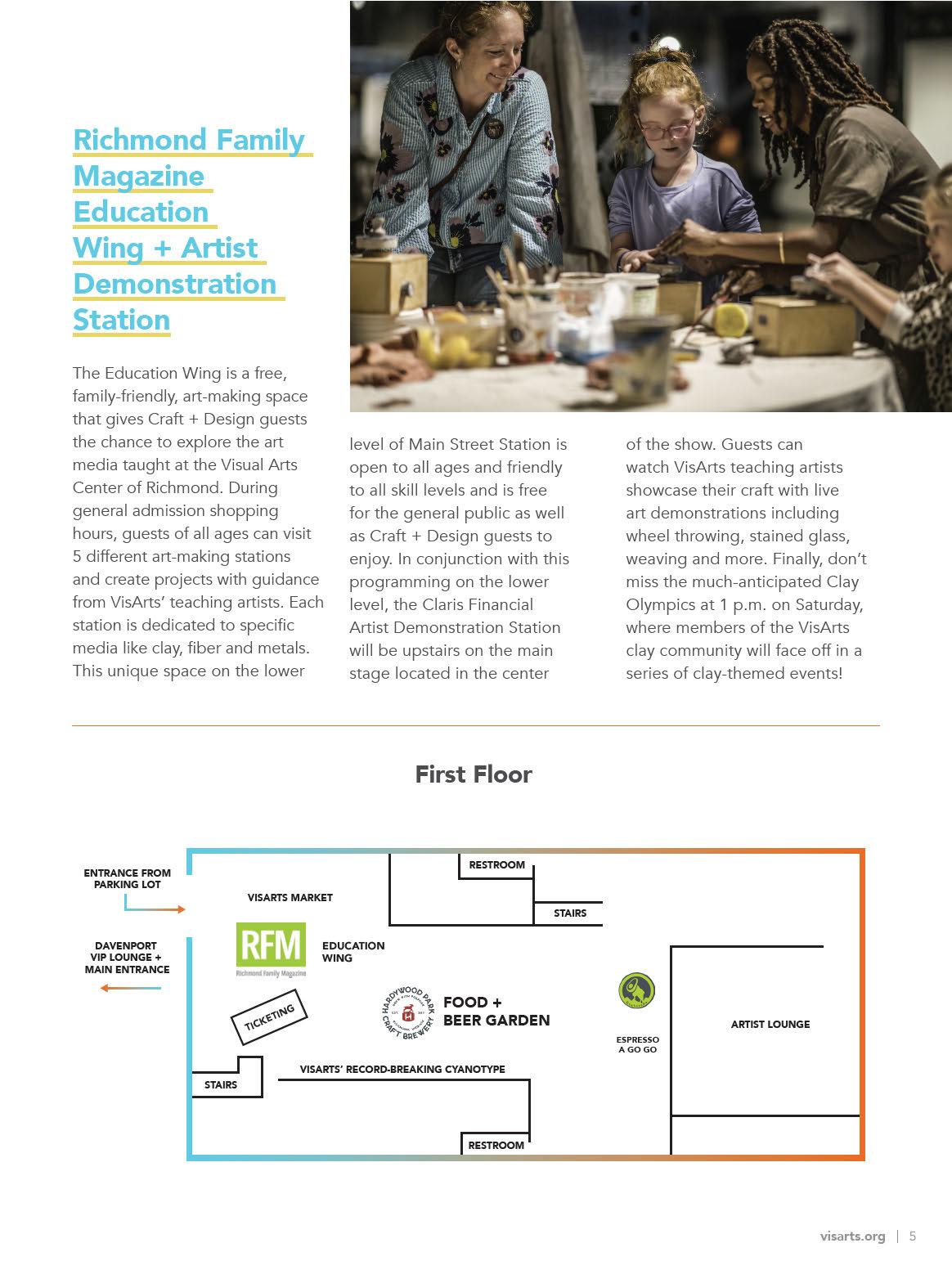
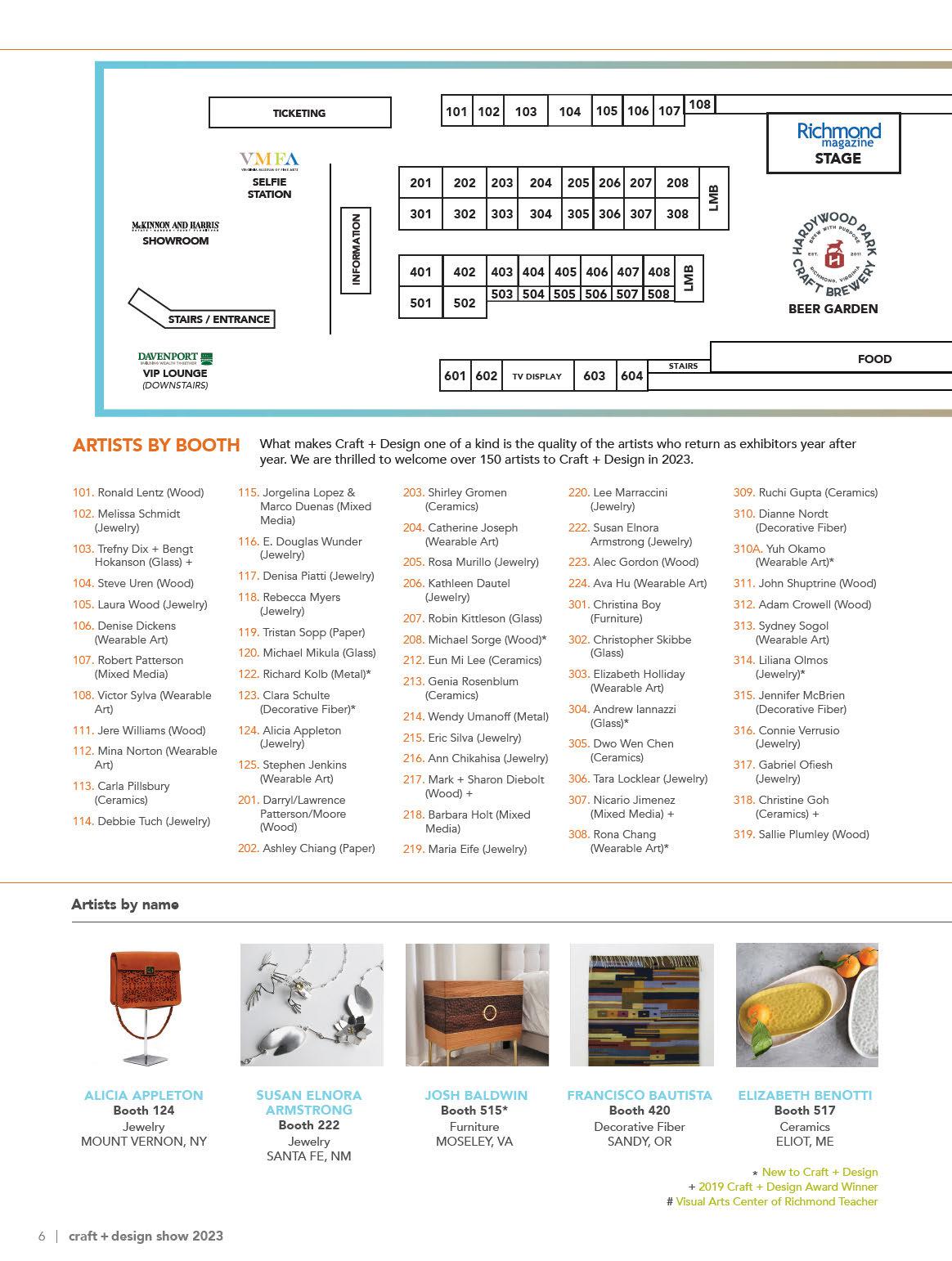

DWO WEN CHEN Booth 305 Ceramics PROVIDENCE, RI

ASHLEY CHIANG Booth 202 Paper SILVER SPRING, MD
ANN CHIKAHISA Booth 216 Jewelry SEATTLE, WA
LISA CIMINO Booth 418 Jewelry BALTIMORE, MD
NEIL CLAYPOOLE Booth 614 Wood KEMPTON, PA
ADAM CROWELL Booth 312 Wood BONNEAU, SC
KATHLEEN DAUTEL Booth 206 Jewelry RALEIGH, NC

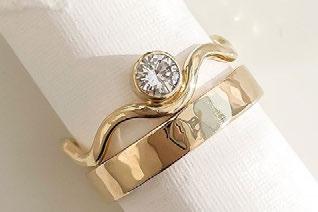


LISA DEMIO Booth 502* Decorative Fiber HAMPSTEAD, NH



BRITTANNY DERAFFELE Booth 616* Jewelry RICHMOND, VA
MARIA EIFE Booth 219 Jewelry PHILADELPHIA, PA

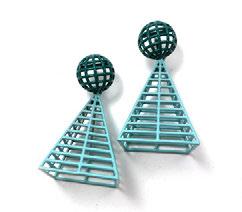
HALI EMMINGER Booth 320 Ceramics RICHMOND, VA
EMMA FULLER + MICHAEL OVERBY Booth 407 Furniture


CARRIE GEORGE Booth 617 Wearable Art ROCHESTER, NY

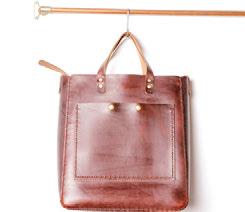
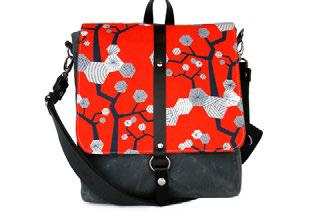
KRISTIN GEREAU Booth 413* Wearable Art WAUKESHA, WI
SHIRLEY GROMEN Booth 203 Ceramics ARLINGTON, VA

RUCHI GUPTA Booth 309 Ceramics GLEN ALLEN, VA
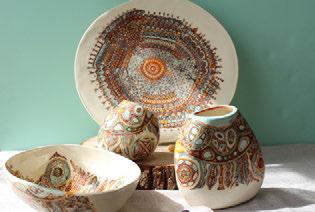
NICOLE HADDAD Booth 424* Wearable Art PHILADELPHIA, PA
AMANDA HAGERMAN Booth 411 Jewelry CROFTON, MD
* New to Craft + Design
+ 2019 Craft + Design Award Winner # Visual Arts Center of Richmond Teacher

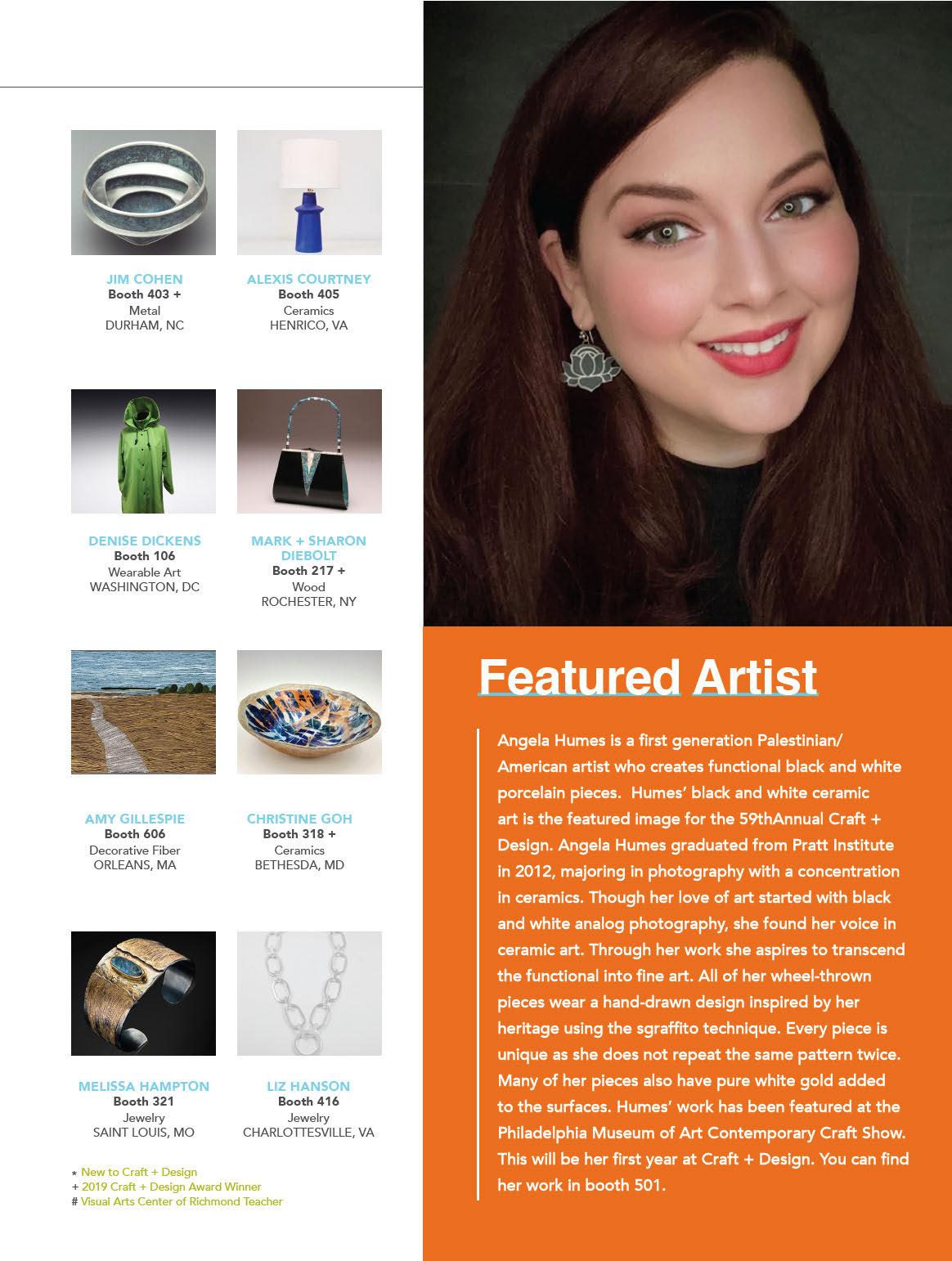




CHRISTOPHER SKIBBE Booth 302 Glass RICHMOND, VA
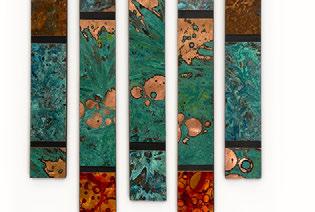



SYDNEY SOGOL Booth 313 Wearable Art DURHAM, NC
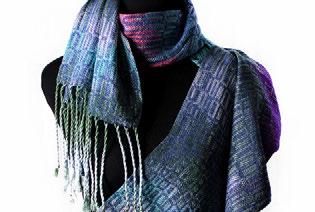
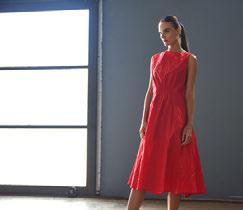
JOSHUA SOLOMON Booth 404 Glass NORFOLK, VA
TRISTAN SOPP Booth 119 Paper PITTSBURGH, PA
MICHAEL SORGE Booth 208* Wood MIDDLEBROOK, VA



WENDY STEVENS Booth 612 Metal BOYERTOWN, PA
VICTOR SYLVA Booth 108 Wearable Art BROOKLYN,
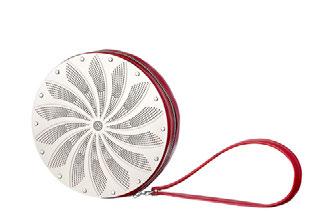
ELIZABETH TOKOLY Booth Jewelry HOBOKEN, NJ
DEBBIE TUCH Booth 114 Jewelry BROOKLYN, NY
WENDY UMANOFF Booth 214 Metal RICHMOND, VA
STEVE UREN Booth 104 Wood GRAND RAPIDS, MI
CATHY VAUGHN Booth 417 Metal RICHMOND, VA
CONNIE VERRUSIO Booth 316 Jewelry HIGHLAND, NY



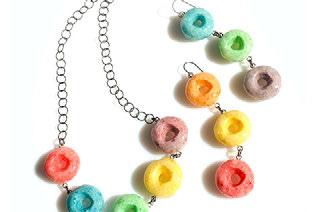
SHIRLEY WEFFER Booth 602 Wearable Art FORT LAUDERDALE, FL
SARAH WEST Booth 608 Jewelry GARNER, NC
JERE WILLIAMS Booth 111 Wood SAVANNAH, GA
JOE WISLAR Booth 613* Mixed Media STAUNTON, VA
* New to Craft + Design + 2019 Craft + Design Award Winner # Visual Arts Center of Richmond Teacher





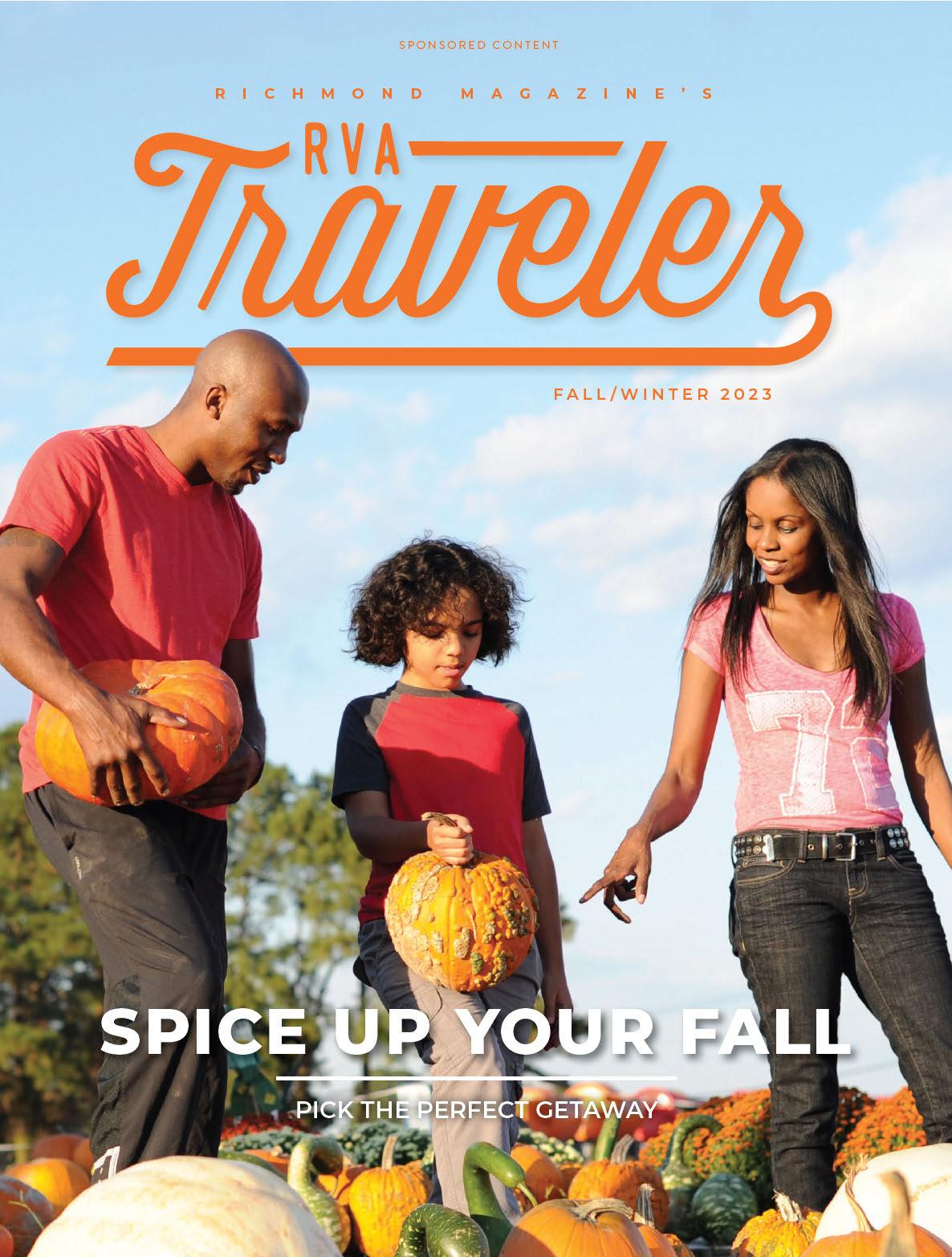



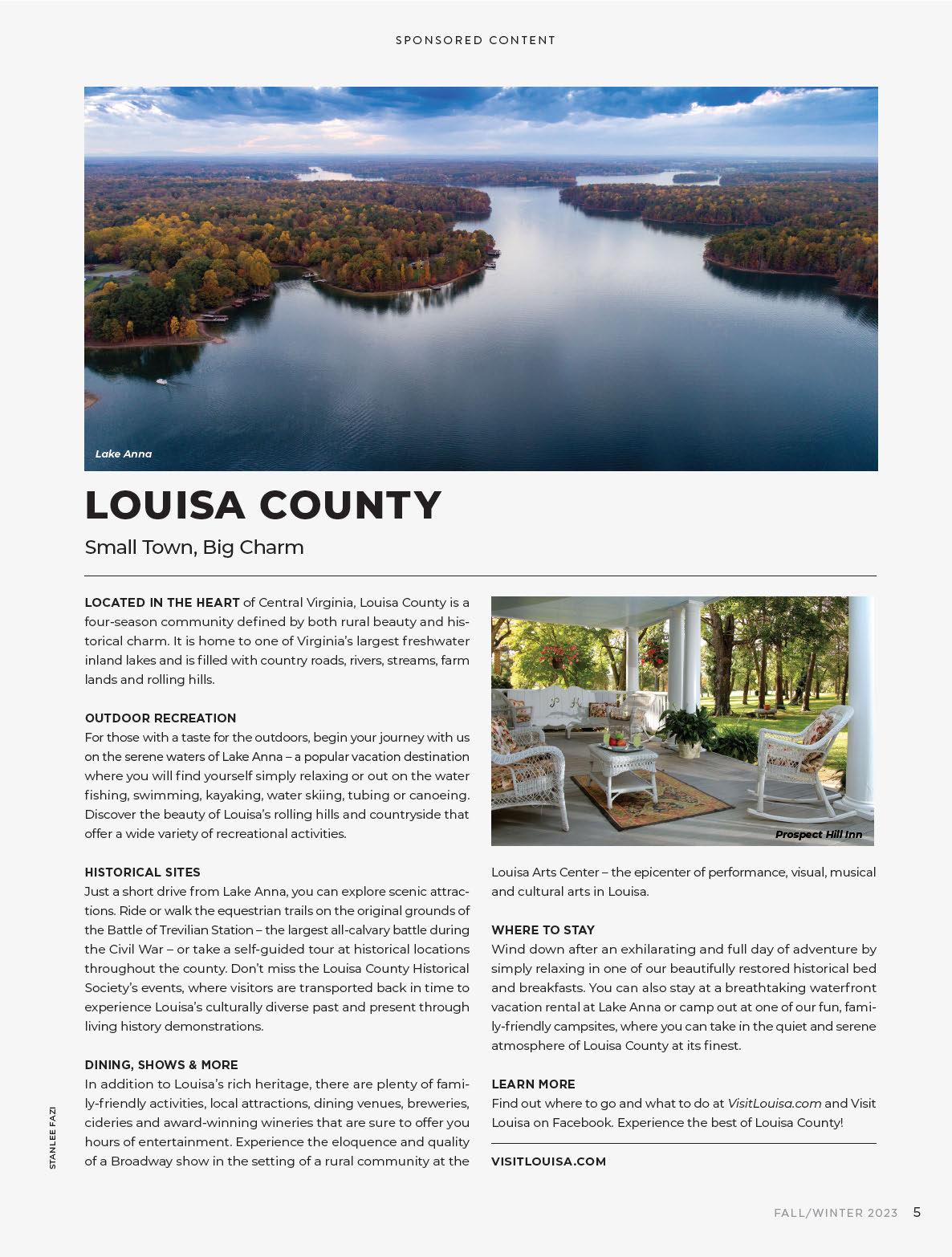

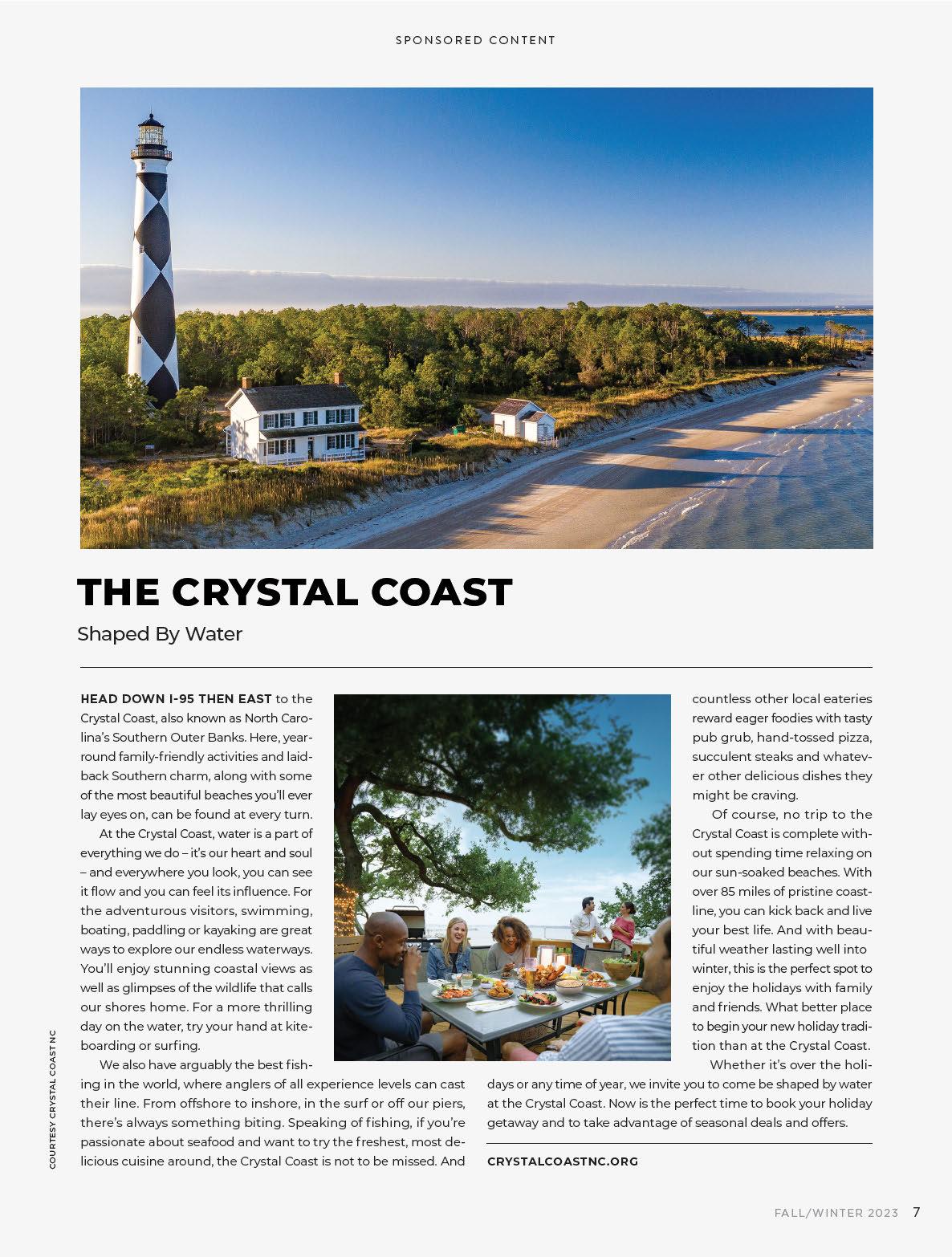

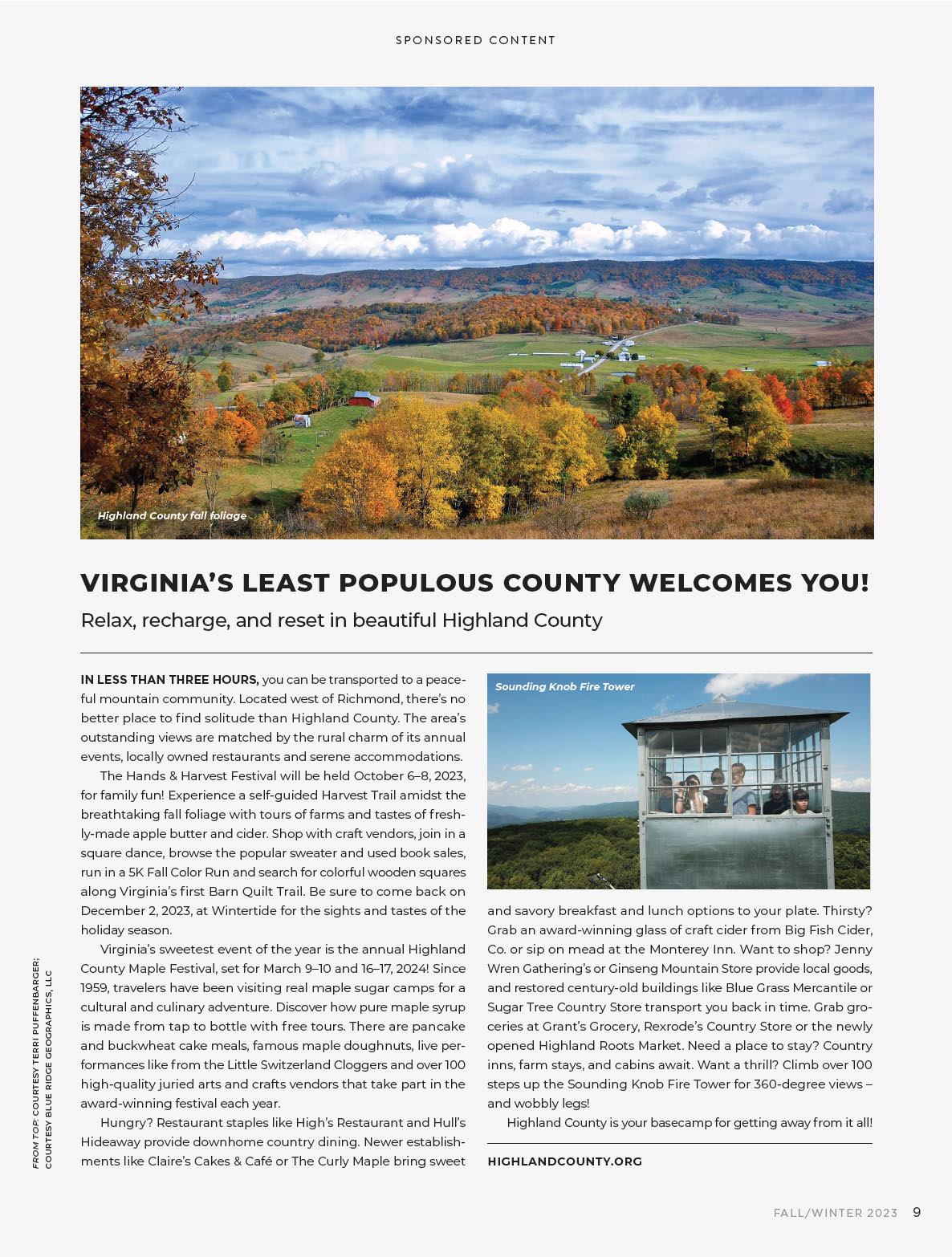
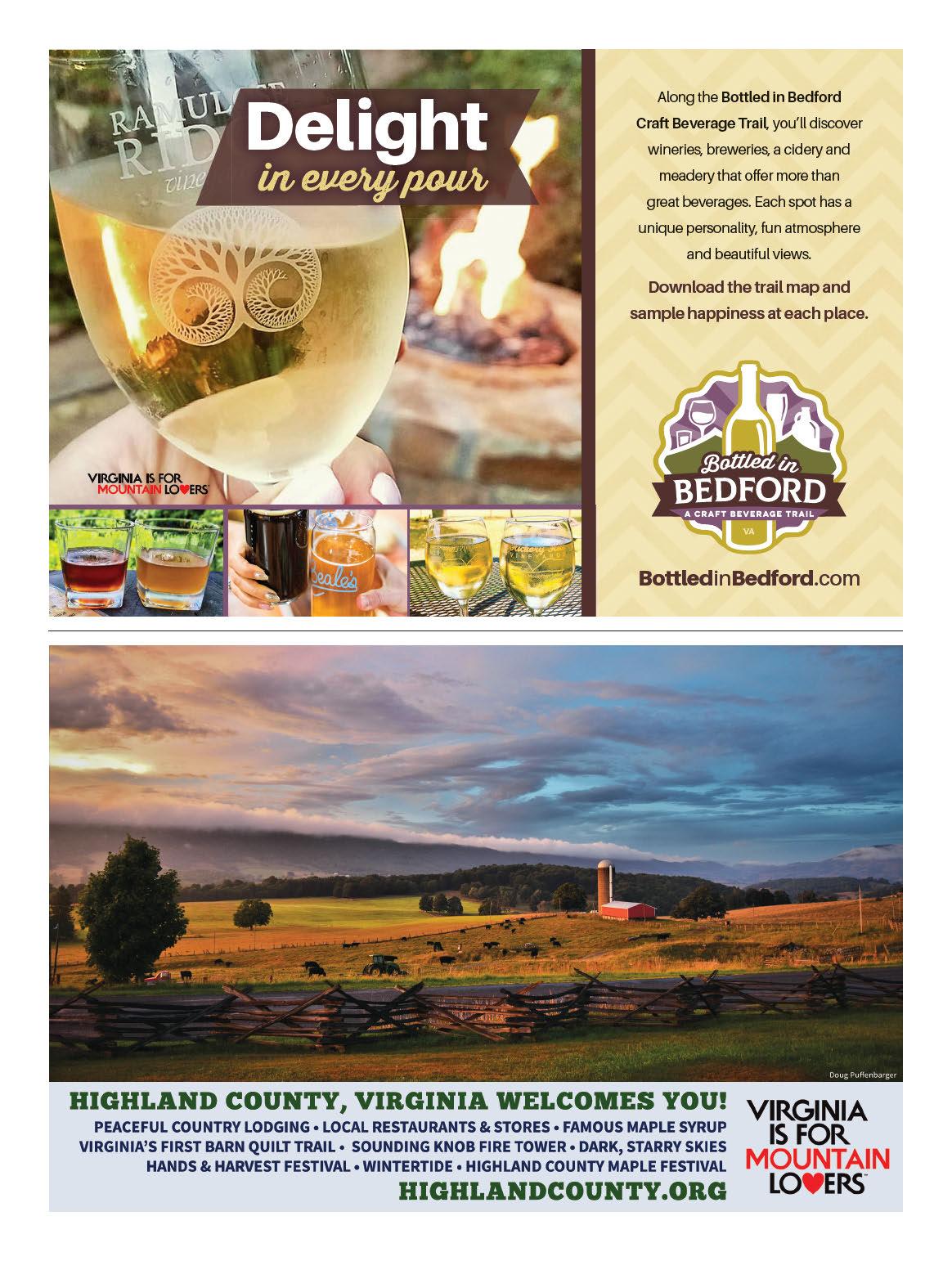



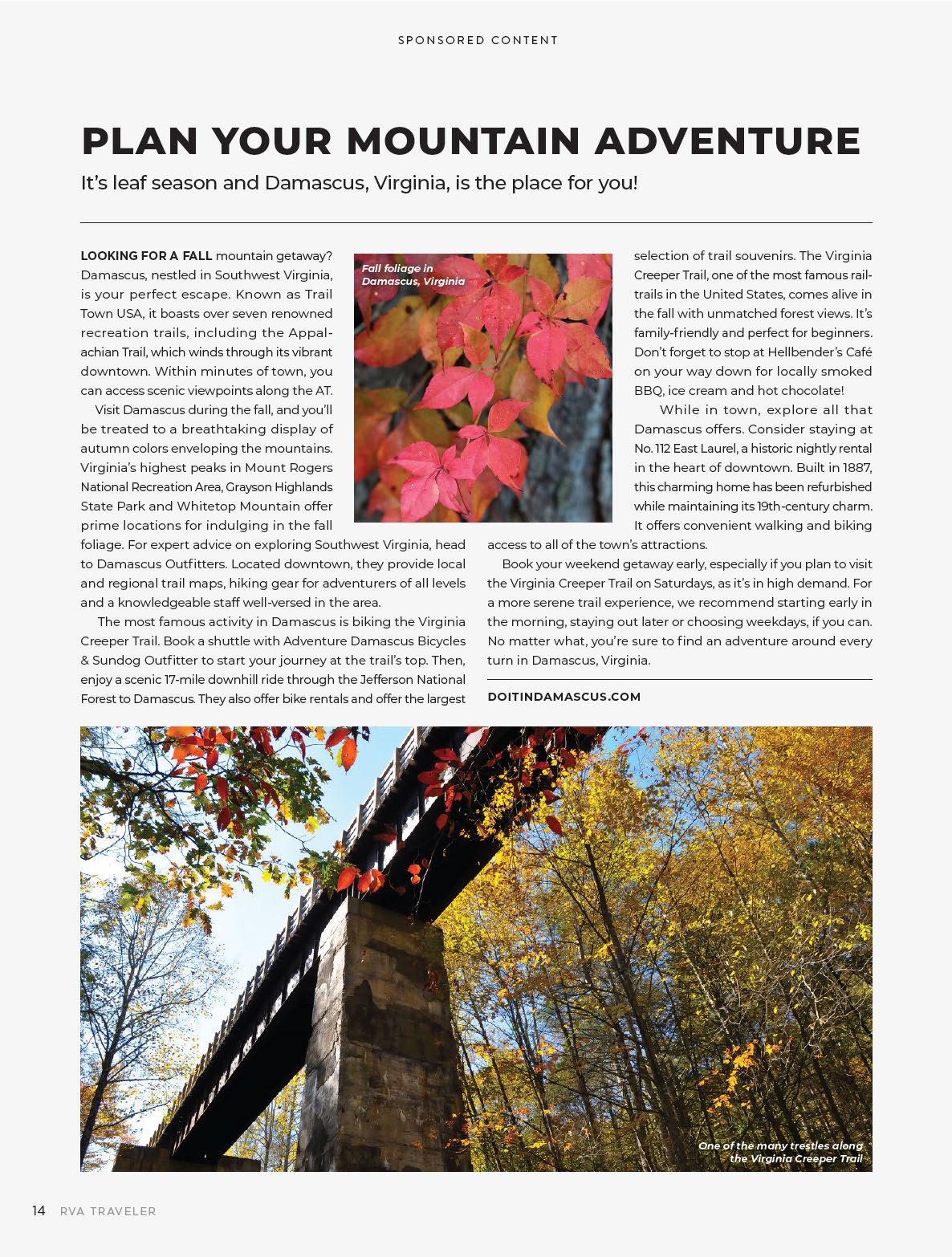


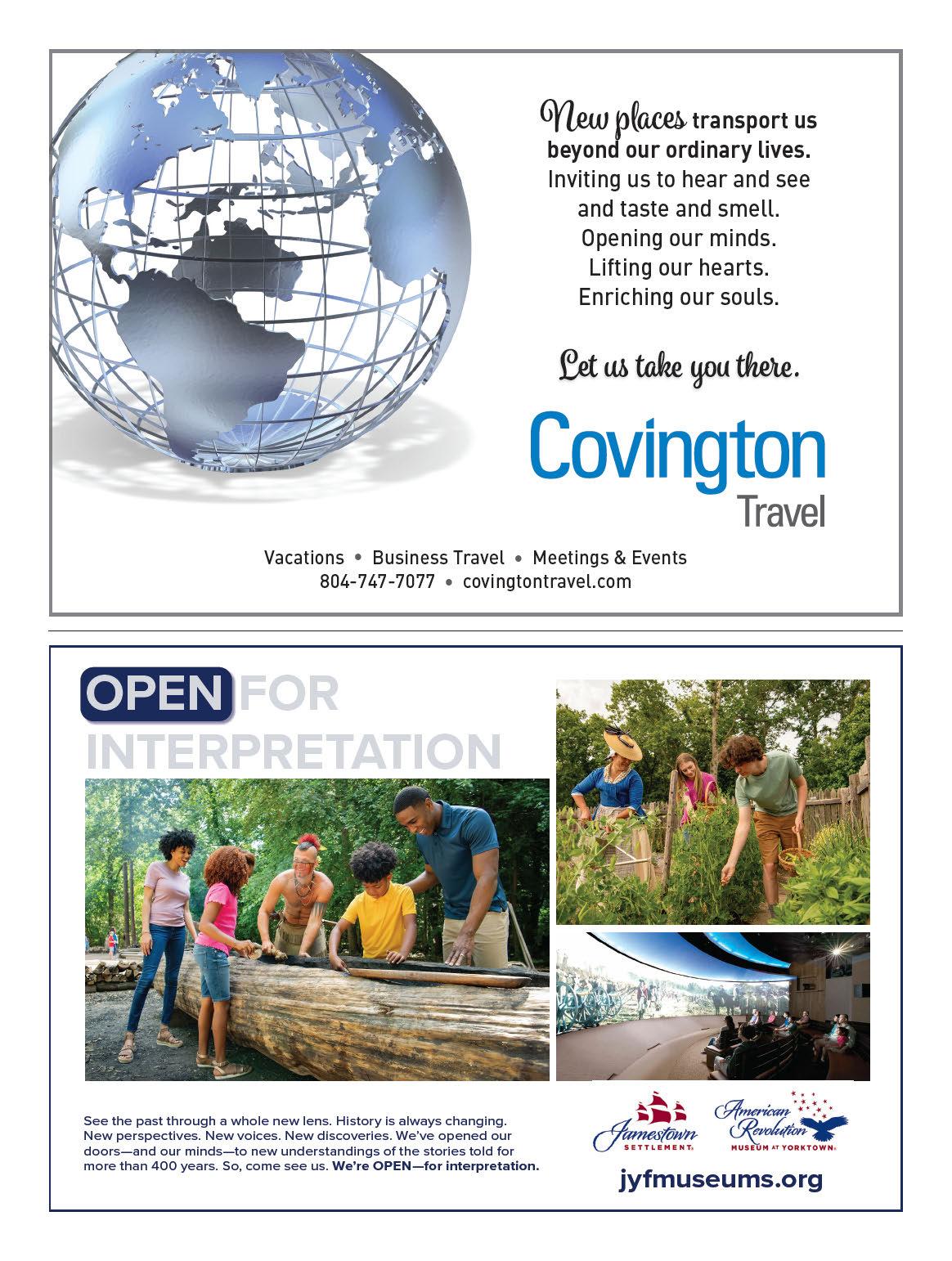

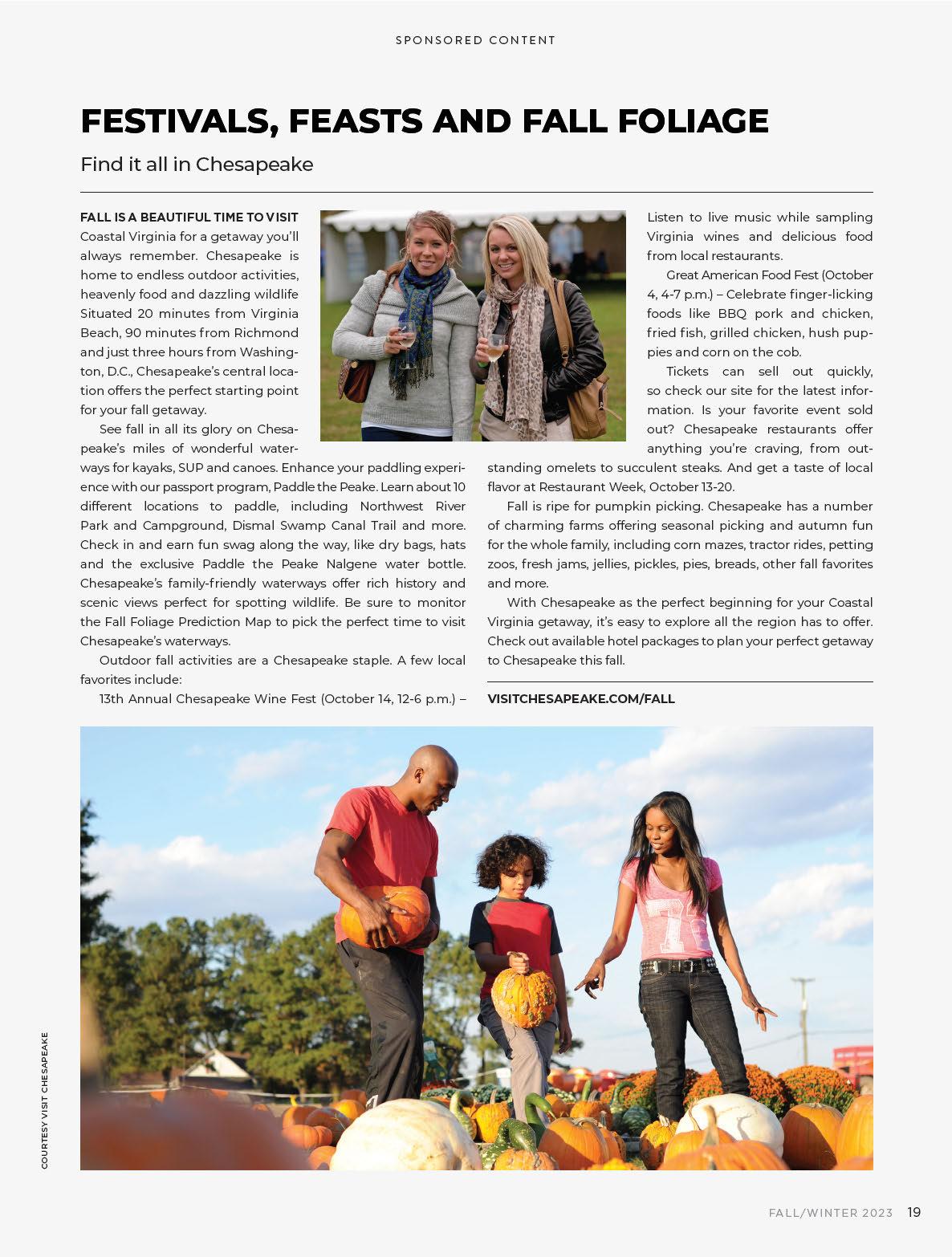

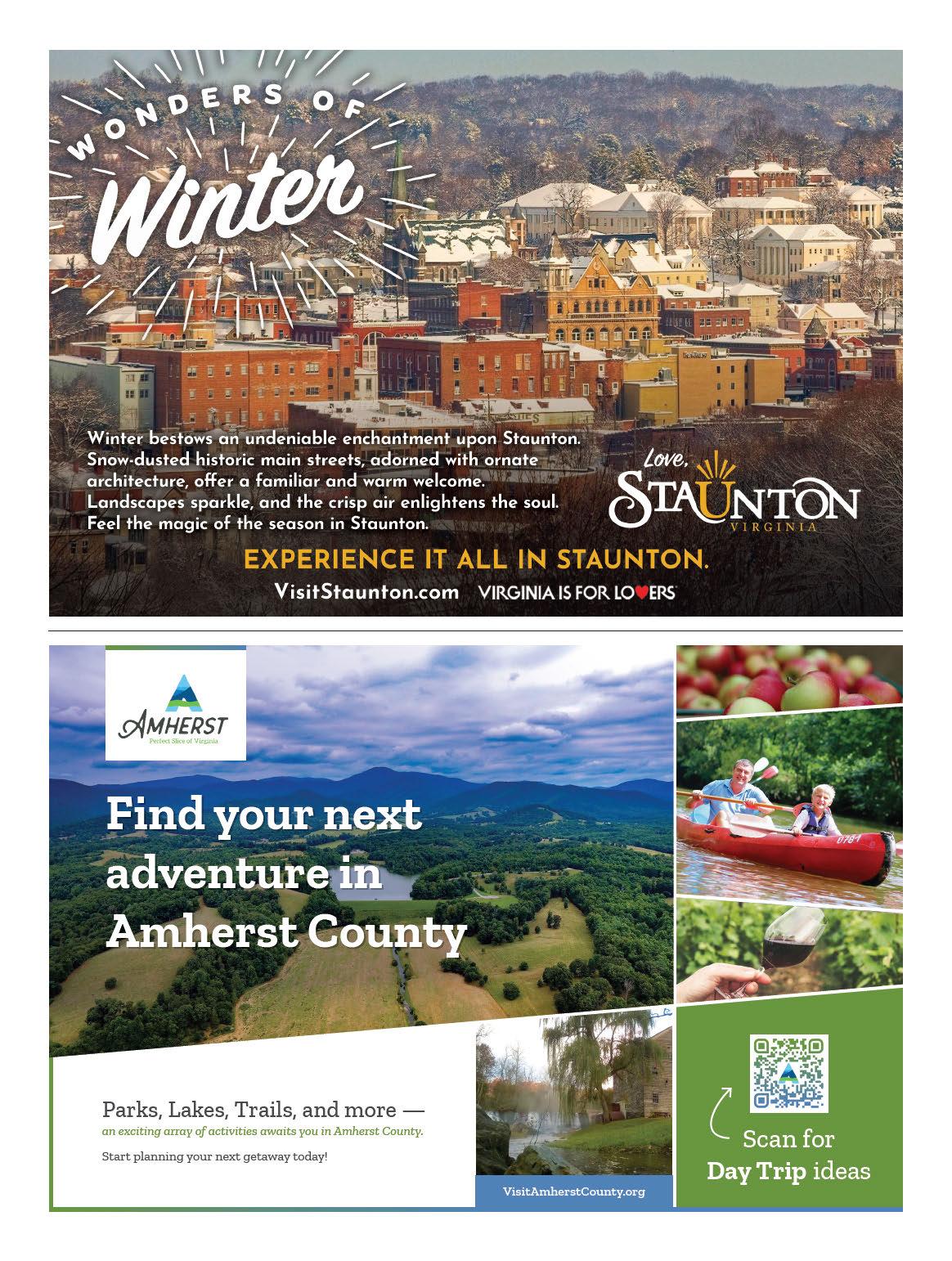

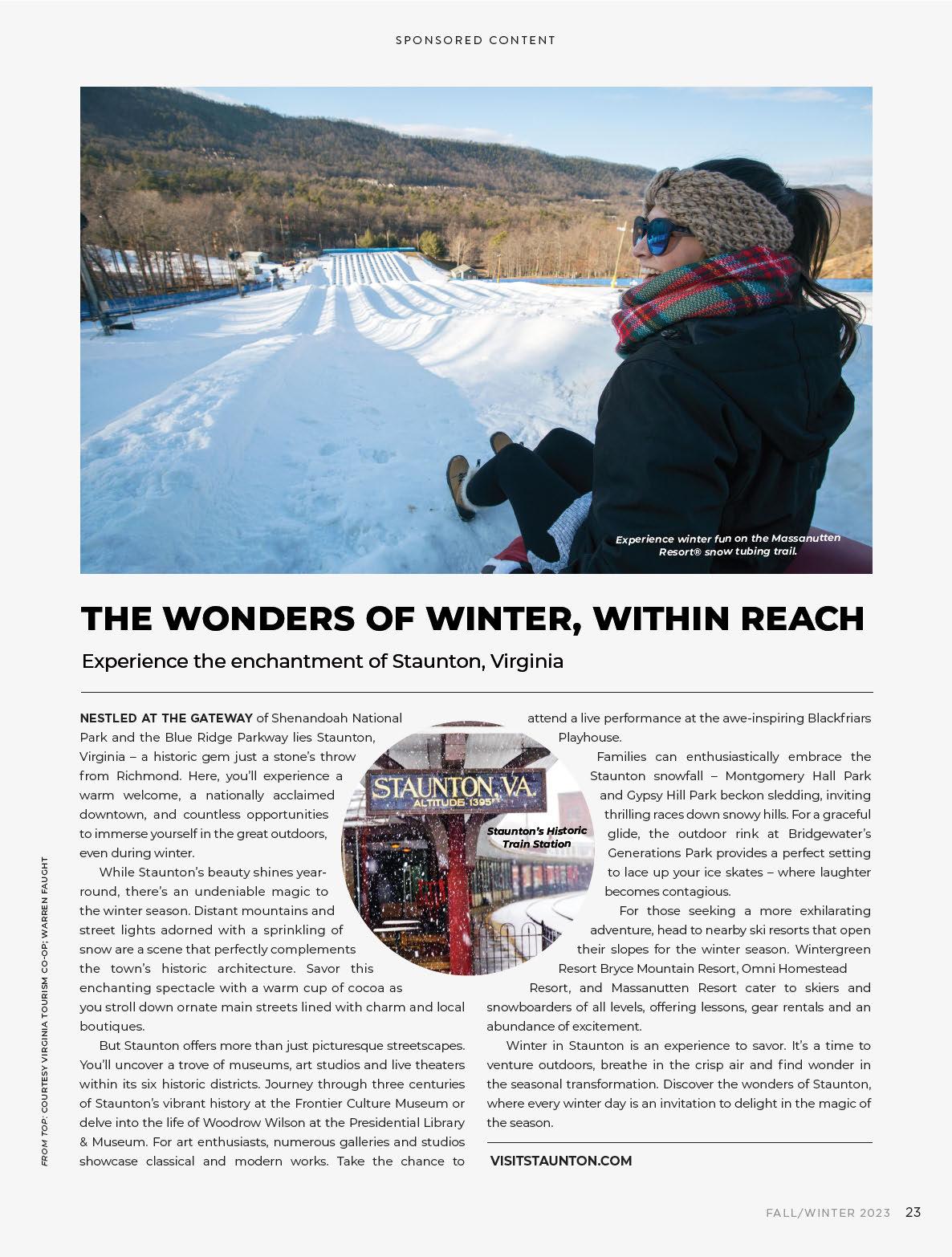

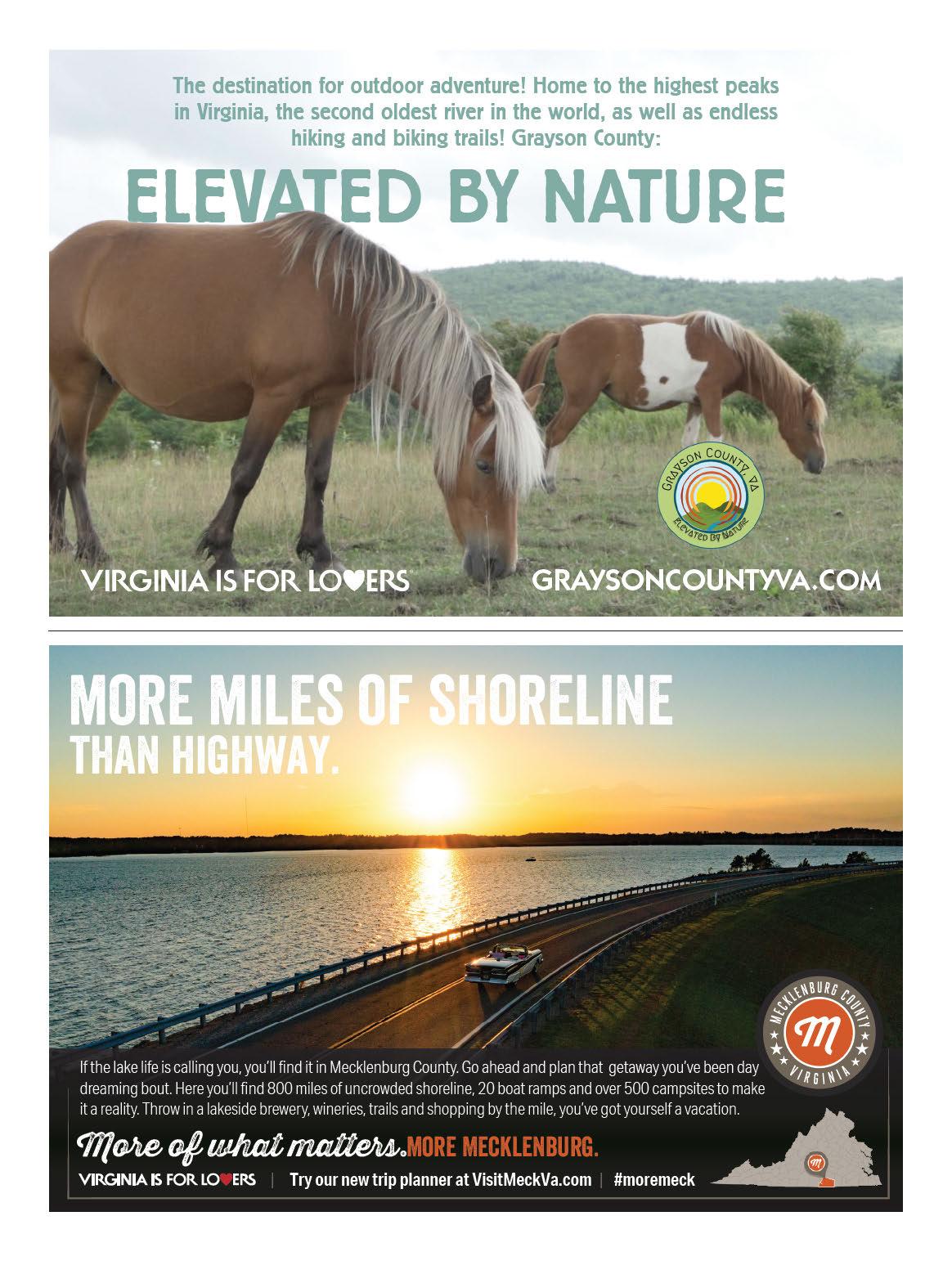

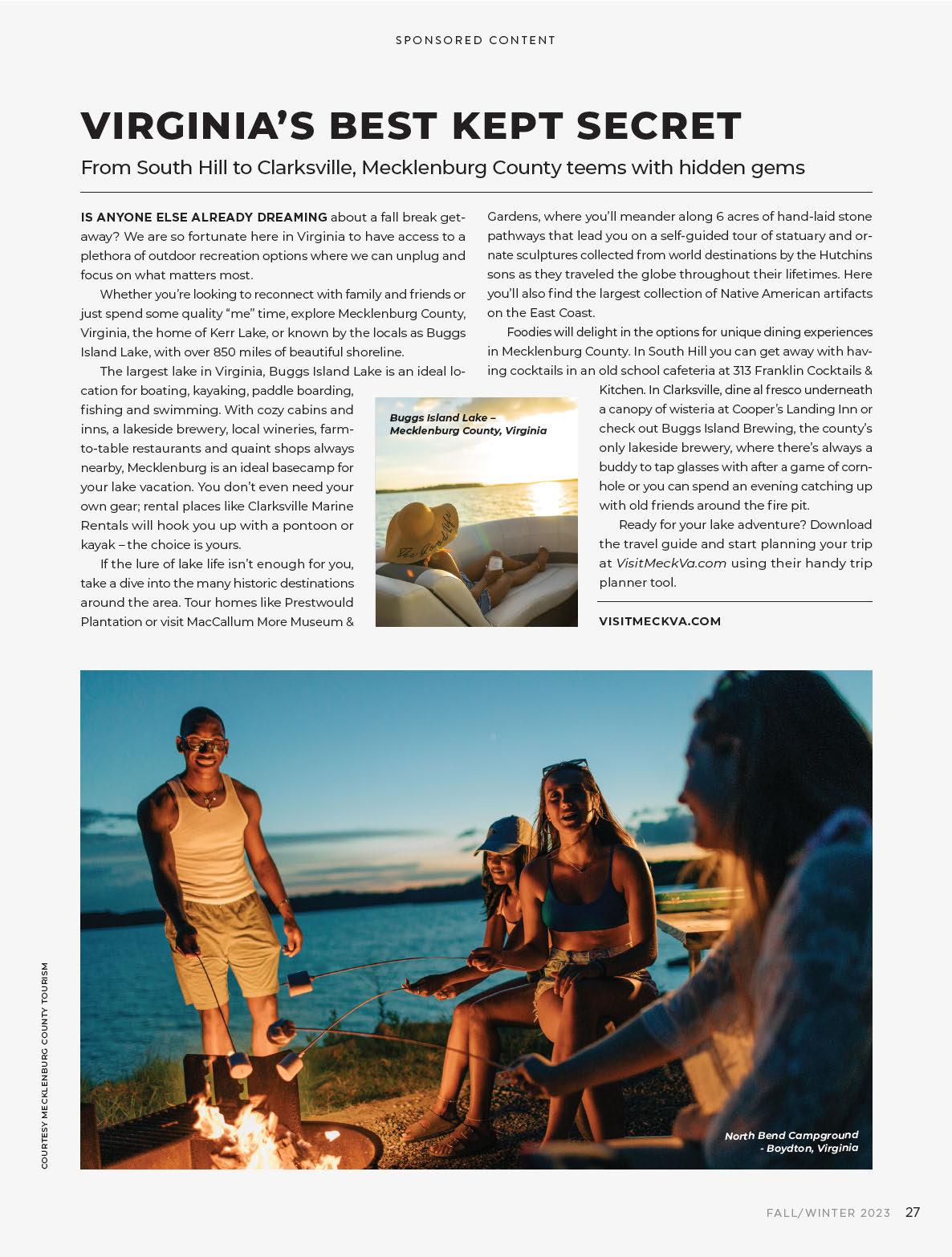
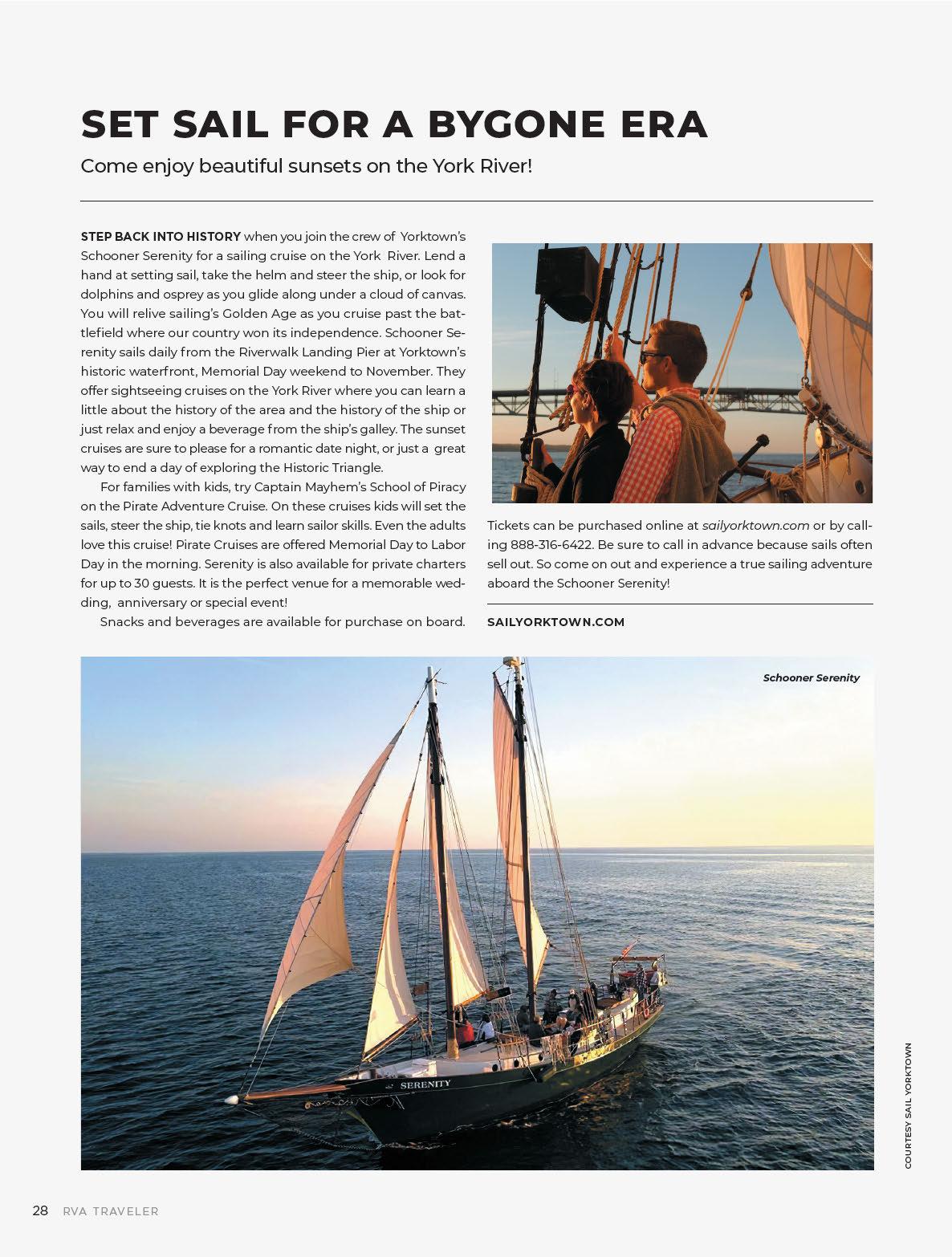

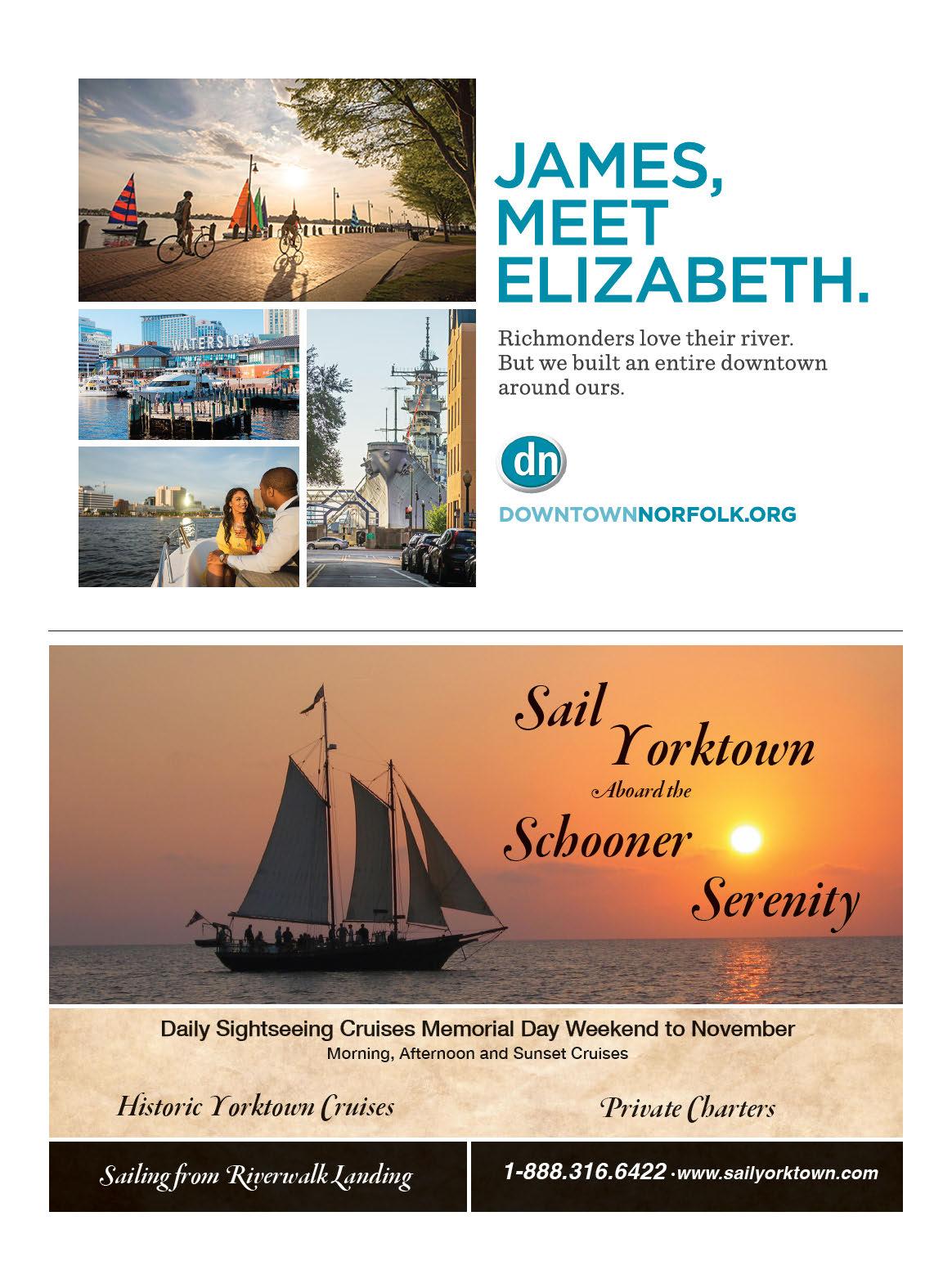

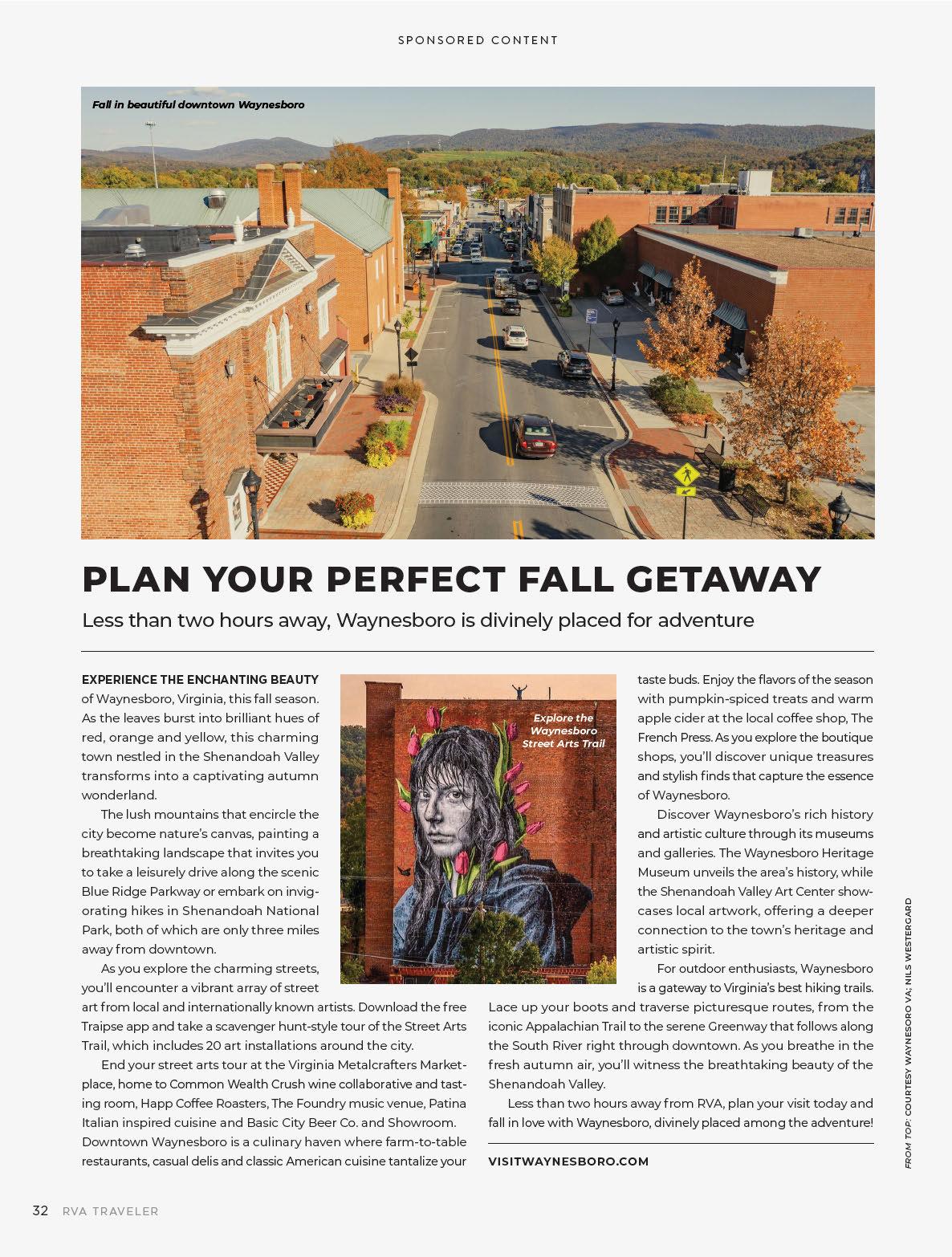
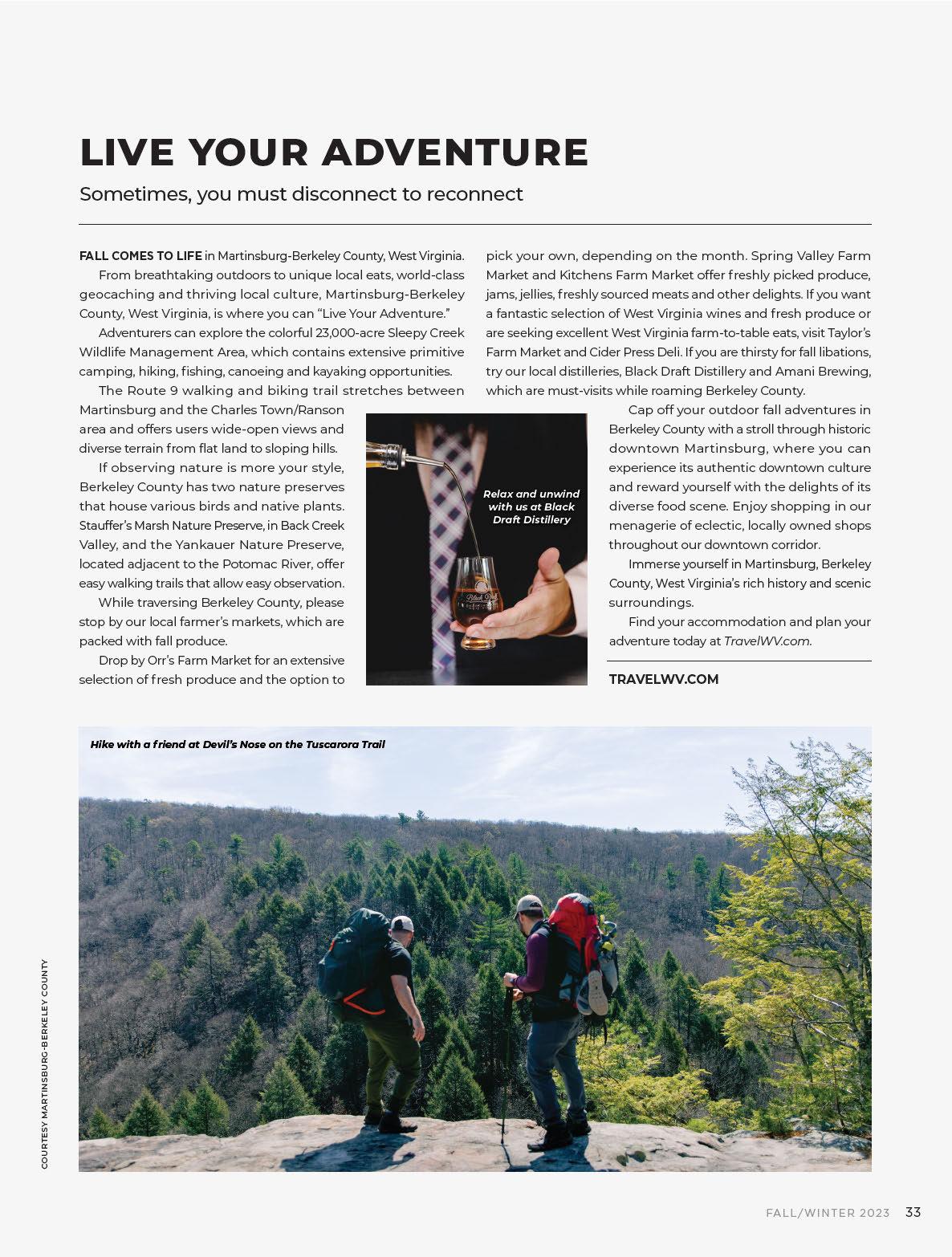


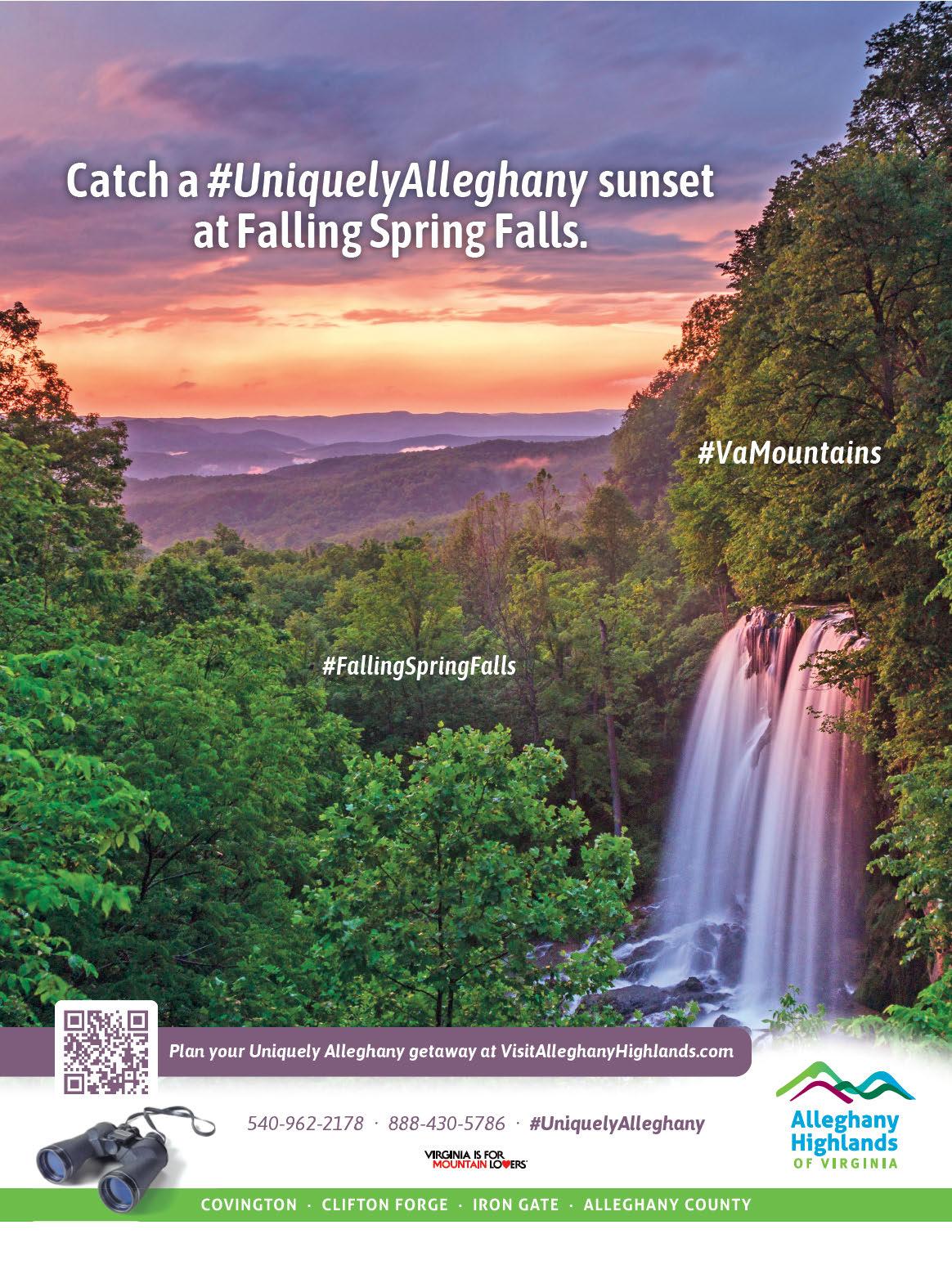








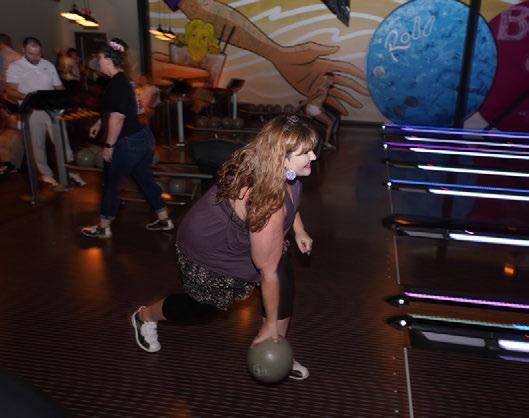
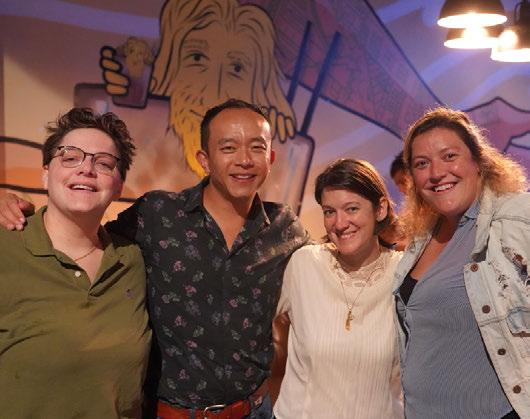
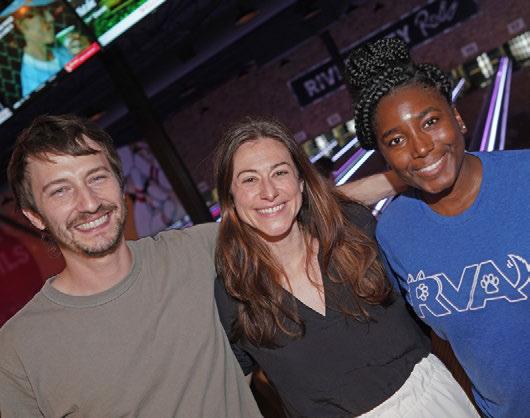

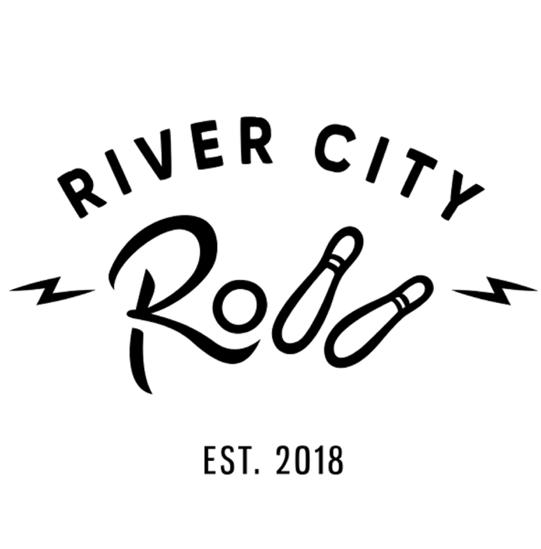
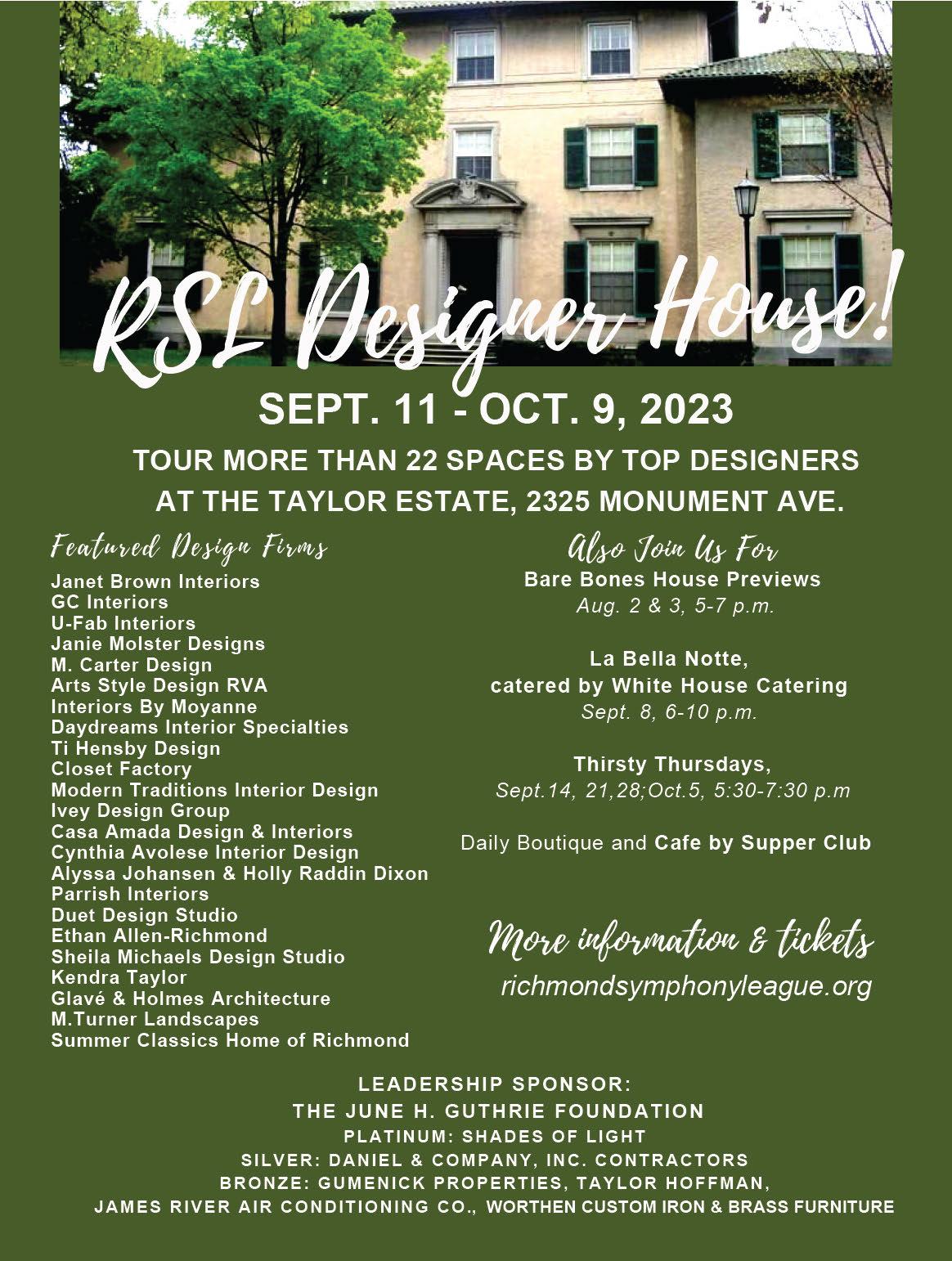
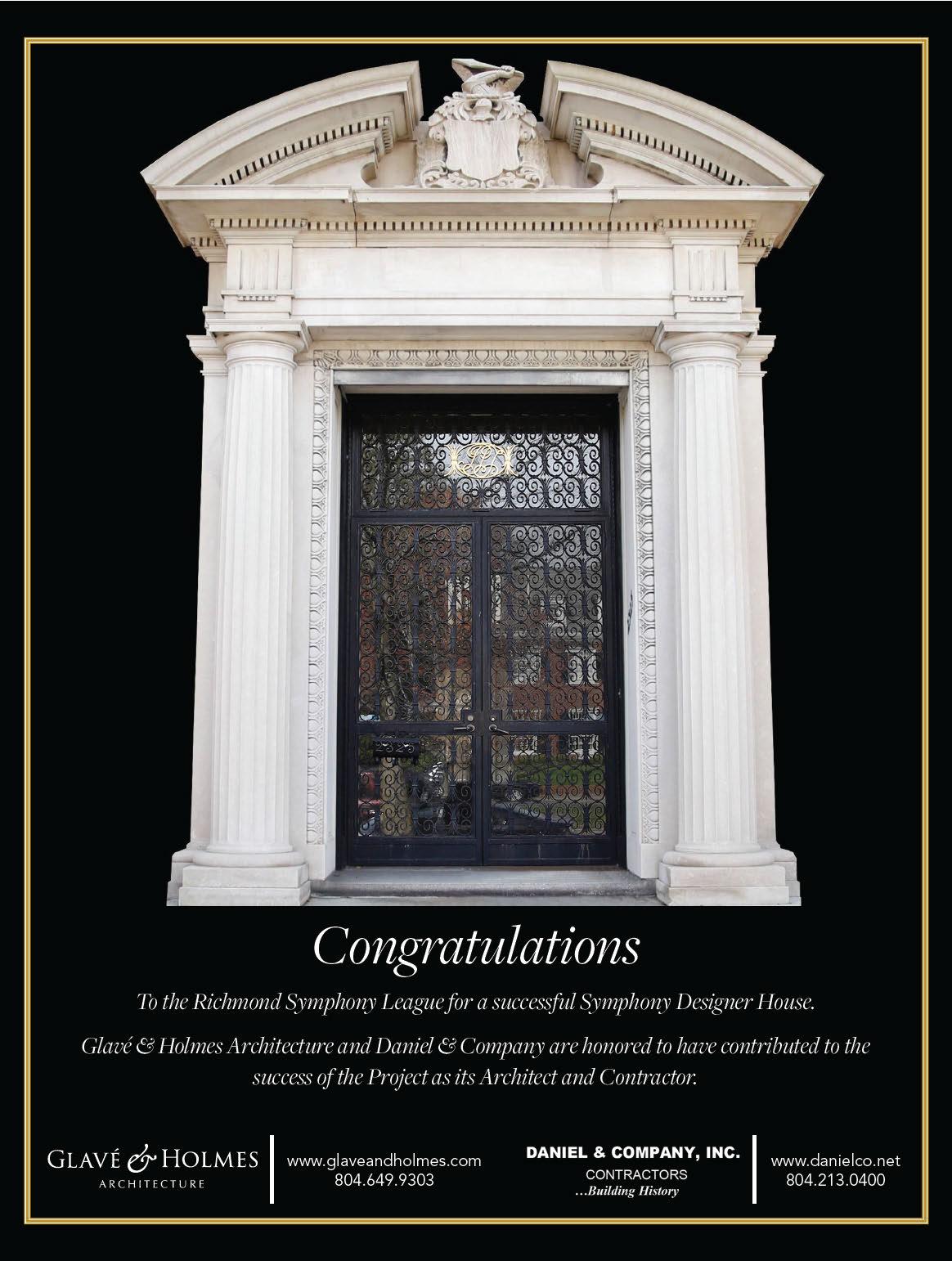

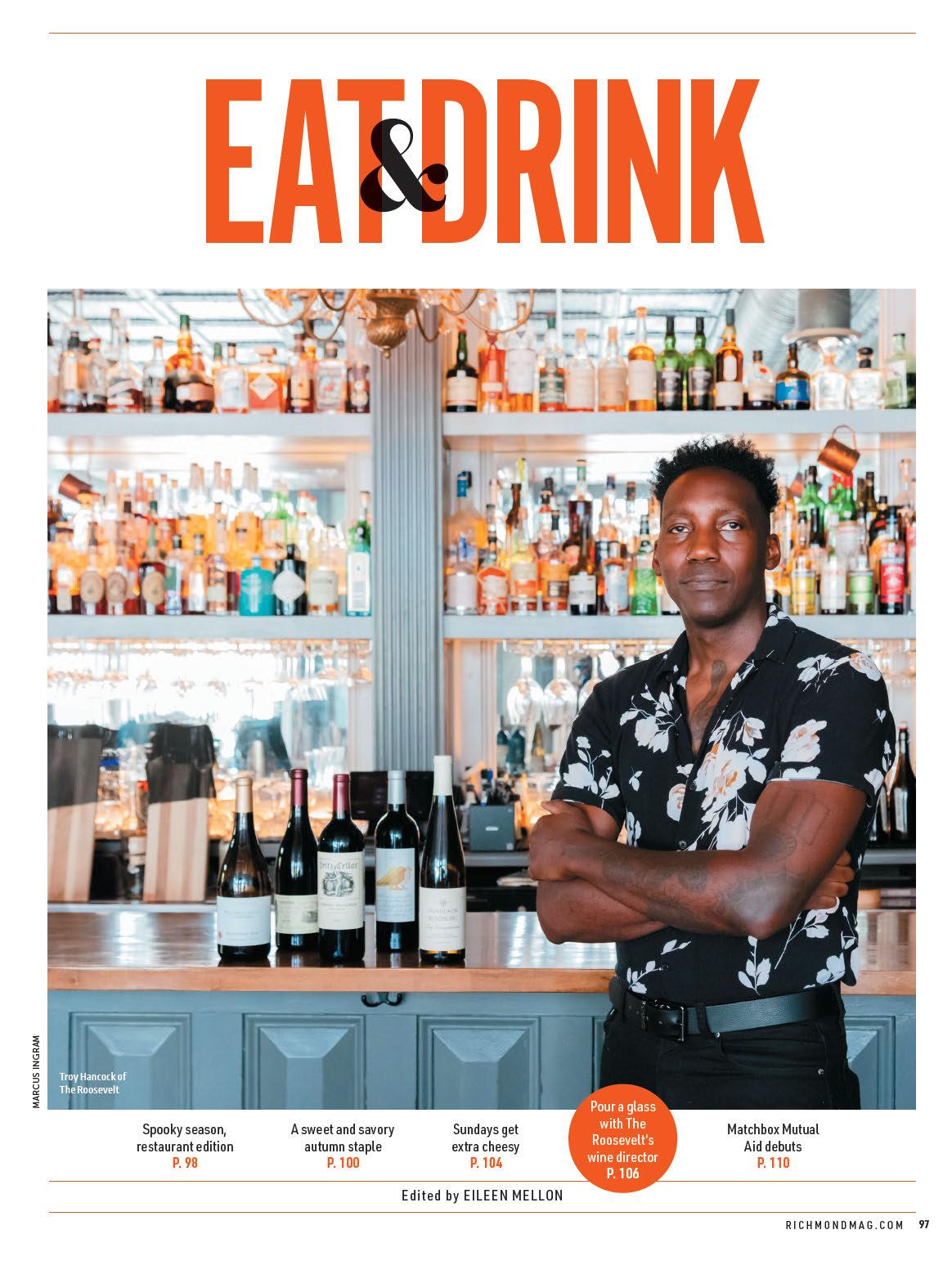
Restaurants see it all. e buildings are vessels of time, with tales featuring characters from owners to diners and employees. If only the walls could talk (though in some cases, they do). But what’s a really old space without a li le occult activity?
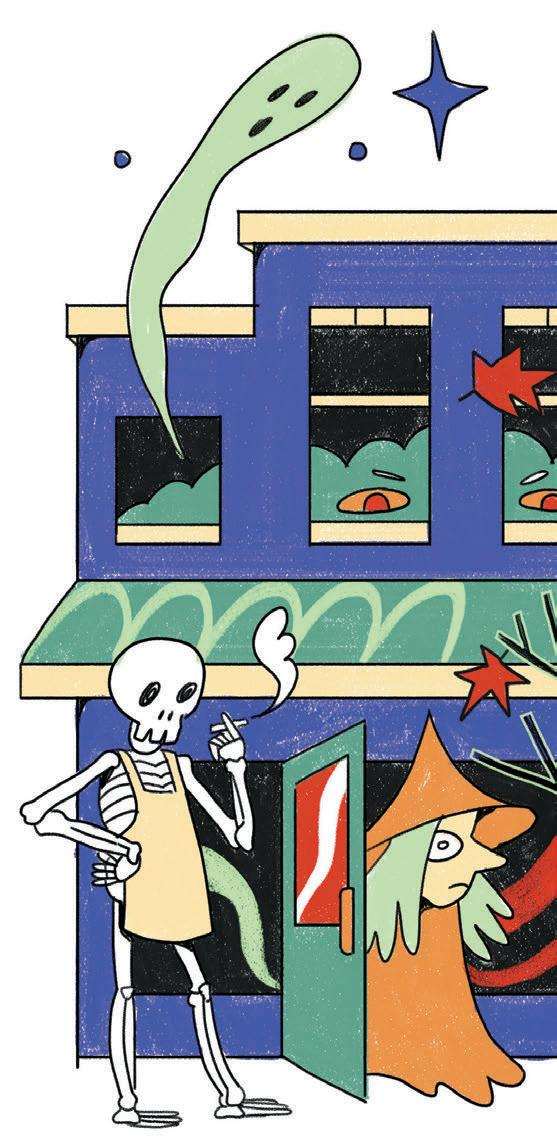
Kevin She eld, co-owner of the forthcoming Smoke & Barrel restaurant at 2329 W. Main St., has a long history with the Fan corner spot. Having bartended there for seven years during its run as Lady N’awlins, She eld recounts a particularly spooky incident.
“I was throwing the trash out, and I saw a shadow from the back door go [toward] the bathroom,” he says. “I went back and opened both bathrooms, and it looked like a dress, like a shadow of a woman. I said, ‘Hey, we’re closed,’ and nobody was there. … I ran outside freaking out.”
At Helen’s, among the oldest restaurants in the city, there have been countless paranormal phenomena observed since its original opening in 1935, from unexplained crashes to sightings of a blue, glowing hand. In 2019, it was deemed the most haunted restaurant in the state by the Food Network, and several ghost hunters have visited over the years.
General Manager Claire Tuite, daughter of Helen’s owners John and Leslie Tuite, recalls the first time the family encountered the ghost of the restaurant’s namesake, particularly the look on her mother’s face as she shared the experience. “I remember thinking I’d never seen
her make that face, and she said, ‘I just saw a woman float into a booth in this dress,’” recalls Tuite, who has been working at the Fan institution for 18 years. ey believe that woman was Helen, a former employee and daughter of the original restaurant owners, and that her spirit still lingers. “Helen is very protective and has mostly calmed down in becoming more comfortable with our love of the restaurant, but in the first few years there were a lot of co ee pots and mugs being thrown, and it still happens from time to time, but it was [once] constant,” Tuite says.
Beyond ghostly sightings and a li le spooky activity, there’s also the Grim Reaper of the dining industry: the notorious restaurant curse. Even if you don’t believe in bad luck, there are undoubtedly a handful of addresses in Richmond that seem to have hosted a rotating cast of churn-and-burn ventures. Is it bad juju? An inconveniently located property?
Nathan Hughes of Sperity Real Estate Ventures has been handling commercial spaces, particularly restaurants, for nearly two decades. He says there are deeper explanations for a food business’ success or failure beyond a li le voodoo.
“I think that it’s really a mixture of things,” says Hughes, who has handled negotiations for restaurants from Neighbor to Soul N’ Vinegar and several properties for Lindsey Food Group. “ ere are places that stay vacant, too, and sometimes because of that stigma of a curse, no one else has been able to make it there, so no one wants to touch it.
“Also, just the location, the tra c flow,
sometimes out in the ’burbs you don’t have a cut through or [you’re] buried in a strip mall and people have to hunt for you — those can all cause recurring issues, even the layout [of a space],” he adds.
The latter may play a role at 203 N. Lombardy St., essentially two spaces in one: a front area traditionally used for dining, and a back space that has previously hosted live music. Balliceaux had a run there from 2009 to 2016, and Bogart’s for decades prior to that. Since then, there has been a two-year or less cycle for the businesses that followed: Flora (March 2017-November 2019), Poor Boys RVA (May
2019-September 2021) and Brun (March 2022-July 2023). Sprezza, an Italian restaurant previously in Shockoe Bo om, is set to debut in the space later this year.
“I don’t necessarily believe in things such as cursed buildings and whether or not they can hinder a concept from taking o ,” says Angela Petruzzelli, owner of Sprezza. “ is is especially true in a city like Richmond, where real estate is limited. Restaurants are volatile businesses; they work and don’t for millions of di erent reasons.”
Hughes believes properties can overcome their transient reputations.
Located near the intersection of Broad and Belvidere streets, 506 W. Broad St. had also earned a reputation as a rotating space. Beginning in 2017 it was home to Tiny Victory, Yaki, Boka Tavern, and Antler & Fin, but now e Riviere, known for its lively brunches, has been operating there since 2021.
“I think there’s a code to each one of the spaces we can point to that were considered cursed over the years that have defied that curse at di erent times or are defying it now,” Hughes says.
Another of those supposedly jinxed spaces is the building housing El Pope,
1731 W. Main St. Formerly the location of eateries including Belgian concept Brux’l Cafe, Dogwood Grille & Spirits, Peacock’s Pantry, and Mainstream Bar & Restaurant, the site’s current tenant has been there nearly five years.
“I think that if anything lasts five years or more, that’s a pre y long time; it means they were through at the very least [a] one-lease term,” Hughes says.
Whether these events — ghostly and otherwise — are a function of the paranormal or just the inherent struggle to keep a restaurant going, their tales have become part of RVADine lore. R


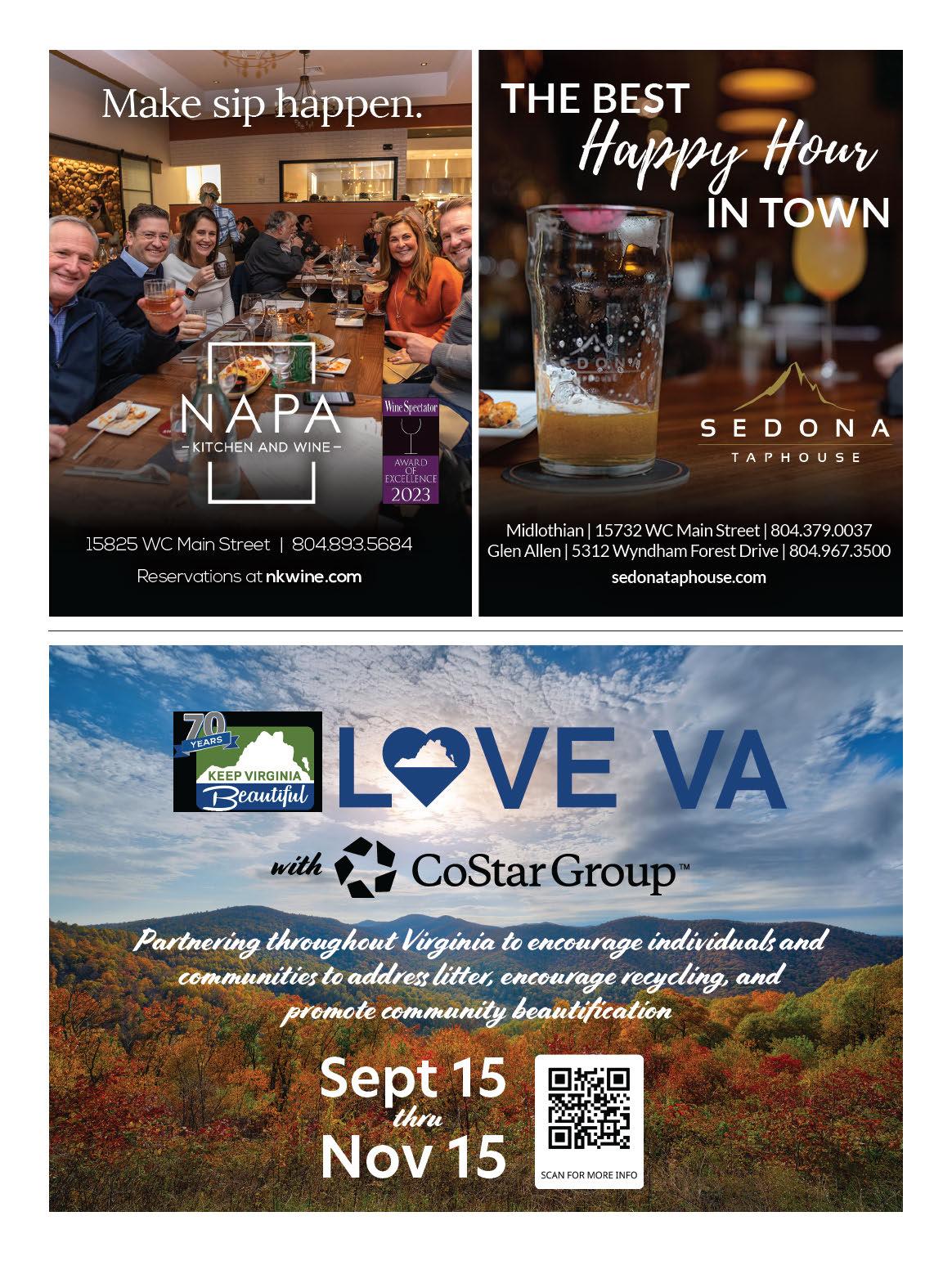
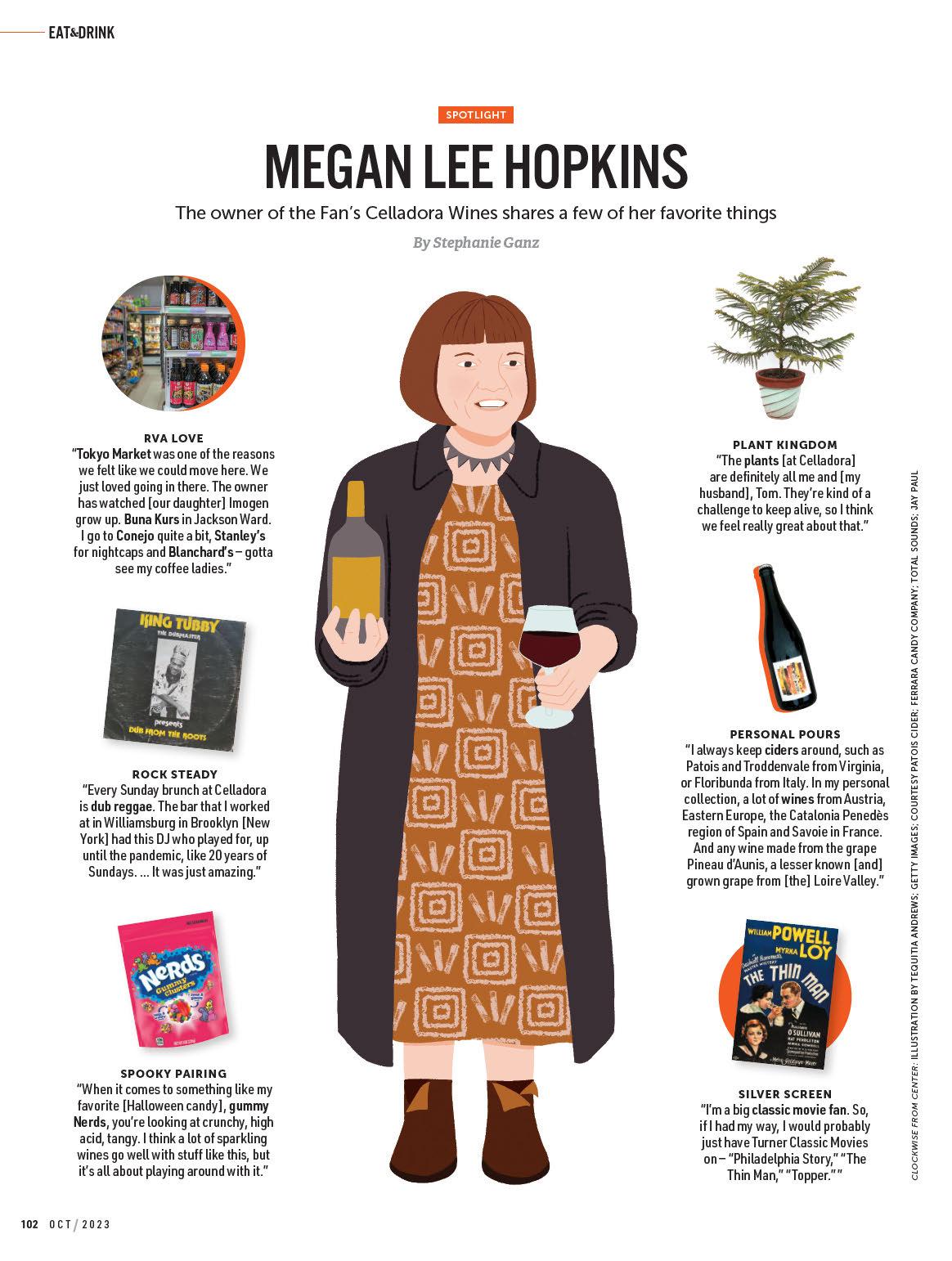
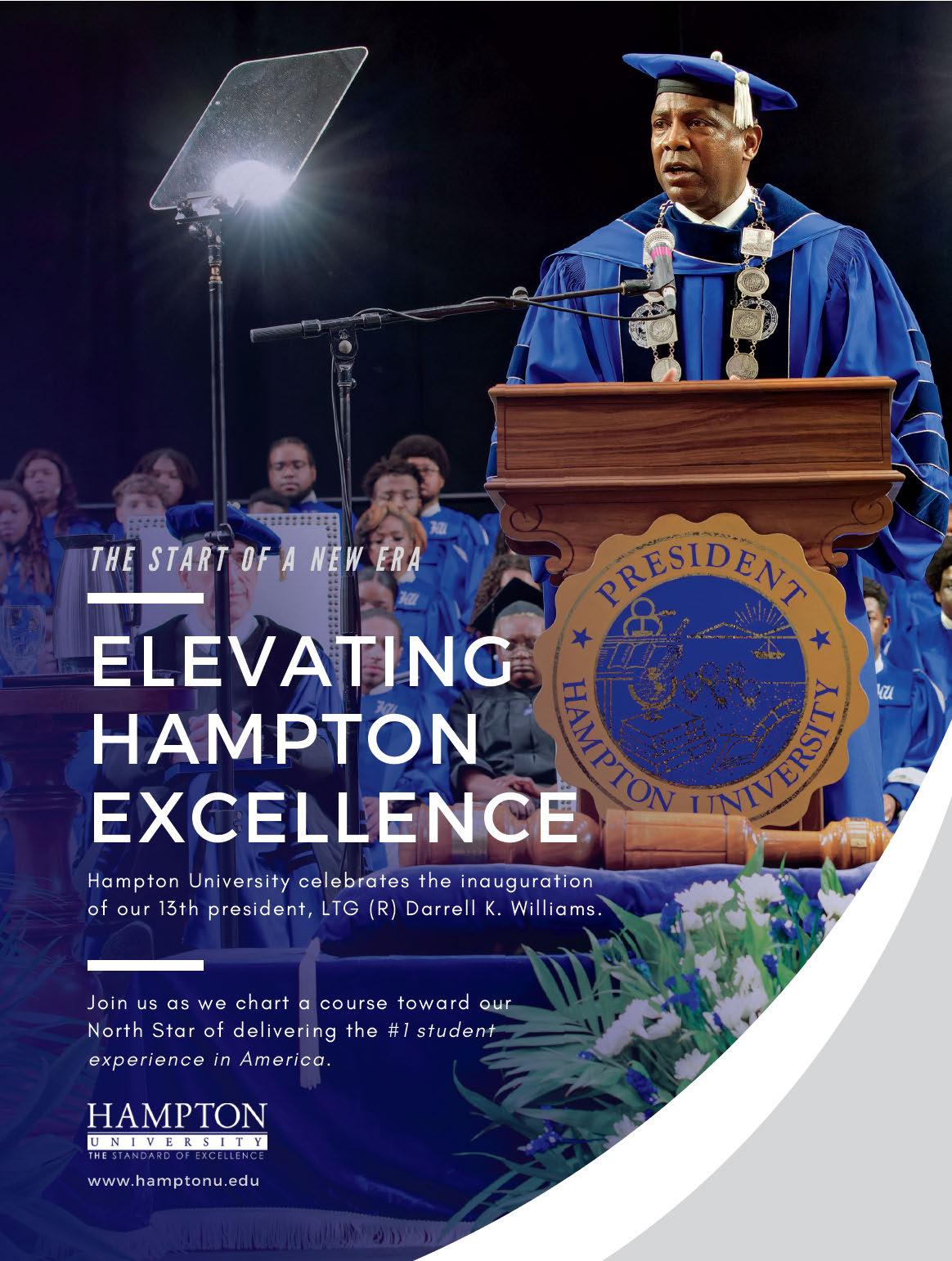

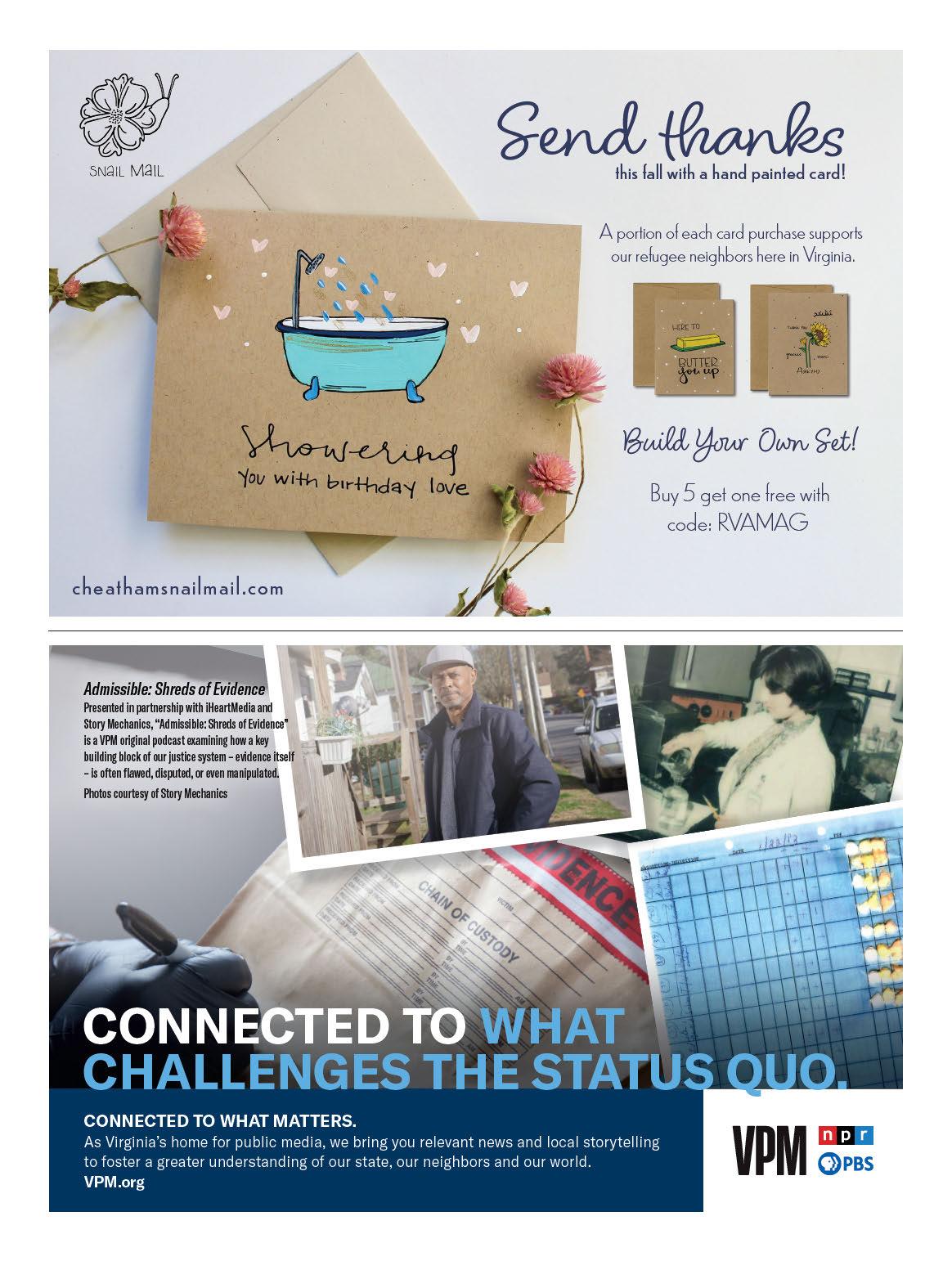
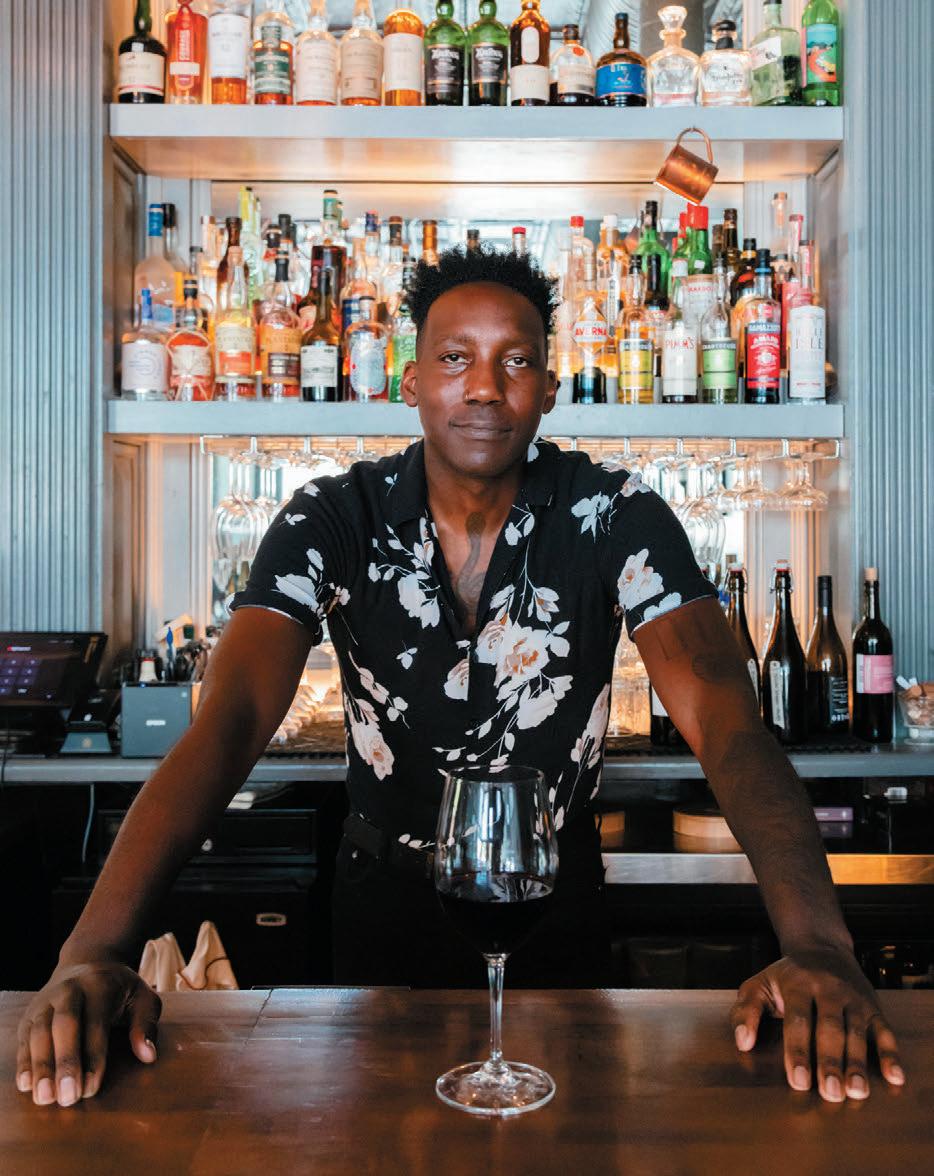 By Eileen Mellon
By Eileen Mellon
A self-proclaimed “wine traditionalist,” Troy Hancock has a serious soft spot for cabernet sauvignon. The classic, robust red made such an impression on him that The Roosevelt wine director saved his first bottle as a treasured souvenir. At the restaurant, Hancock chooses wines that showcase both time-honored vintages and modern small producers. We caught up with the New York native to talk selection process, his cab-sav loyalty and industry shifts.
Richmond Magazine: Where did you grow up and how did you land in Richmond?
Troy Hancock: I grew up in New York City in Queens. When I was 13, we moved to Raleigh [North Carolina]. My first job was [as] a food runner. I went to school for agriculture at NC State. After college I was working landscape design; I love plants and worked at a nursery for four years. I eventually started getting into restaurants more. I like the fastpaced energy of it and the interaction. Even though I’m kind of a loner person, I like being around people. I got that from being in restaurants. I moved out of Raleigh to Richmond in 2018. I wanted to be somewhere where there were a lot more restaurants. I started working at Perly’s for a little bit and then found The Roosevelt.
RM: What was your “aha!” wine moment?
Hancock: I got introduced to wine at a French bistro in Raleigh. We would have contests at work to see who sold the most bottles that night. I was like, “All right, let’s go,” and sold the most and got to take home a bottle. It was a 2012 Chateau LaplagnotteBellevue Saint-Émilion Bordeaux. I opened it and was like, “I’ve never drank wine like this before.” It blew me away. I got hooked. I was 24 at that time and was like, “I have to keep learning about this.”
RM: What’s a wine on The Roosevelt’s list that excites you?
Hancock: Foppiano [Vineyards] sauvignon blanc; we’ve had it for a few years, and it’s not on any list I’ve seen. Another favorite of mine is Red Mountain Syrah from Hedges [Family Estate]. Also Heitz Cellar, one of my favorite all-time wineries: I love that they never changed how they made wine. They’re true to traditional stuff, and the co-owner now is African American, and he’s one of the few Black CEOs in Napa Valley that owns a legacy of a cellar like that; it’s legendary.
RM: Reflecting on your time in the industry, what’s a takeaway?
Hancock: A lot of younger people have interest in drinking wine and having it with dinner and not just bringing it to a party; people are learning more about it and trying to drink certain styles of wine. It was always the older dudes, and older white dudes, getting into wine, and now ... the young community getting into wine has really elevated it.
RM: What wine style are you most drawn to, and what is in your collection at home?
Hancock: Cabernet sauvignon. [Laughs] It’s so funny, because everyone is like, “You’re so basic,”
and I get that, but it literally is a wine that has so much power. You can grow it pretty easily, but you can really taste the difference between a lot of cabernets, and you tell the craft. It is the best wine to drink aged because it shows a lot of complexities. What I usually have in the mix is probably Bordeaux, Napa cabernet, riesling and white Burgundy. I’m very drawn to the classic stuff, I’ve been trained with a classic palate, so that’s what I know best. I admire it, and I love the history of it and the traditionalism of it.
RM: What is the thought process when choosing wines for a restaurant menu?
Hancock: You have to look at the business aspect of it — crowd-pleasers — and then you can get into the stuff you like on the side. Also [you] always have to be thinking about what can elevate the beverage program or [bring] in something exciting. Usually, I’m begging and annoying my reps like, “Can you find this? What’s new? What’s around here?” I’ll look up a wine they brought in and look at wineries around that area. They’ll get motivated, and they’re like, “I found this small producer, and they only make 2,000 cases” — that’s how I find some of the best stuff I’ve tasted, begging them to find me new small producers, and they’ll bring it in and do the research. R
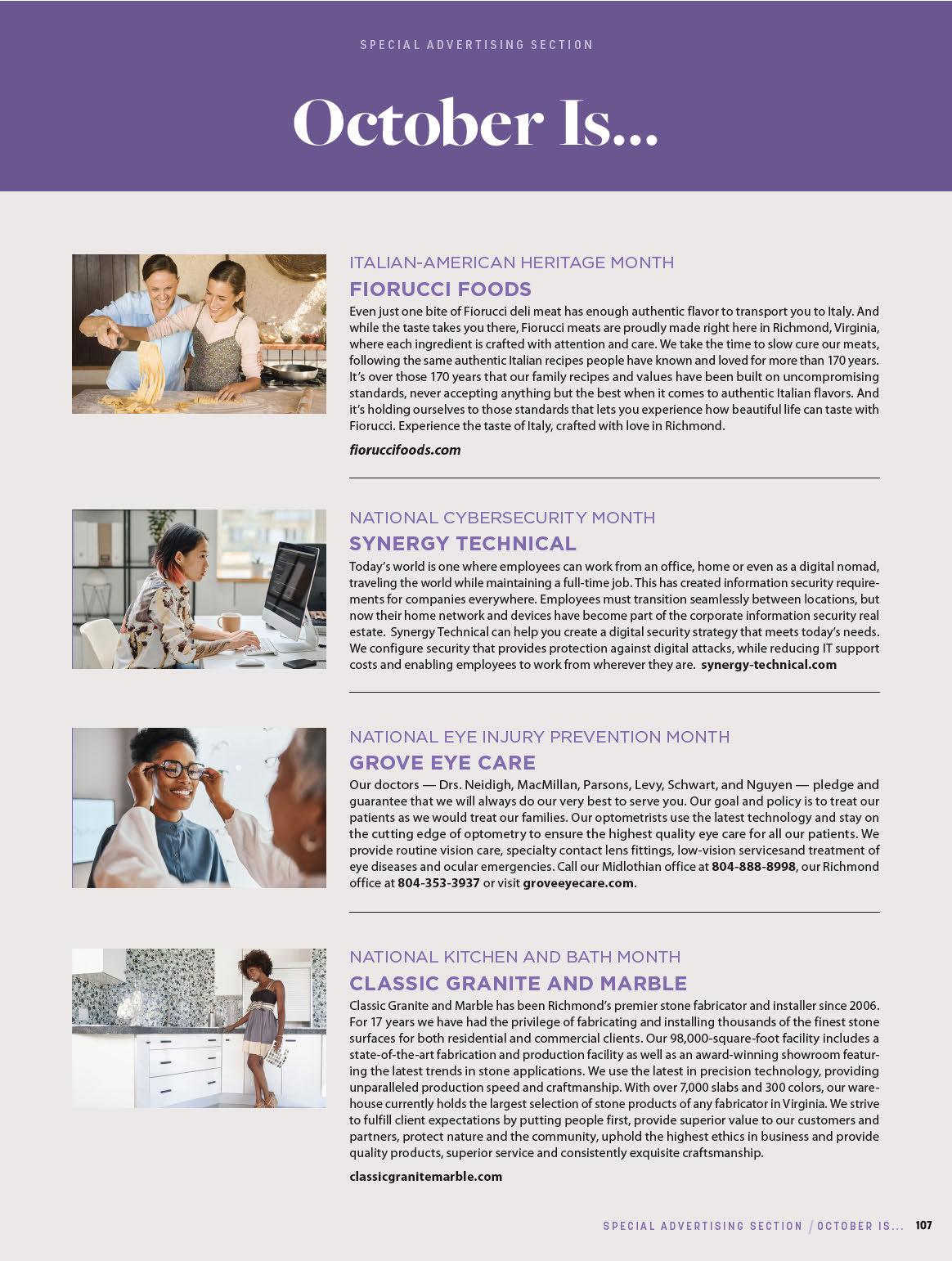
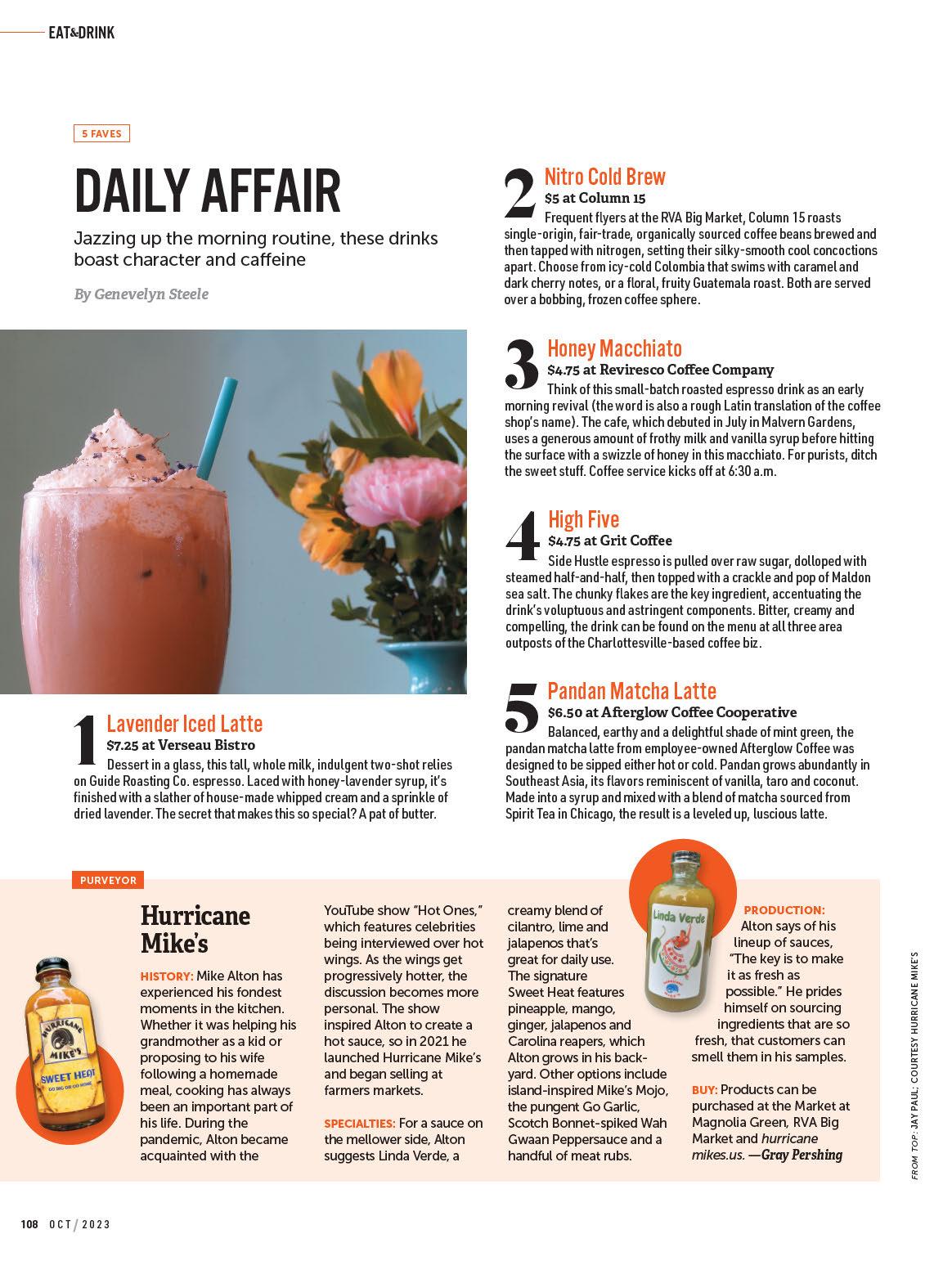
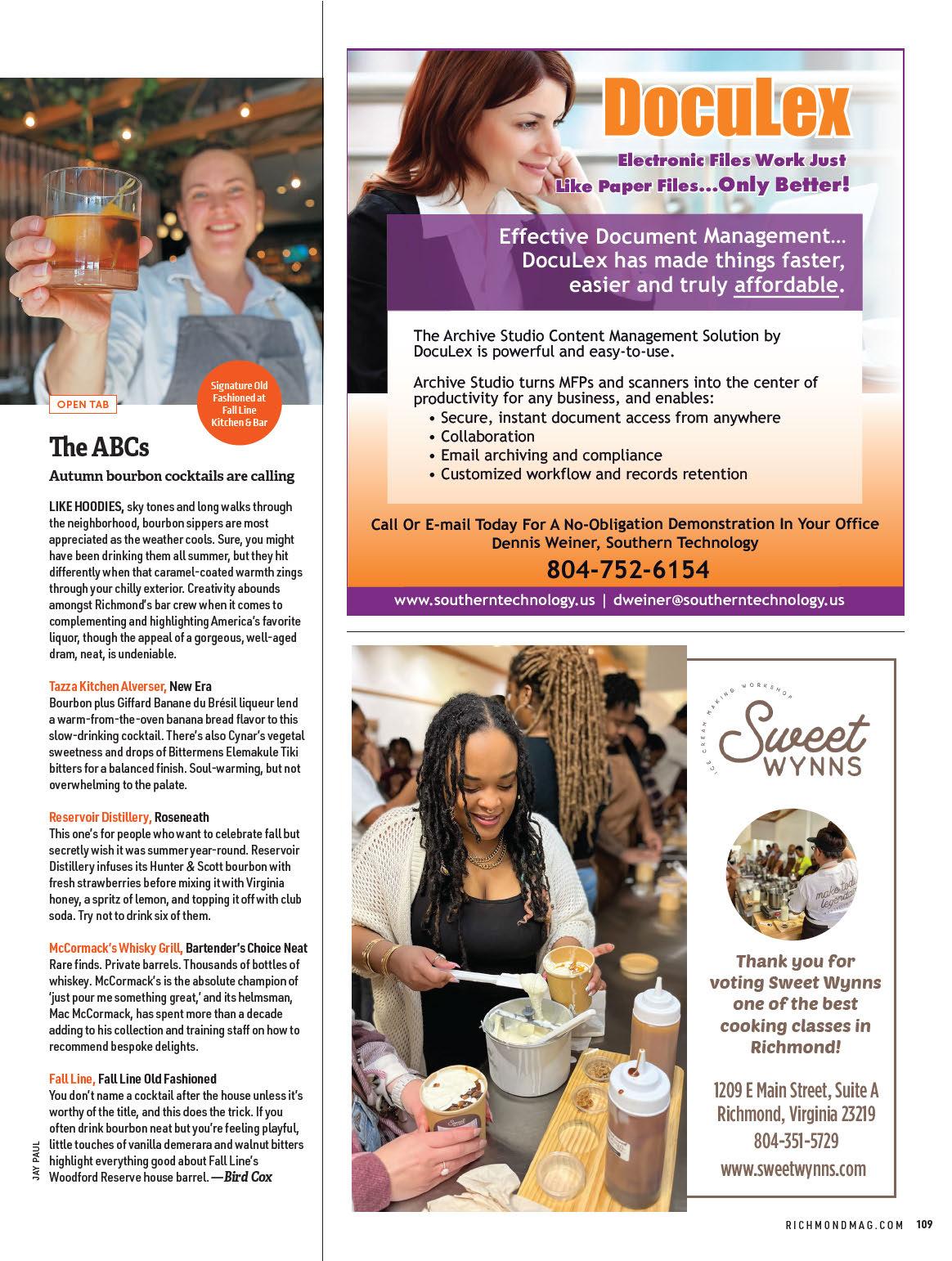
At 2919 North Ave., a newly painted black building is emblazoned with the words “Matchbox Mutual Aid” in block le ers. Above the door is the phrase “Food is a right, not a privilege.” For the two teams behind this new venture, RVA Community Fridges and Food Not Bombs, the site will be the pillar of the work they do to feed Richmonders in need.
“We believe anyone should be able to feed themselves, regardless of their ability to pay,” says Aaron Bish, a volunteer with Food Not Bombs for nine years.
A scrappy, grassroots, volunteer-run mutual aid group with chapters nationwide, Food Not Bombs has hosted a weekly food share in downtown’s Monroe Park for decades. Last year, members were forced to relocate from the building where they worked
and cooked, leaving them looking for a new space.
“We decided to reach out to other mutual aid organizations,” Bish says. “For us, being able to a ord a space for ourselves [on our own] wasn’t really realistic.”
Using her apartment as an o ce for nearly three years, RVA Community Fridges founder Taylor Sco wasn’t necessarily looking for a building, but she had maxed out her Shockoe Bo om one-bedroom. Since placing the first refrigerator in Union Hill in January 2021, Scott and a small crew have introduced a dozen of the free-food installations throughout the city, with more in the works, in addition to advising people in the Ashland, Petersburg and Hampton Roads areas about how to start their own programs.
Located in a neighborhood considered a food desert, Matchbox Mutual Aid is reviving a space that

once housed Northside Foodland, a grocery store that opened in 1986 before shuttering in 2018.
Aiming to launch this month, the new space will serve as a hub for both organizations, o ering a place to process inventory such as donations from farms and other businesses, prepare meals for weekly food shares and stocking the fridges, and hold meetings. e groups also aim to host educational culinary classes, knife-sharpening demos and other events.
e hope is that the centralized location will make it easier for community members and food and beverage professionals to volunteer.
“It will work a lot better to have a shared space where people can come together and cook, which is what Food Not Bombs has done for the 30 years it’s been in Richmond,” Bish says. “We’re happy that this is finally happening, and hopefully this bigger space will allow us to distribute more food.”
Mirroring the groups’ mutual aid work in the community — creating networks that can fill in the gaps through solidarity — the partnership is a natural merger of old and new movements.
Sco says they are working to transition Matchbox Mutual Aid into a nonprofit. By acquiring 501(c)(3) status, they can make the most of funding opportunities. “I hope that will solidify us with paying rent and not having to consistently fundraise [for that],” she says, adding that they could then direct the resources elsewhere. “Really just trying to figure out ways to get money from people that have it, to get it to us, to give it to people who definitely need it.”
In August, RVA Community Fridges launched a campaign on Open Collective, a platform where donors can give monthly while also choosing where their funds are allocated — rent, classes, food.
“To be like, ‘Let’s band together as a community and help each other,’ I think that’s something Food Not Bombs and RVA Community Fridges stand on,” says Sco . “Food is a right and not a privilege, and everyone should have that. Let’s get this food to the people, that’s the goal.” R
